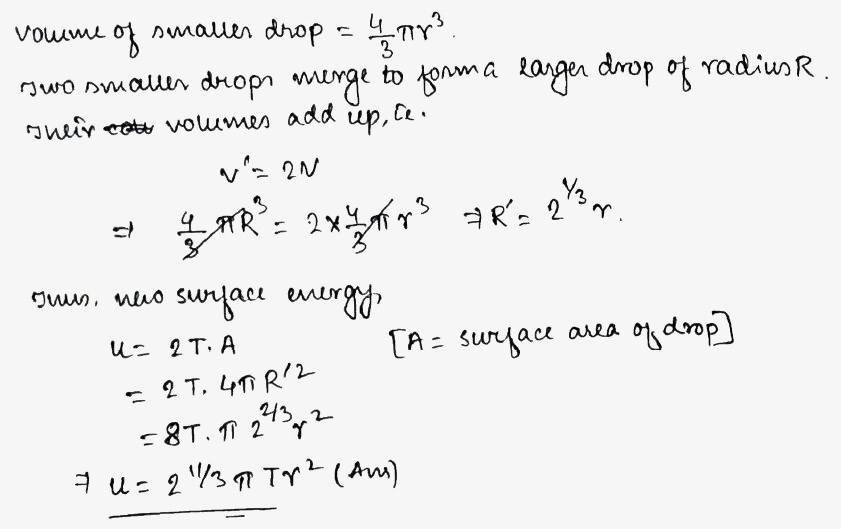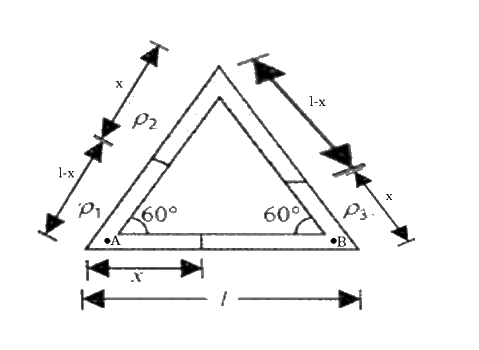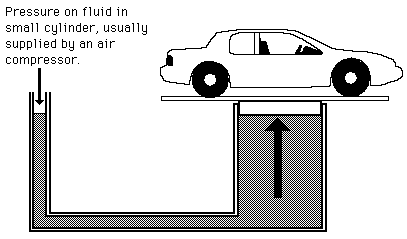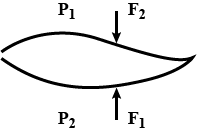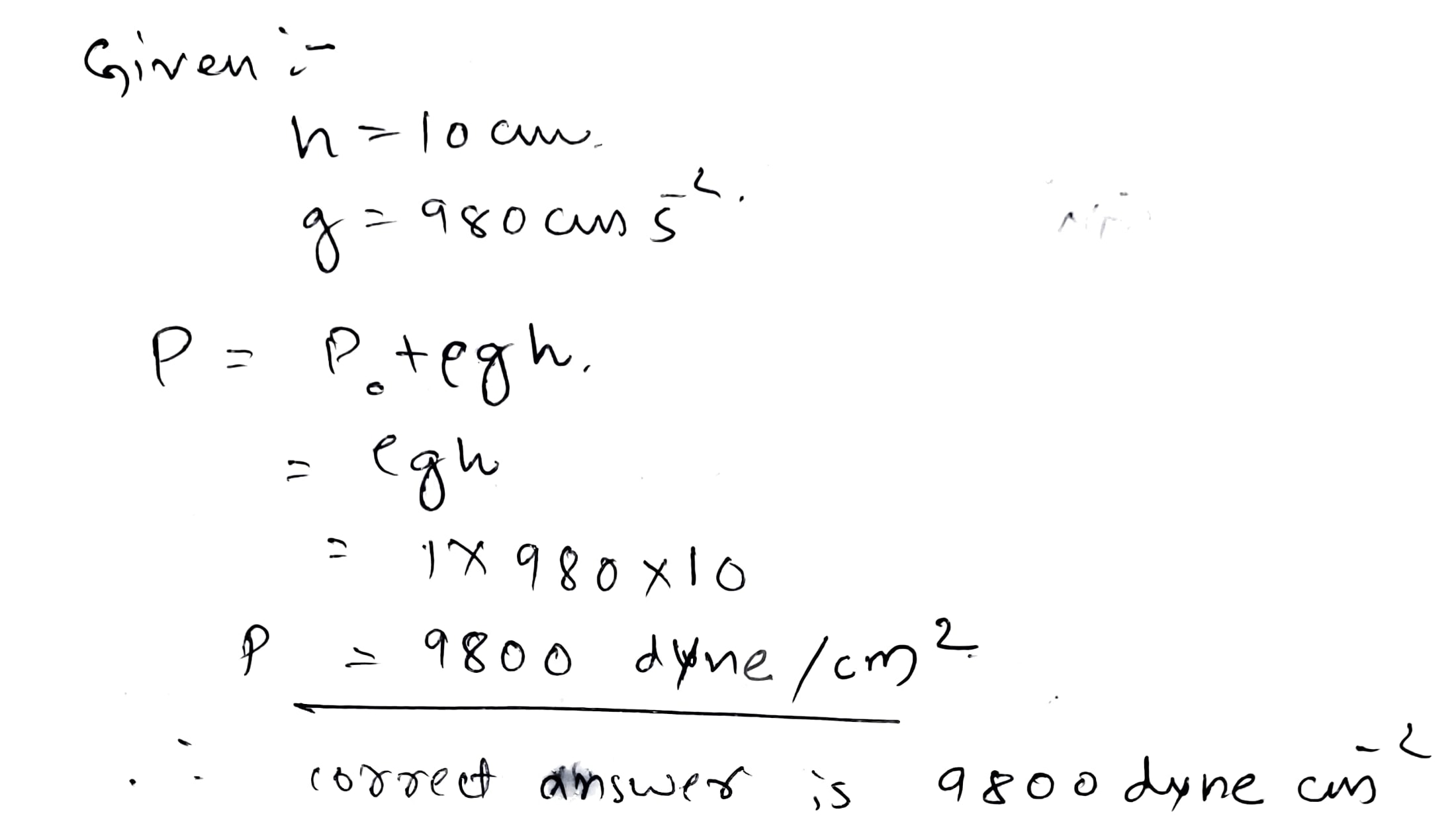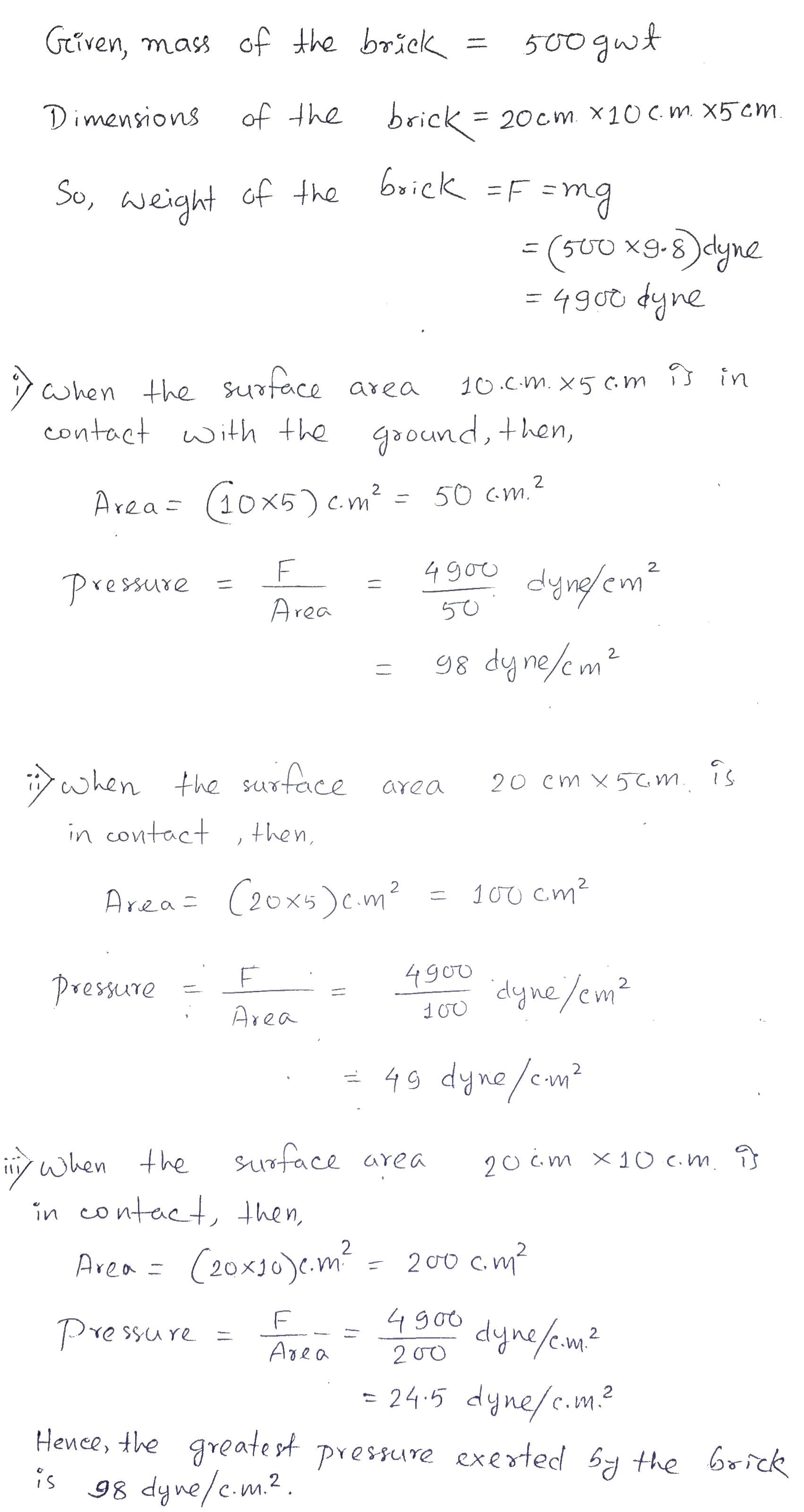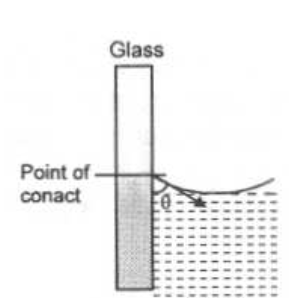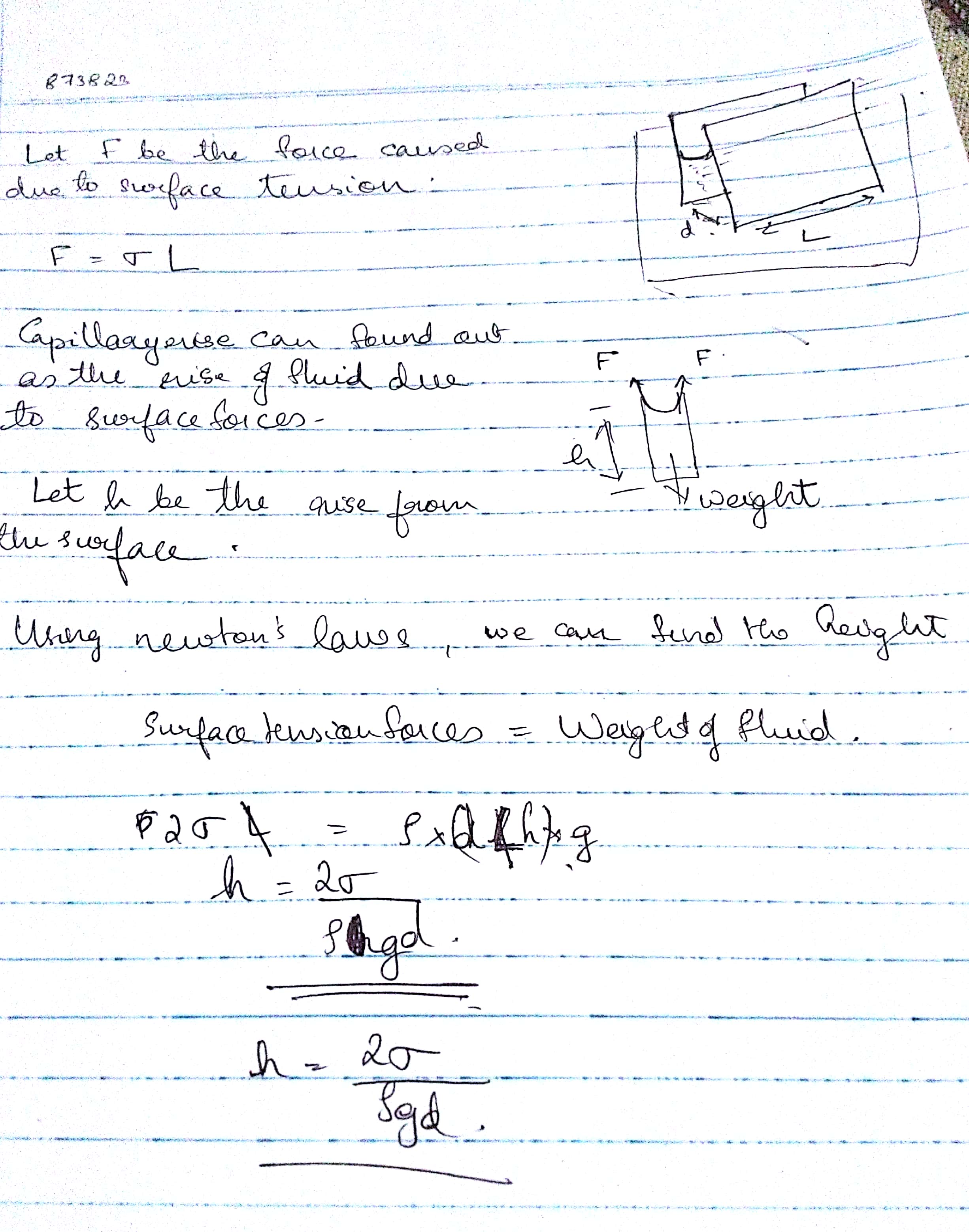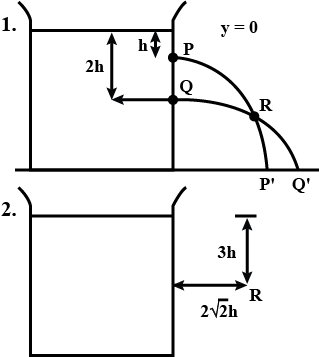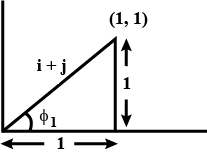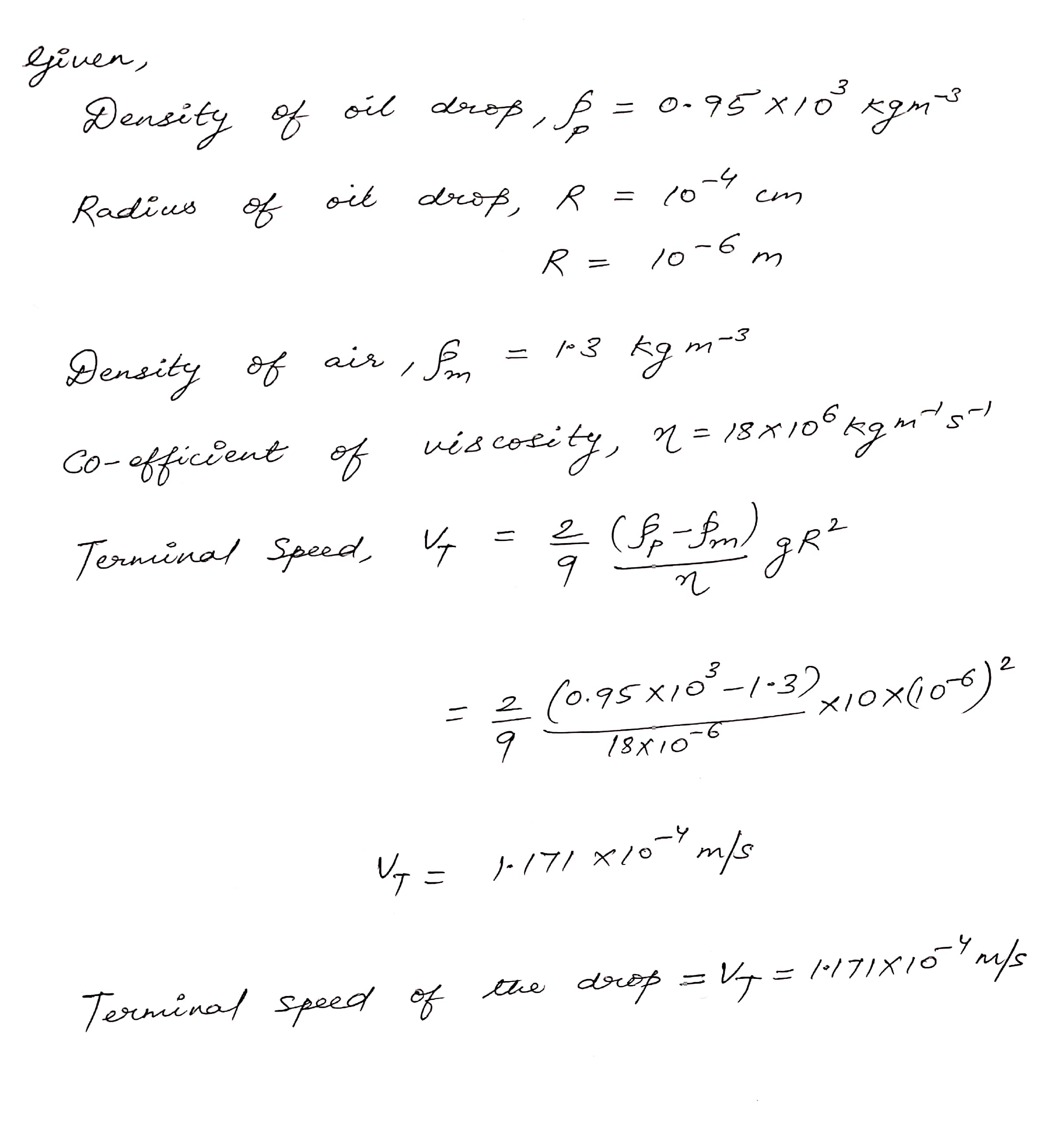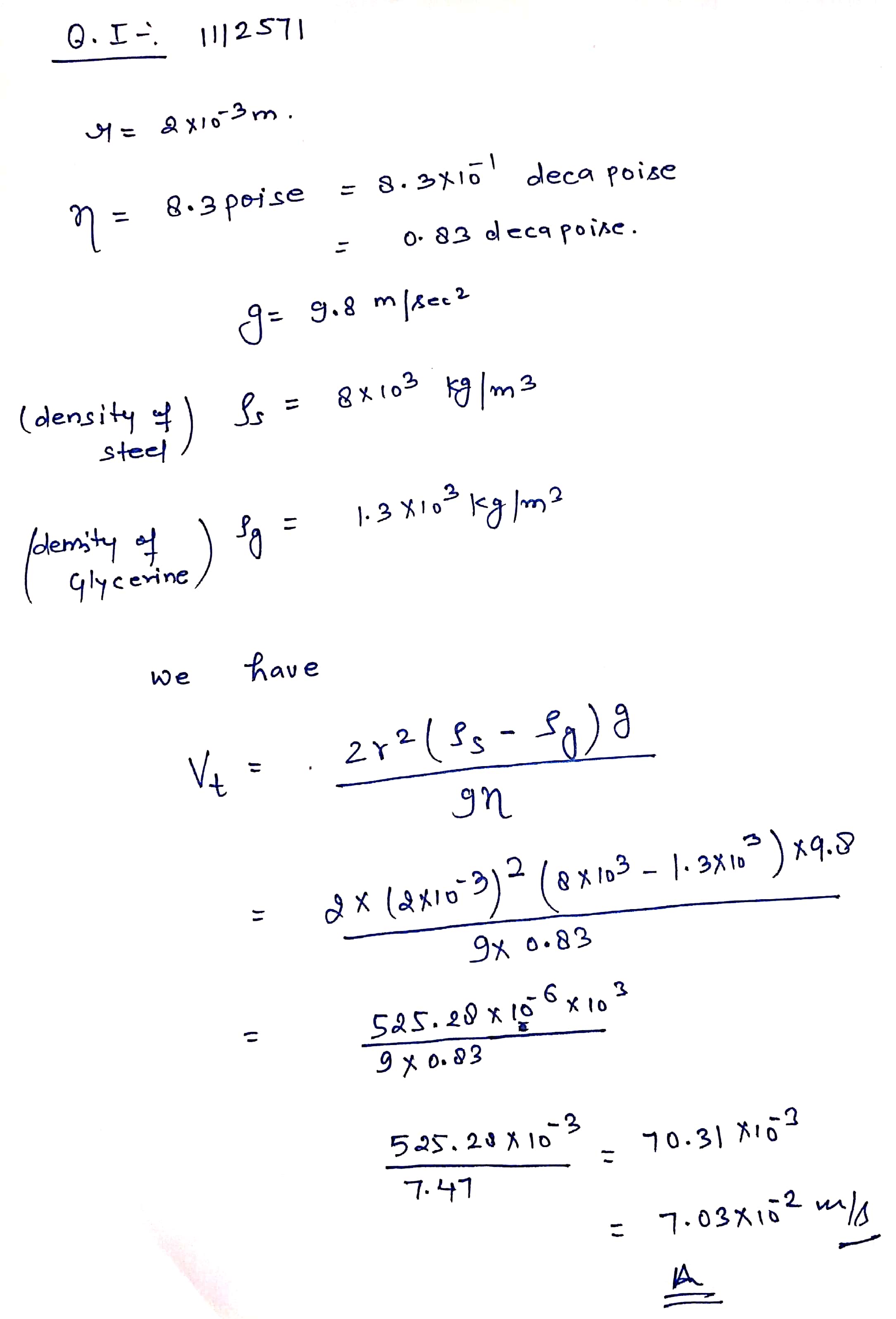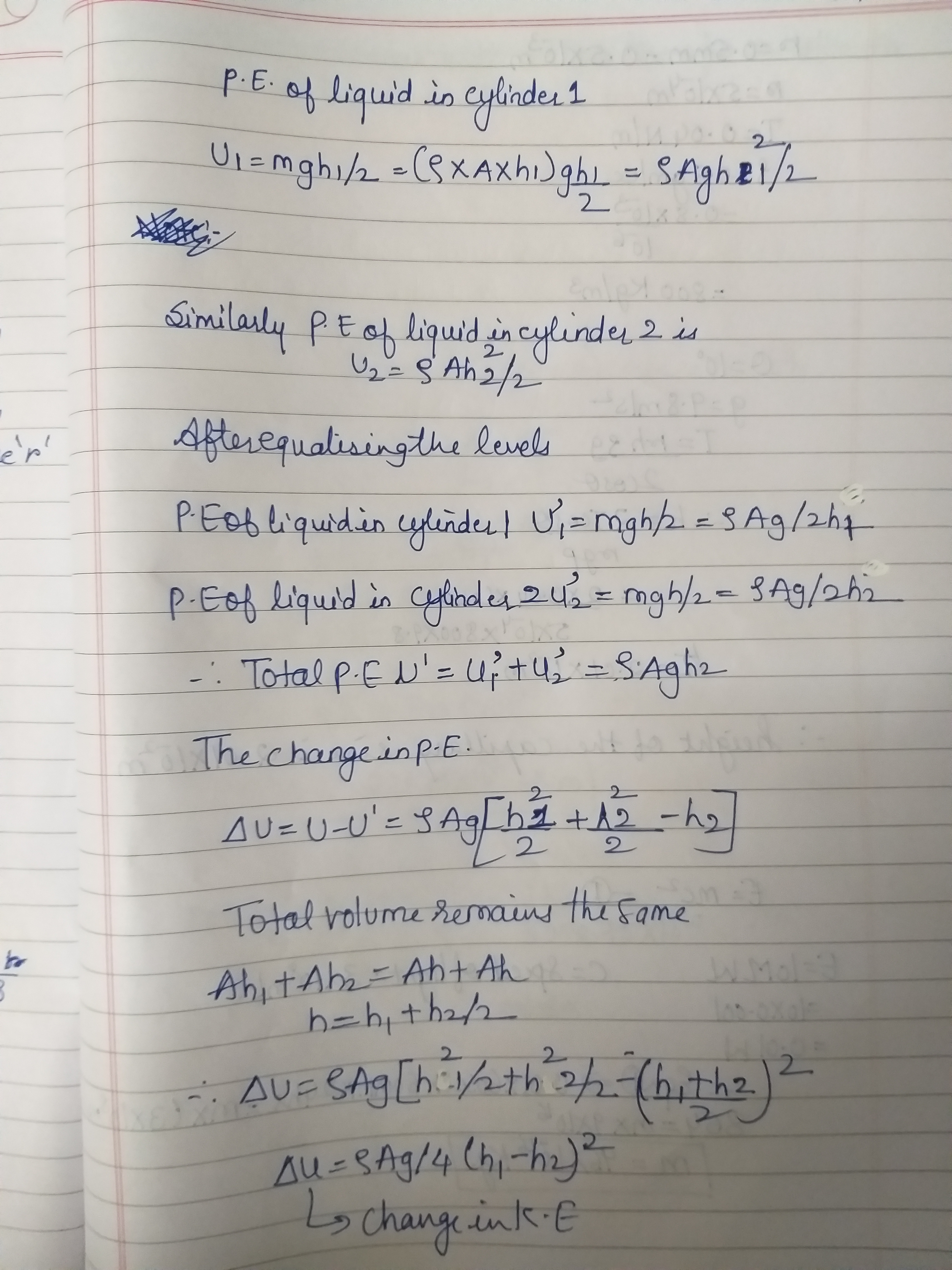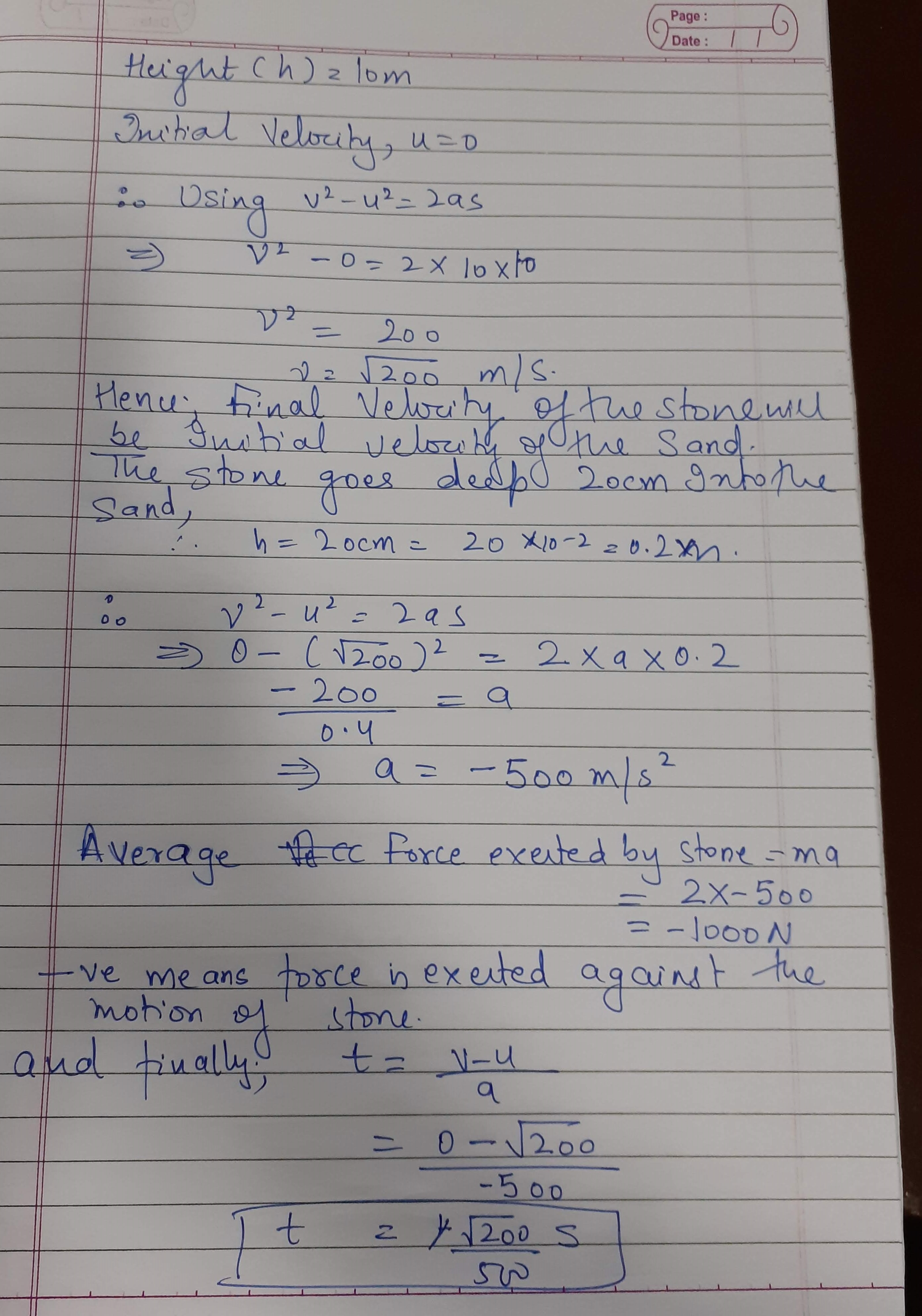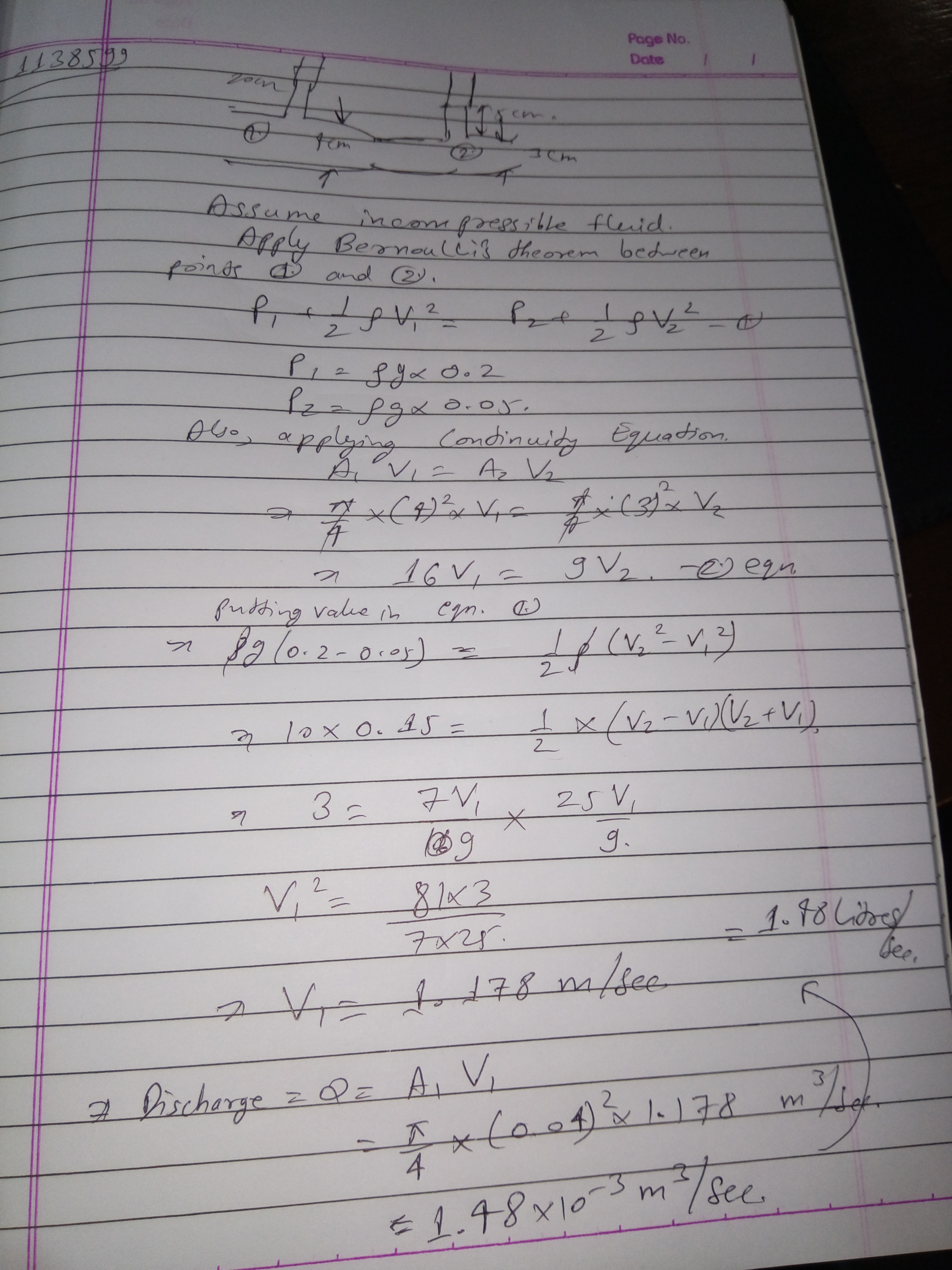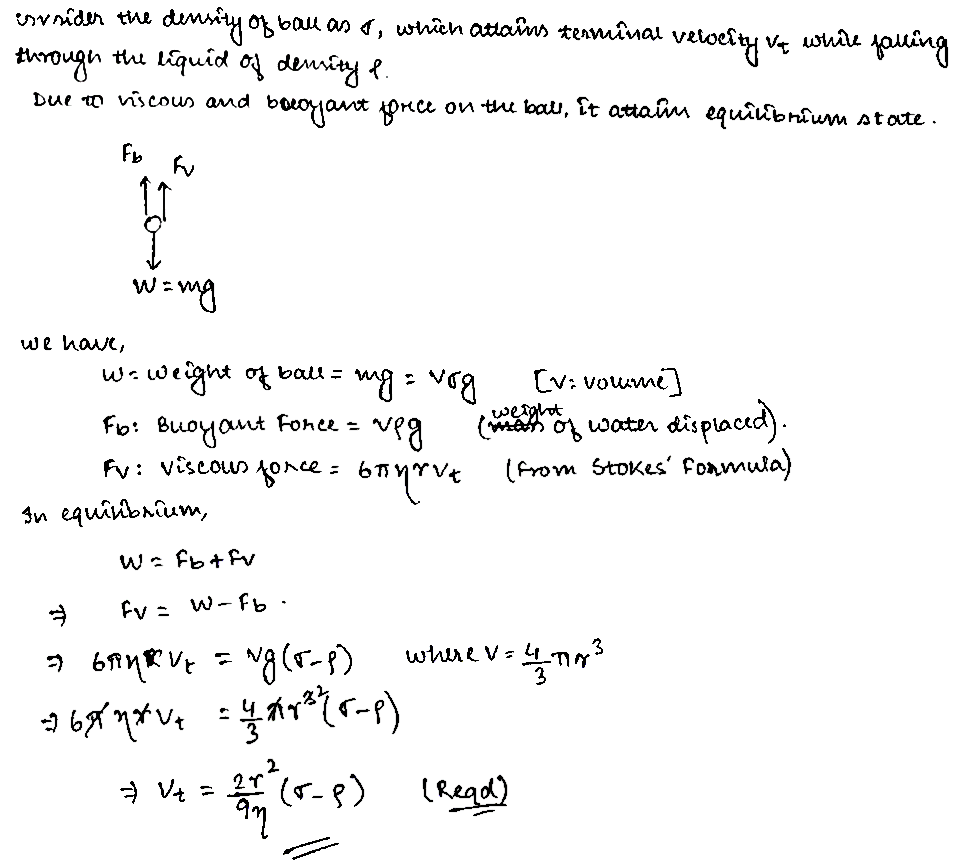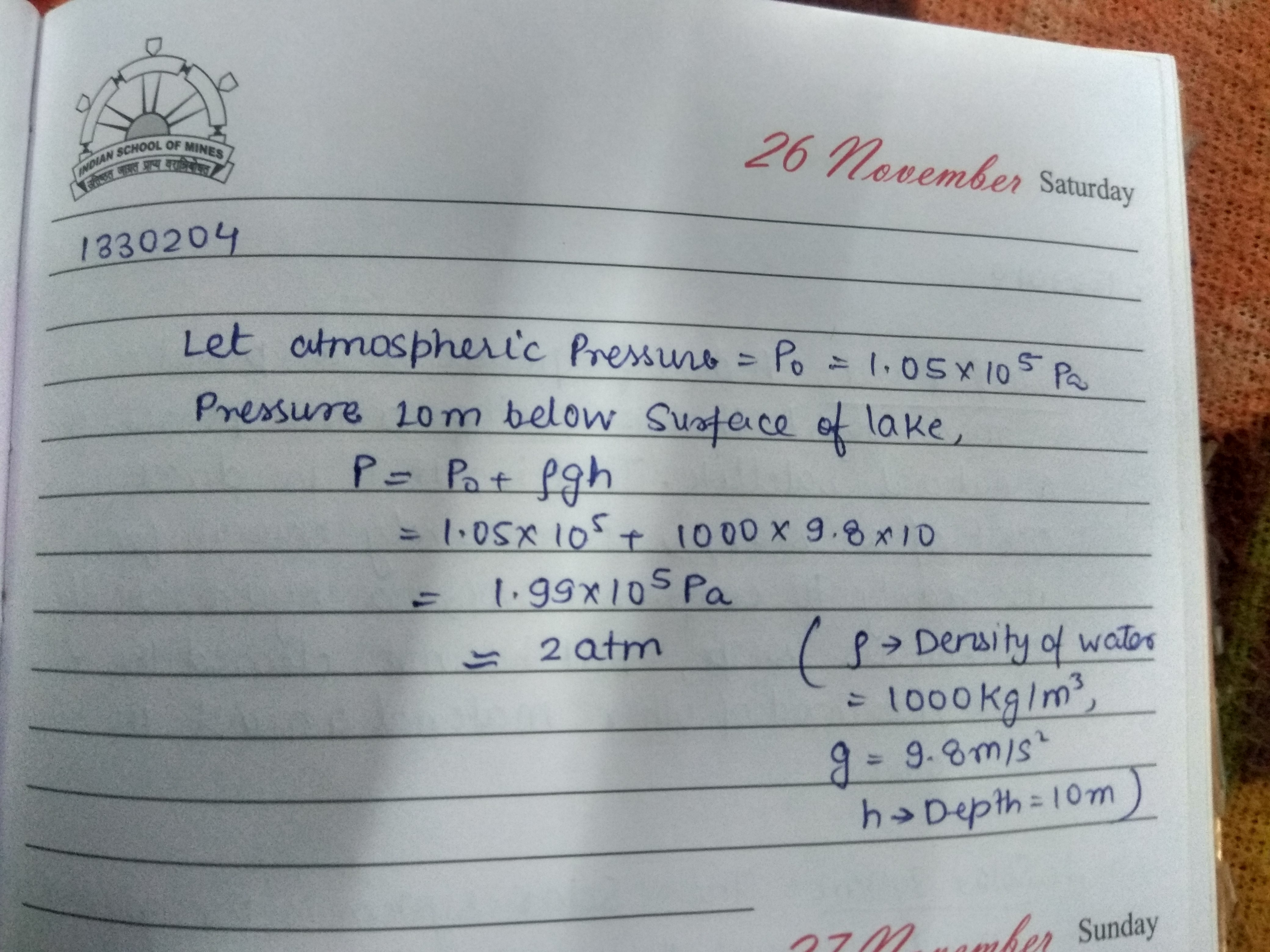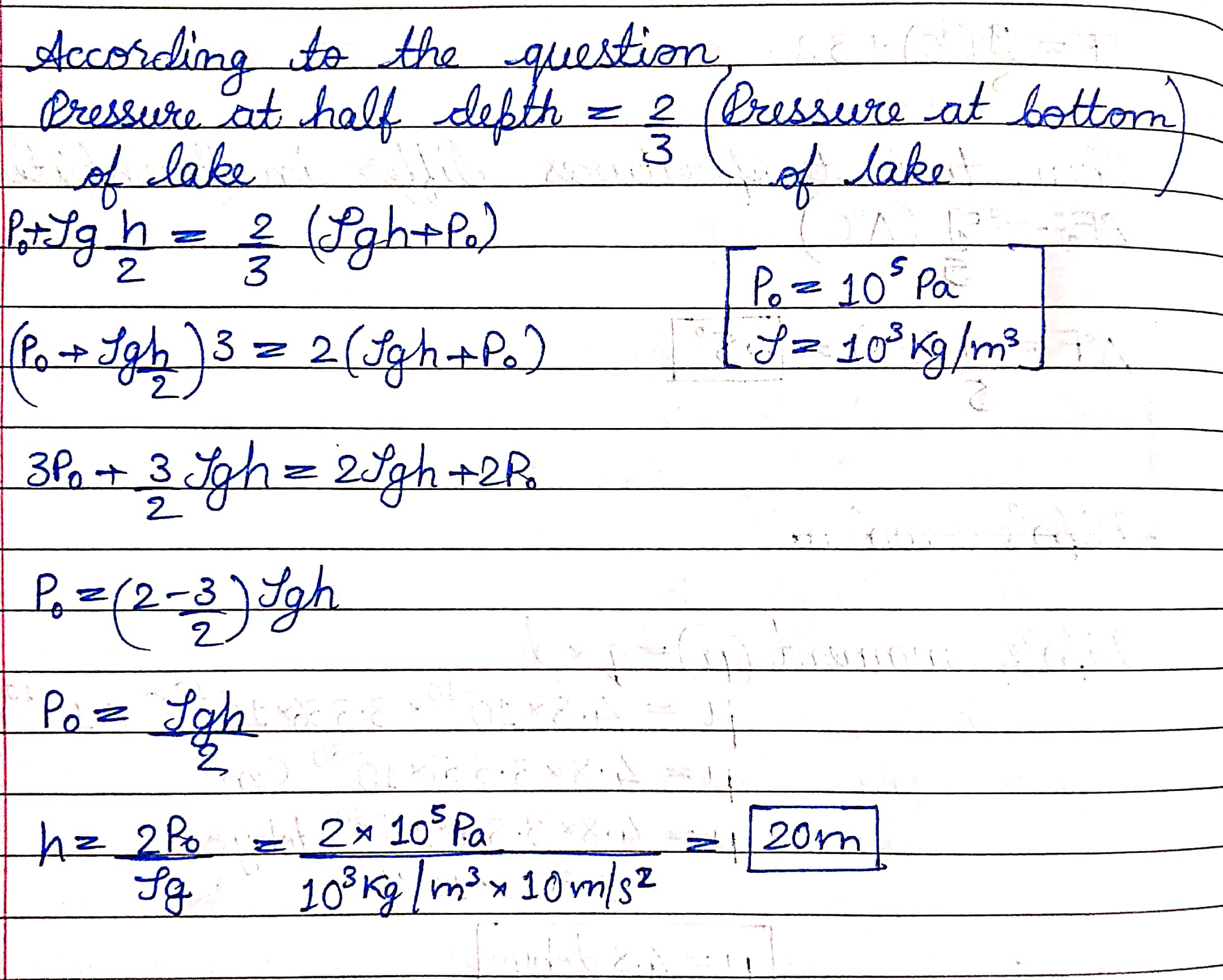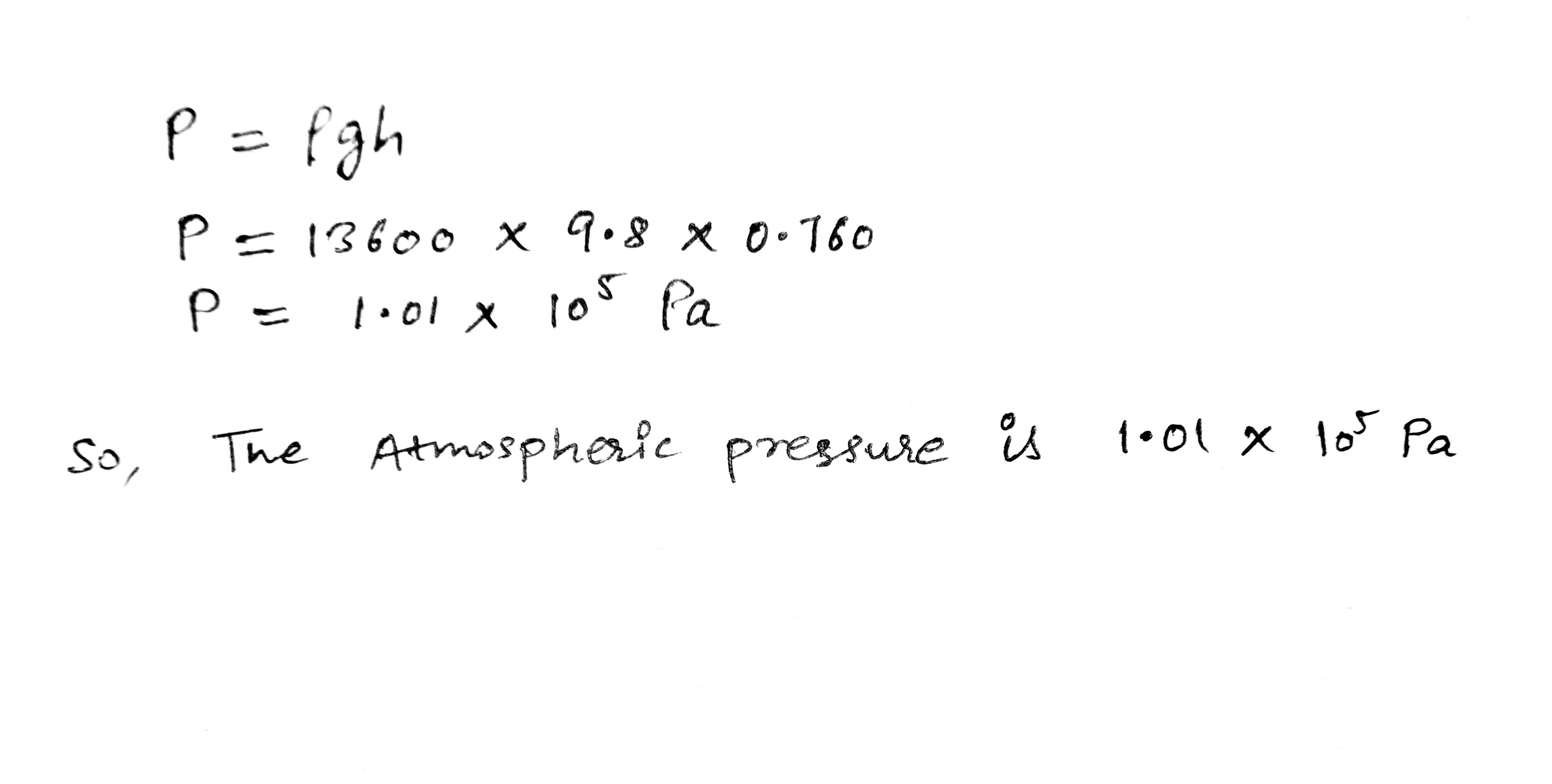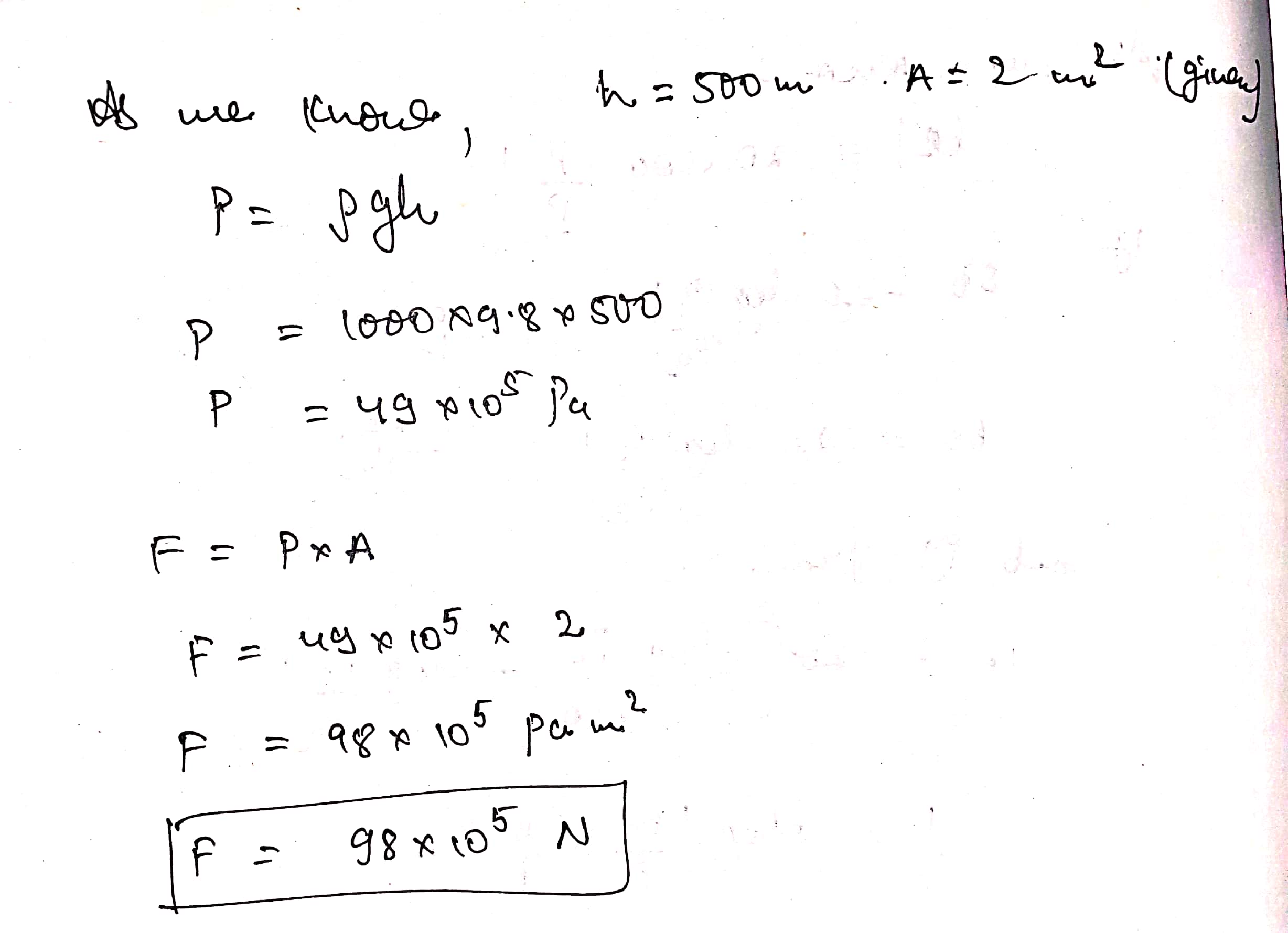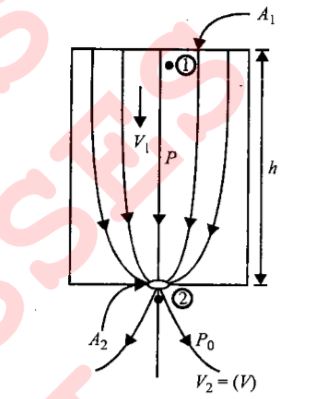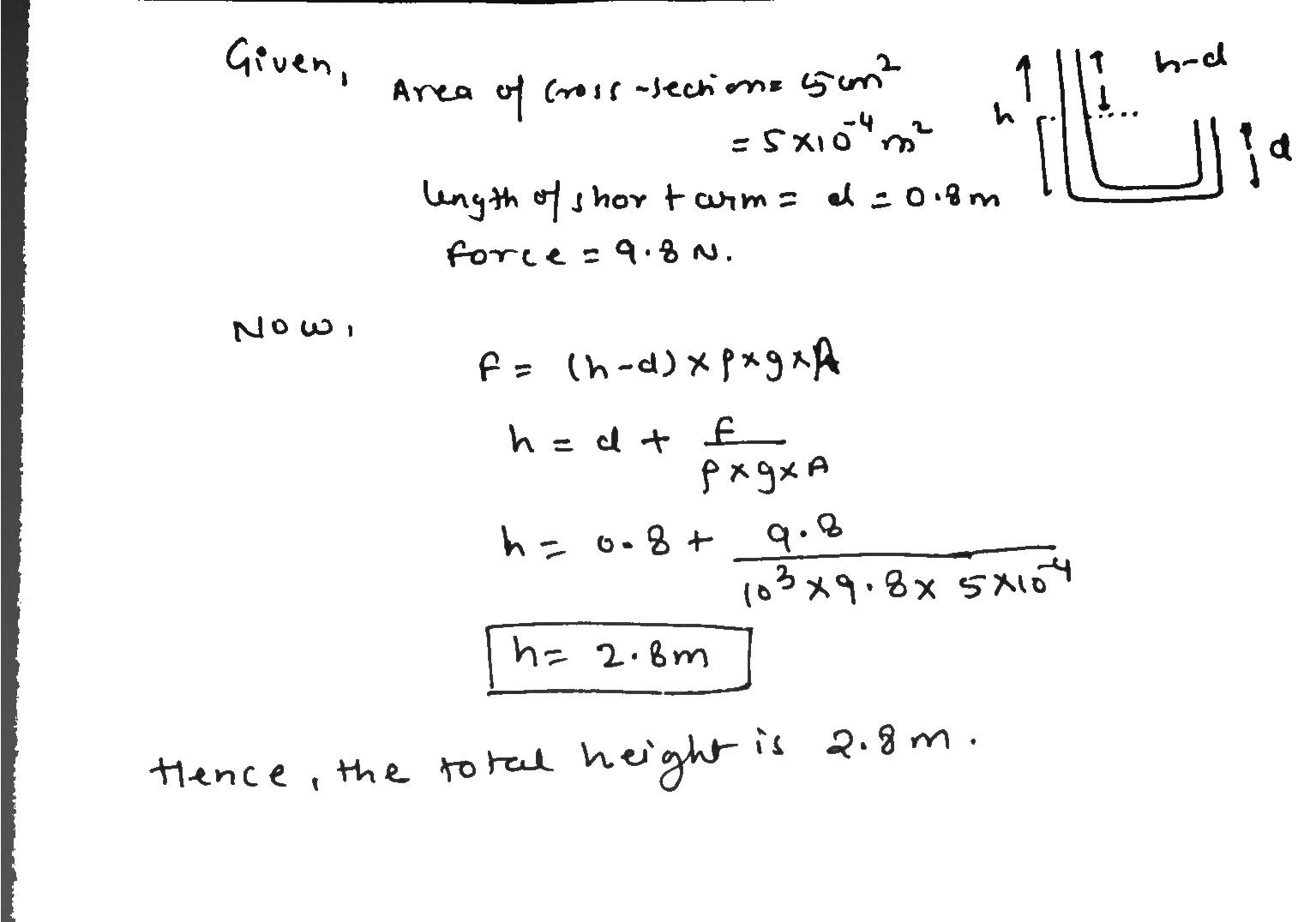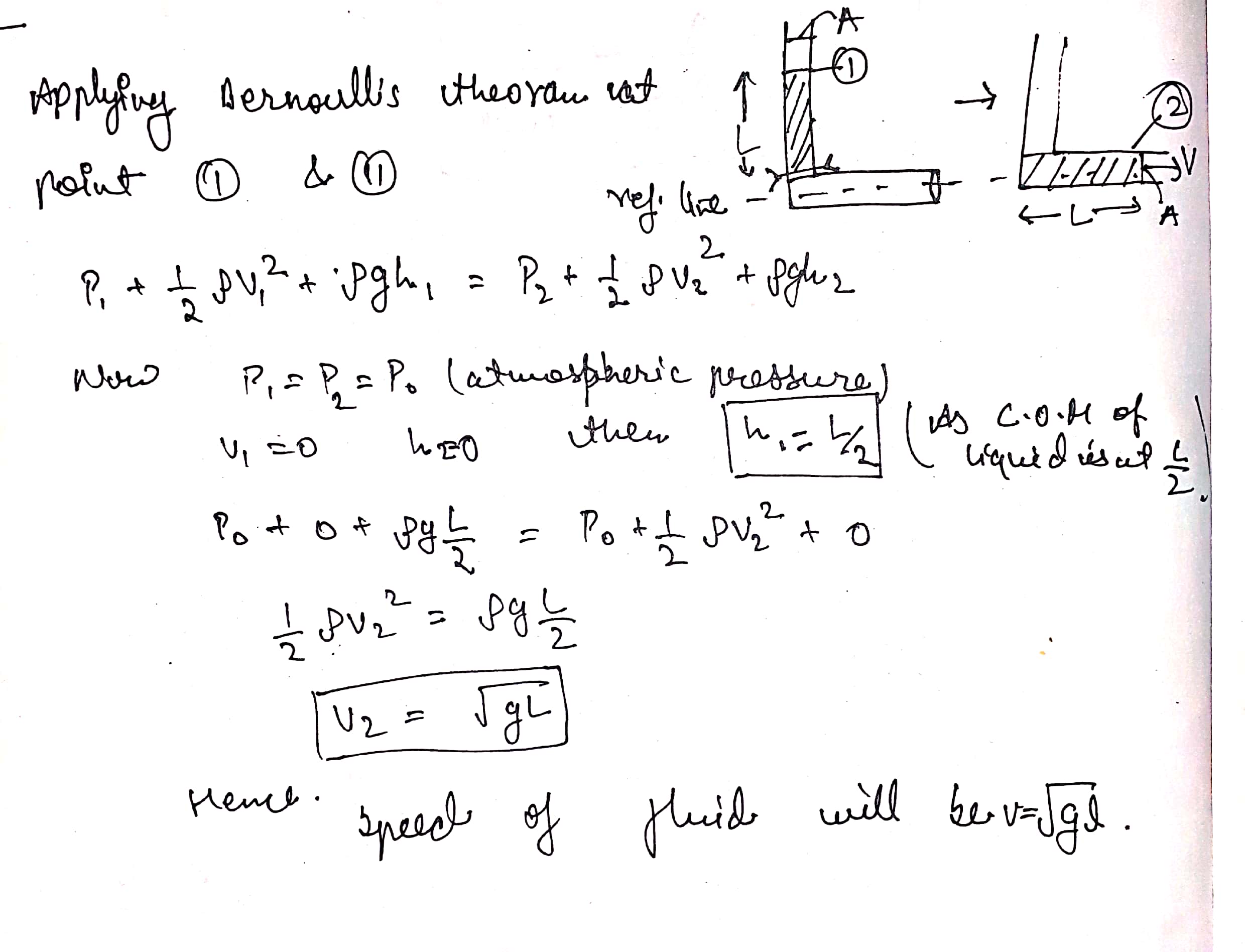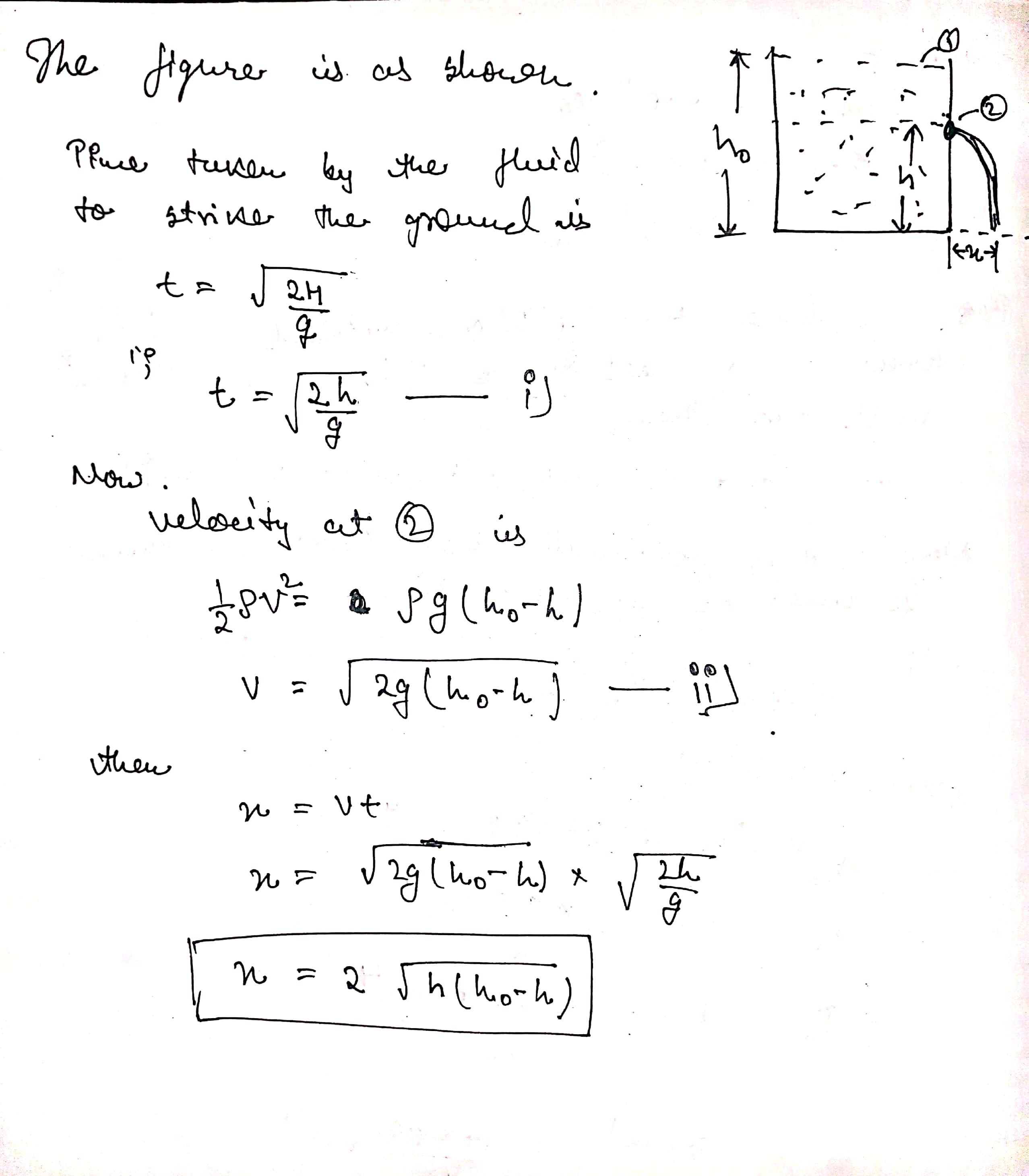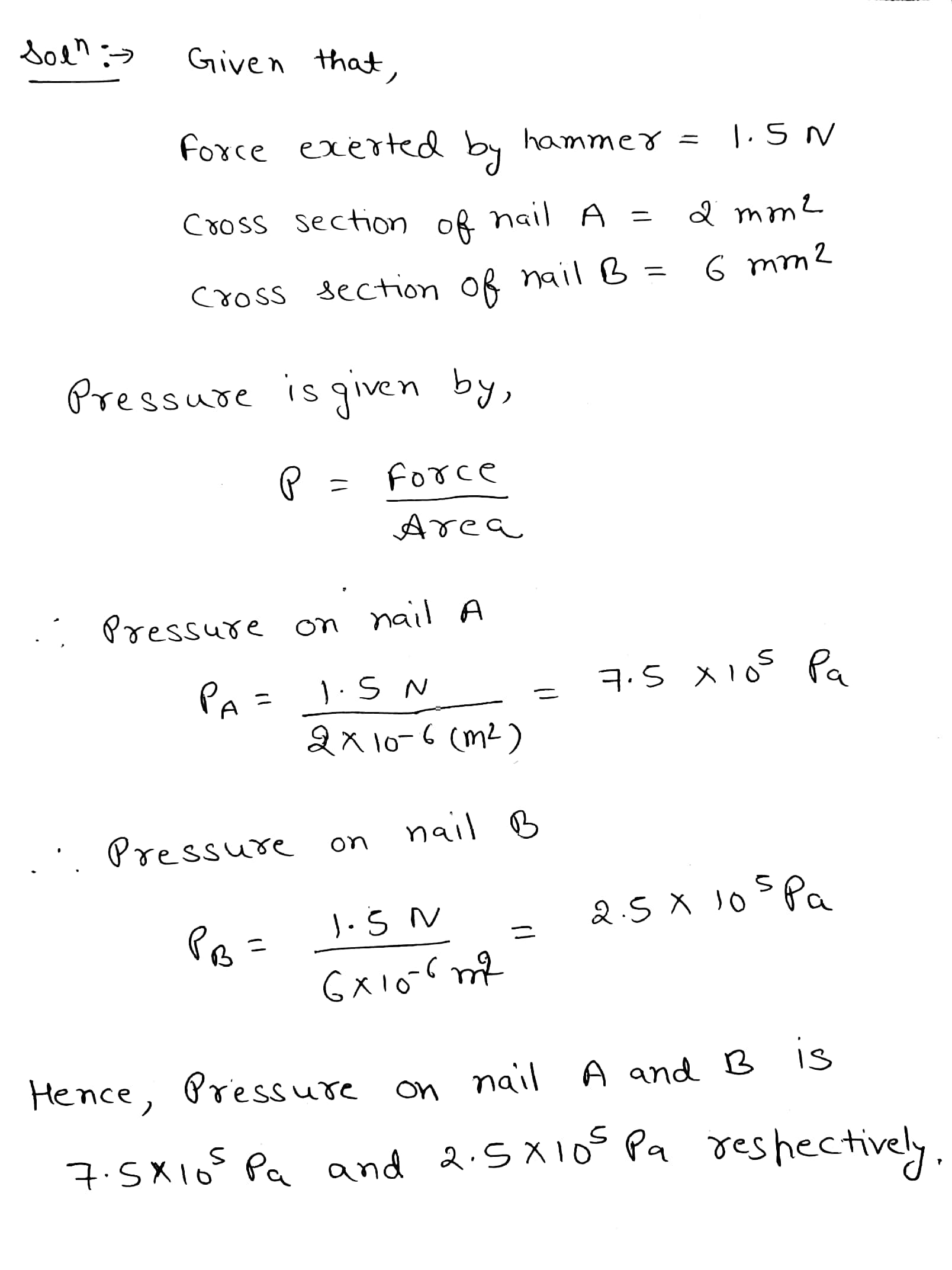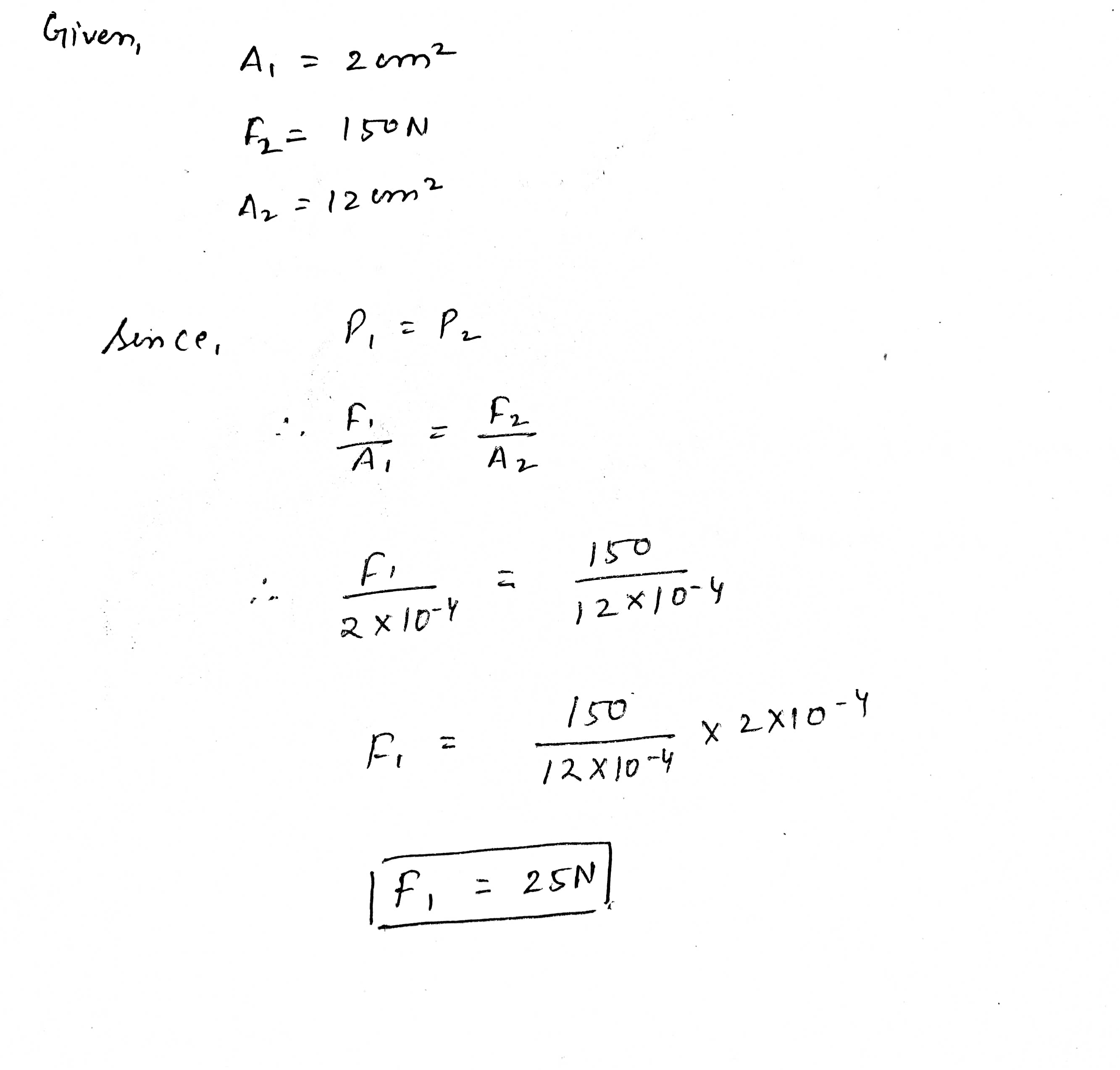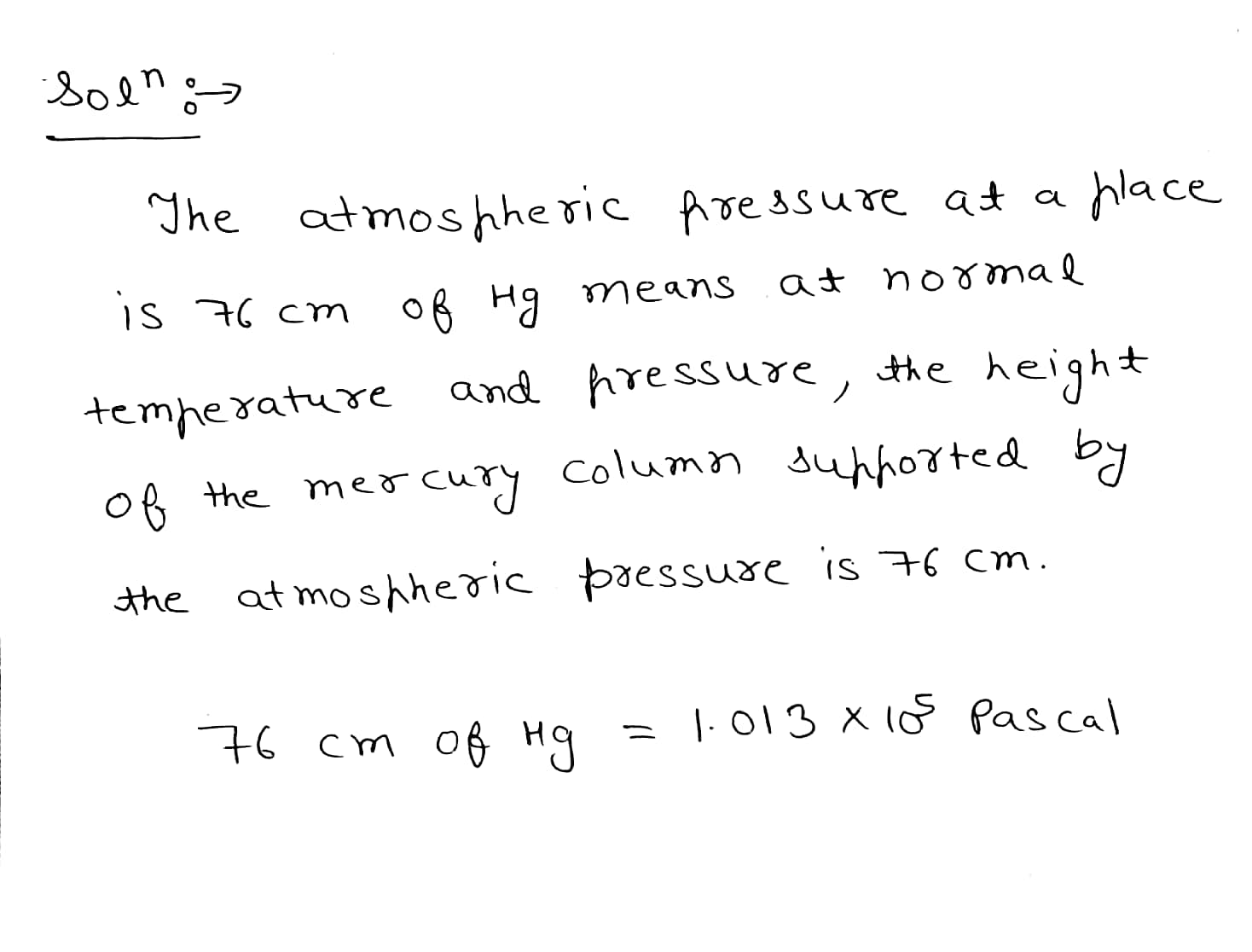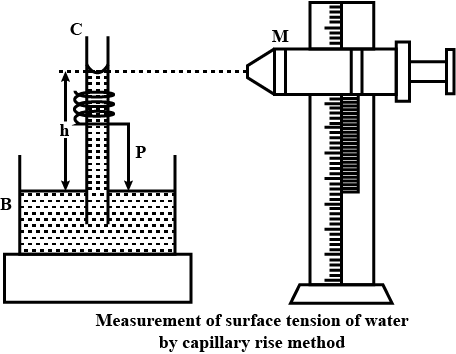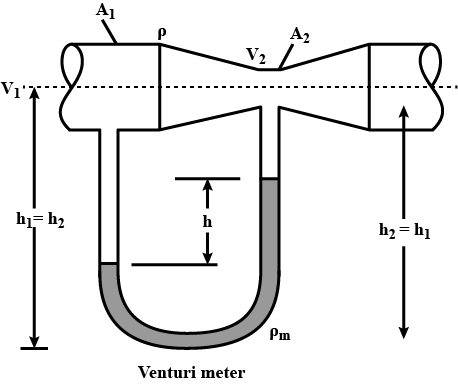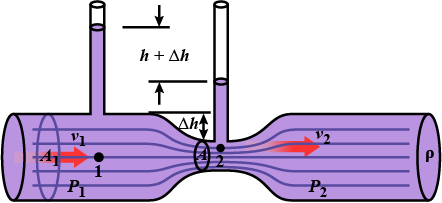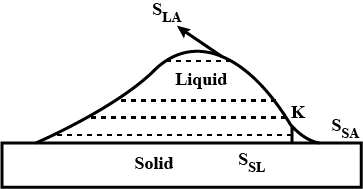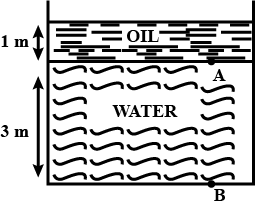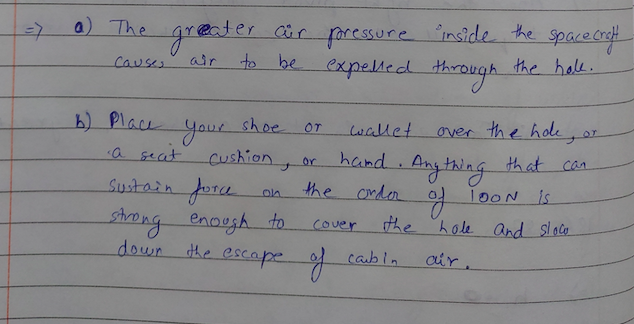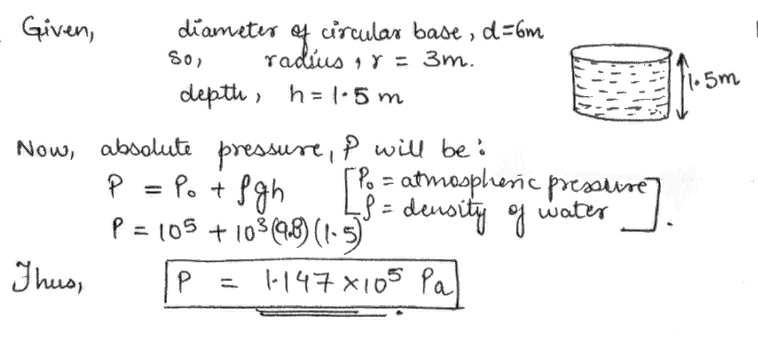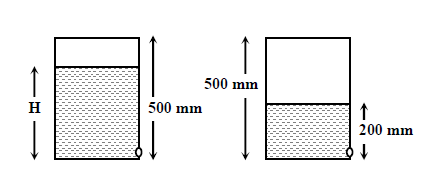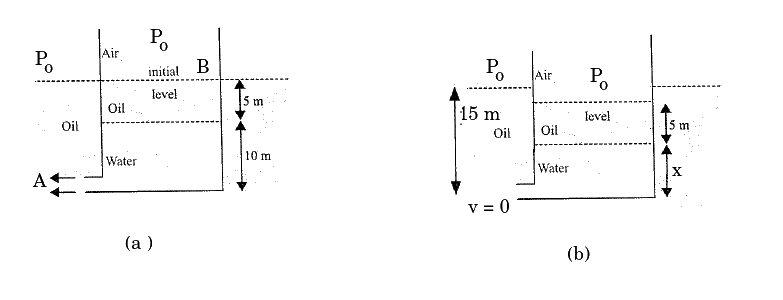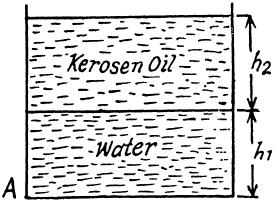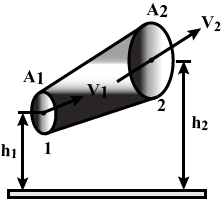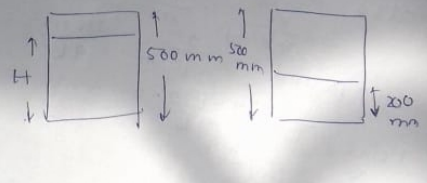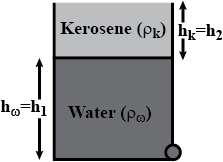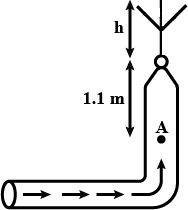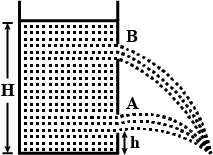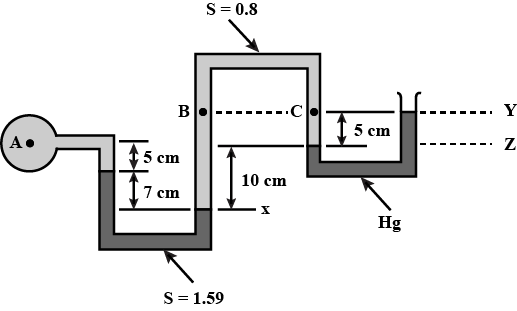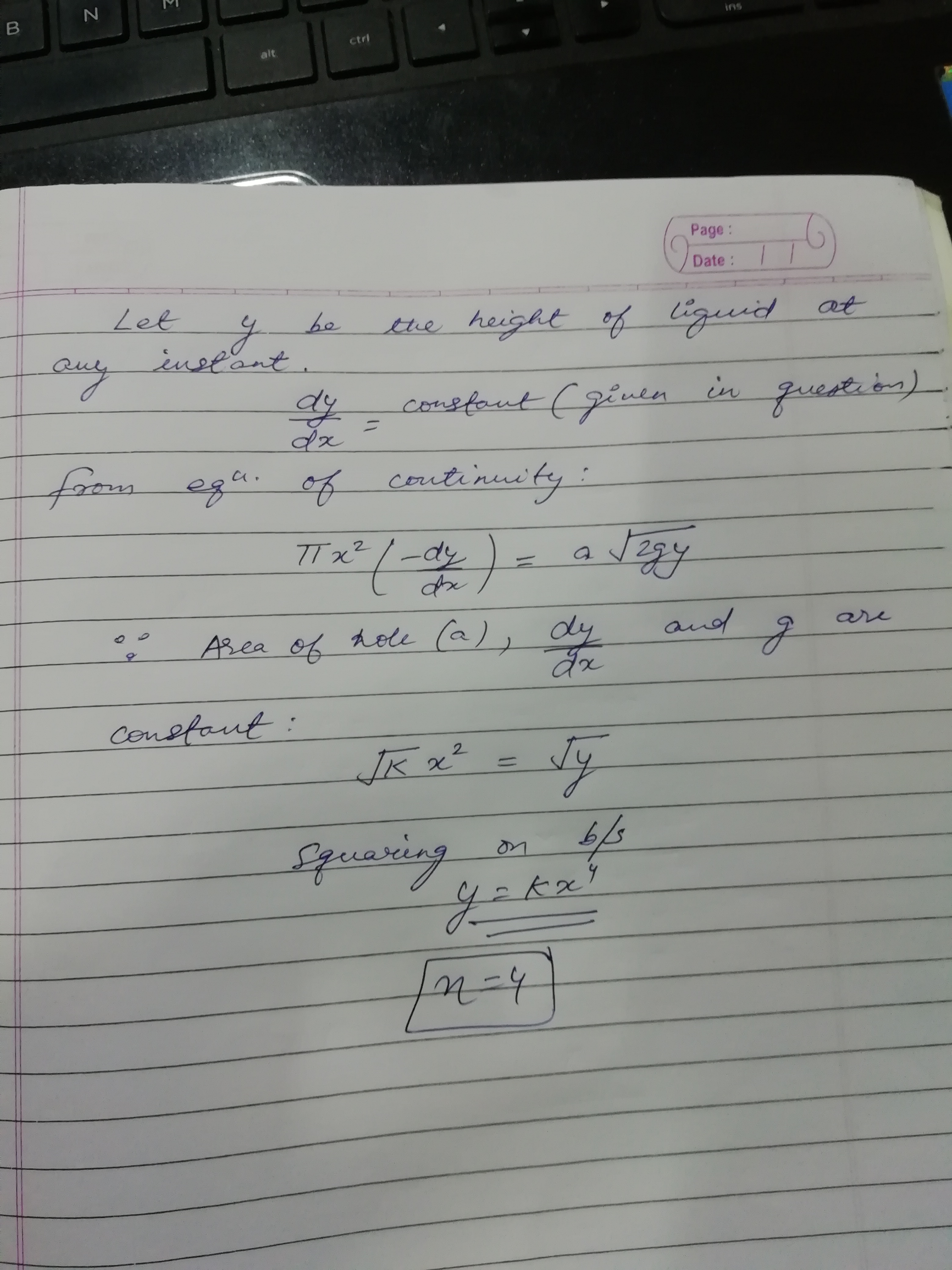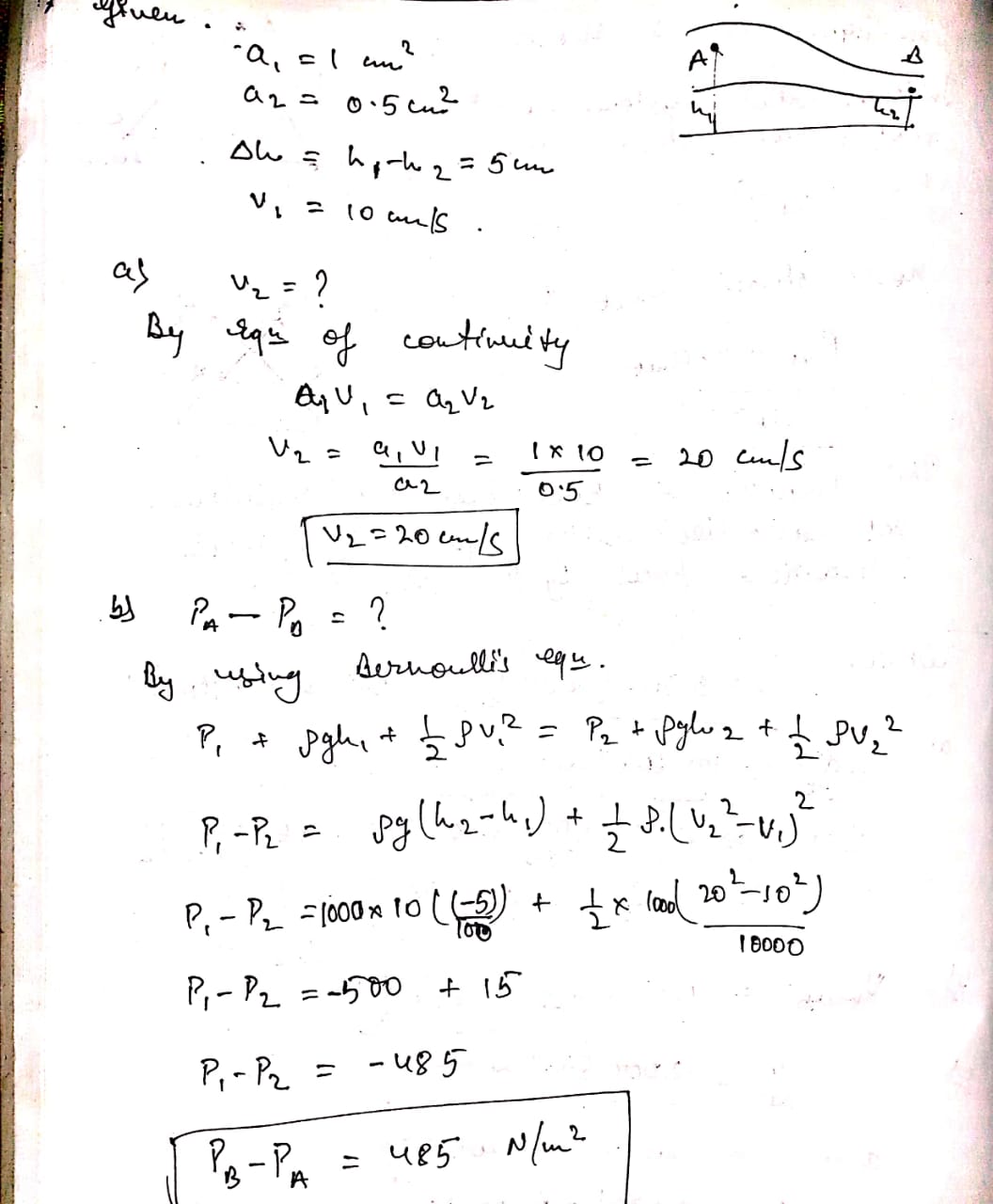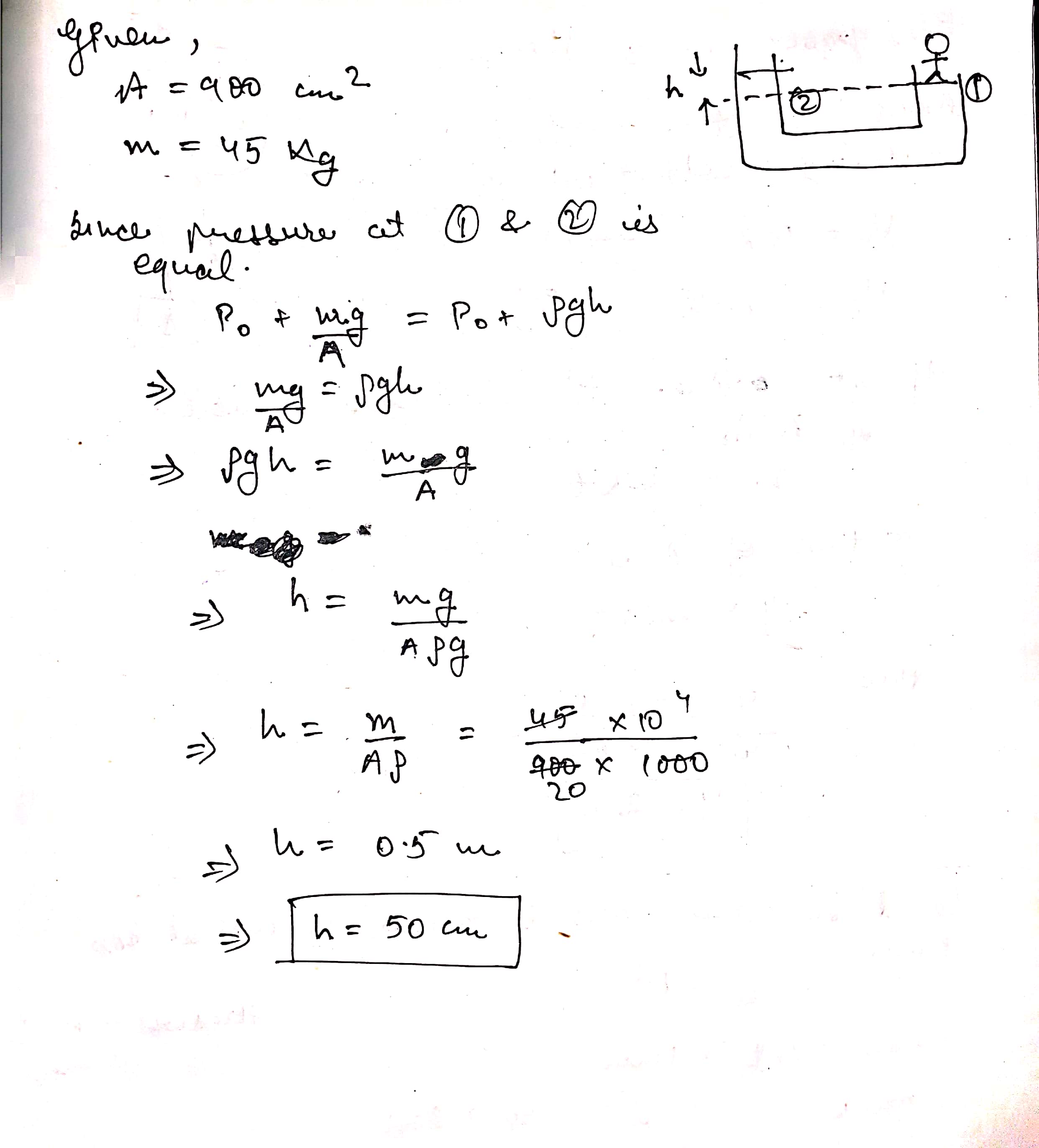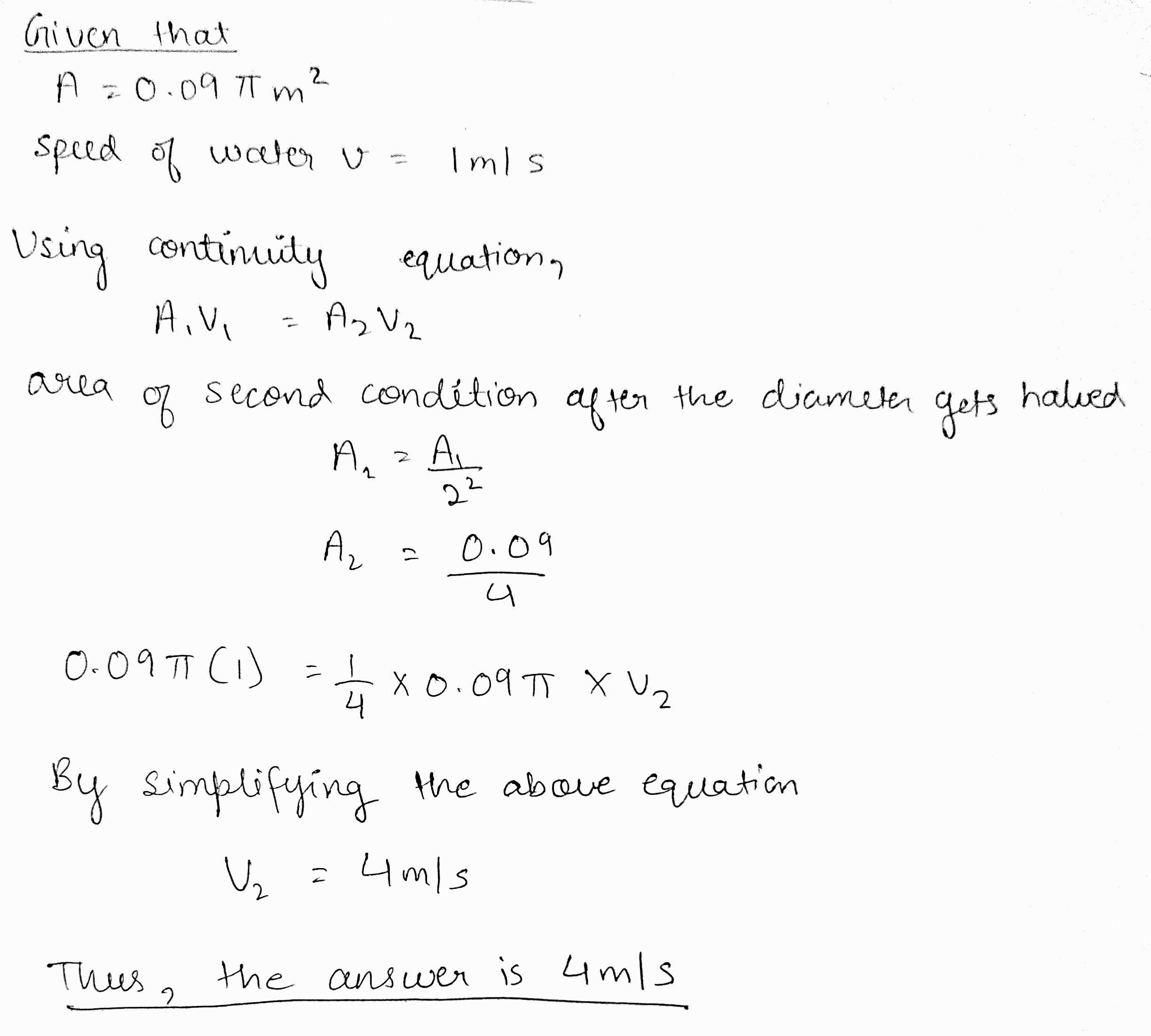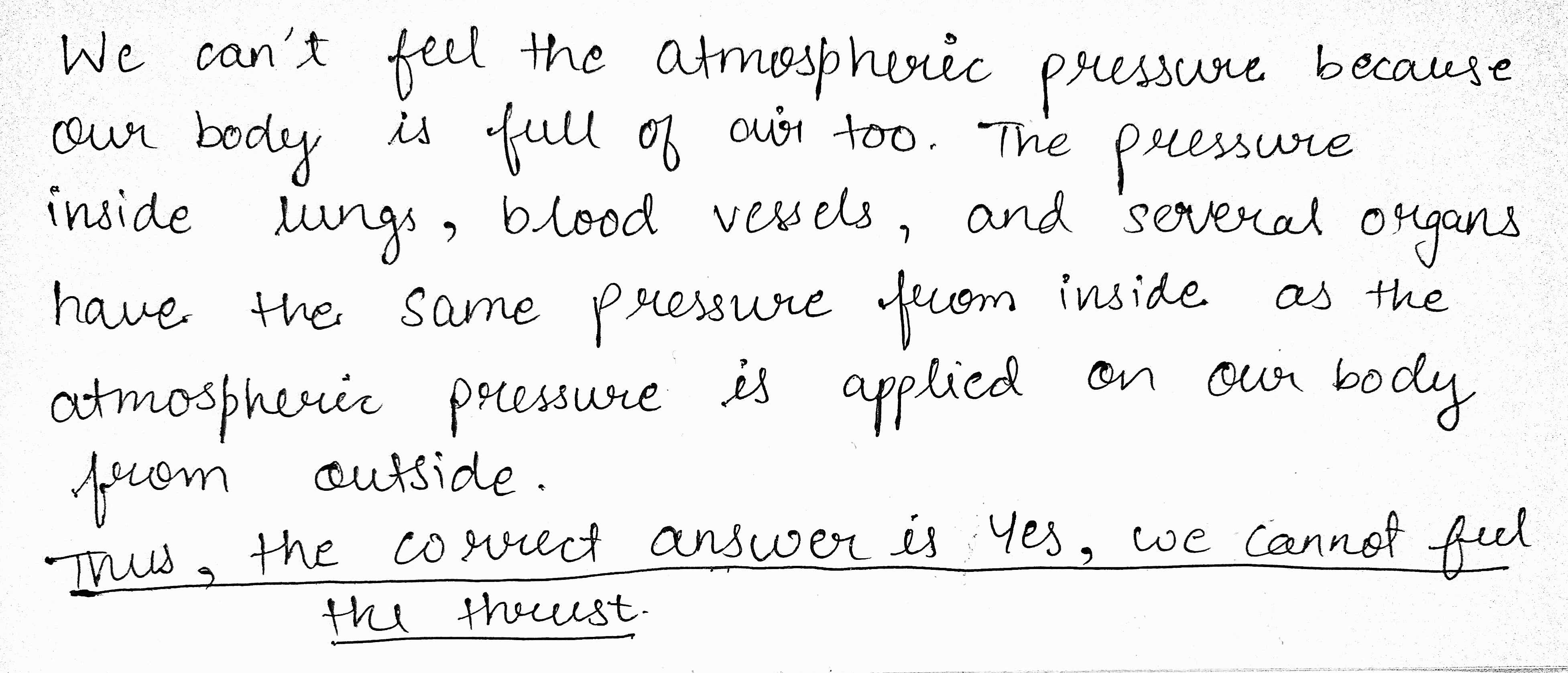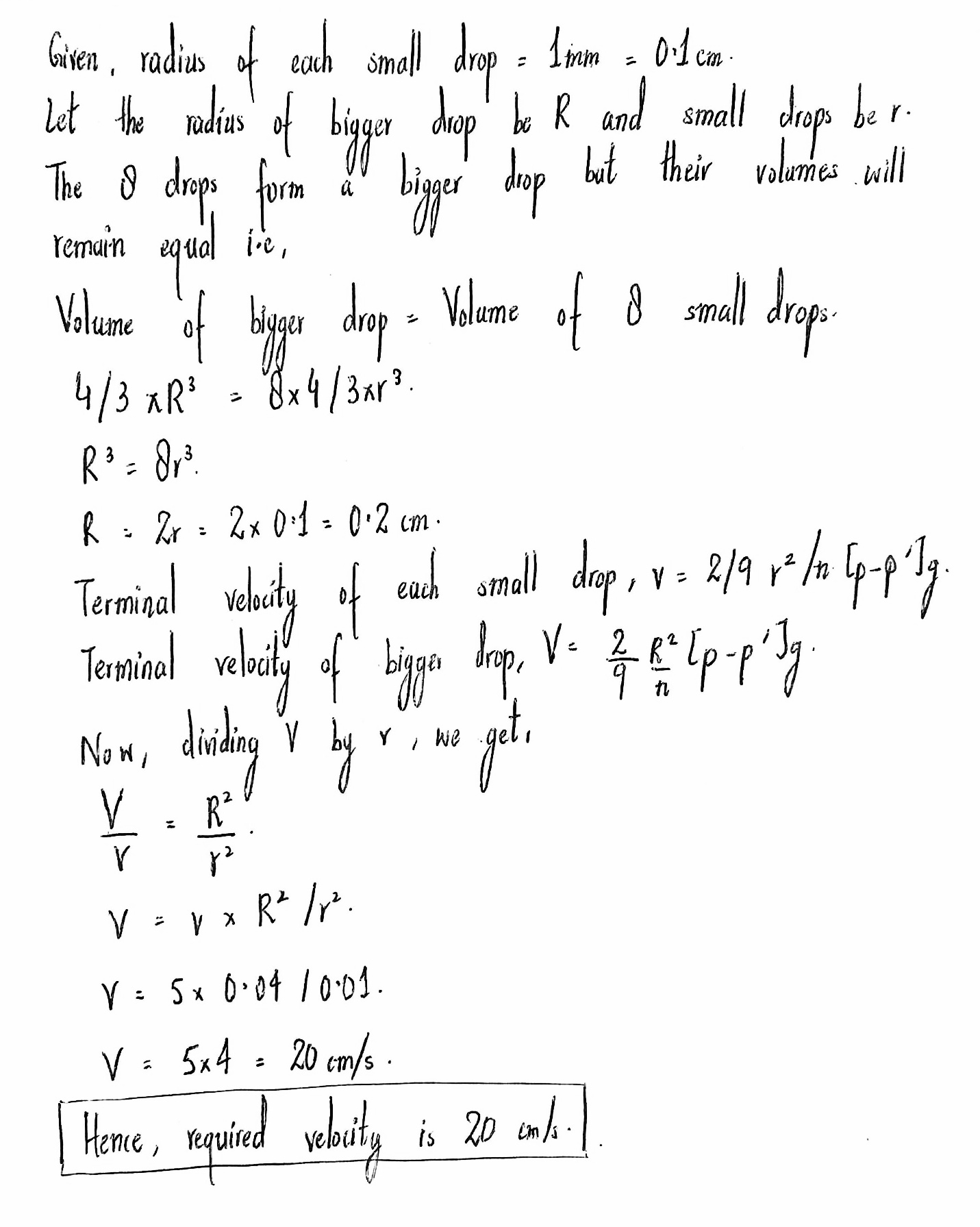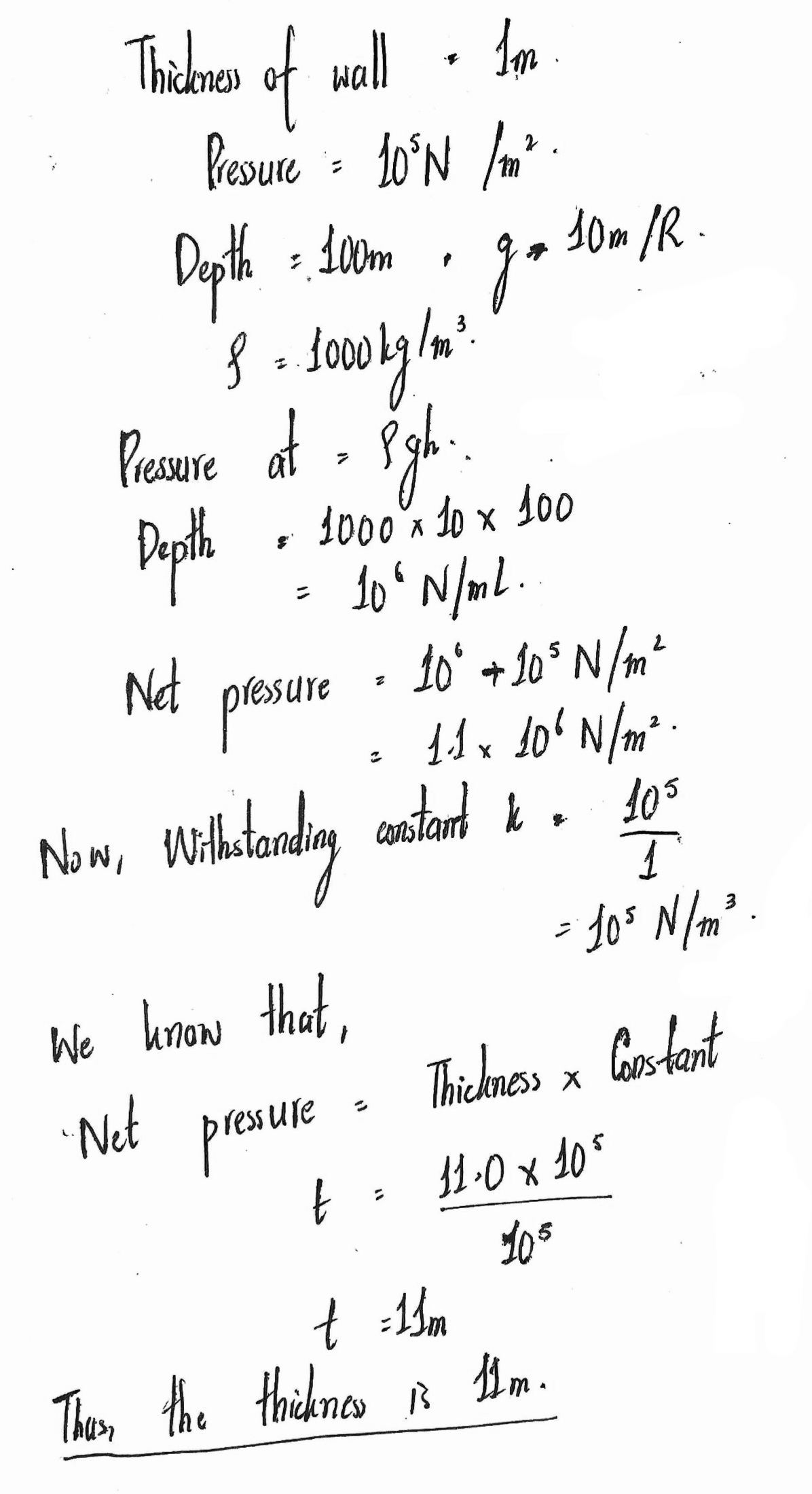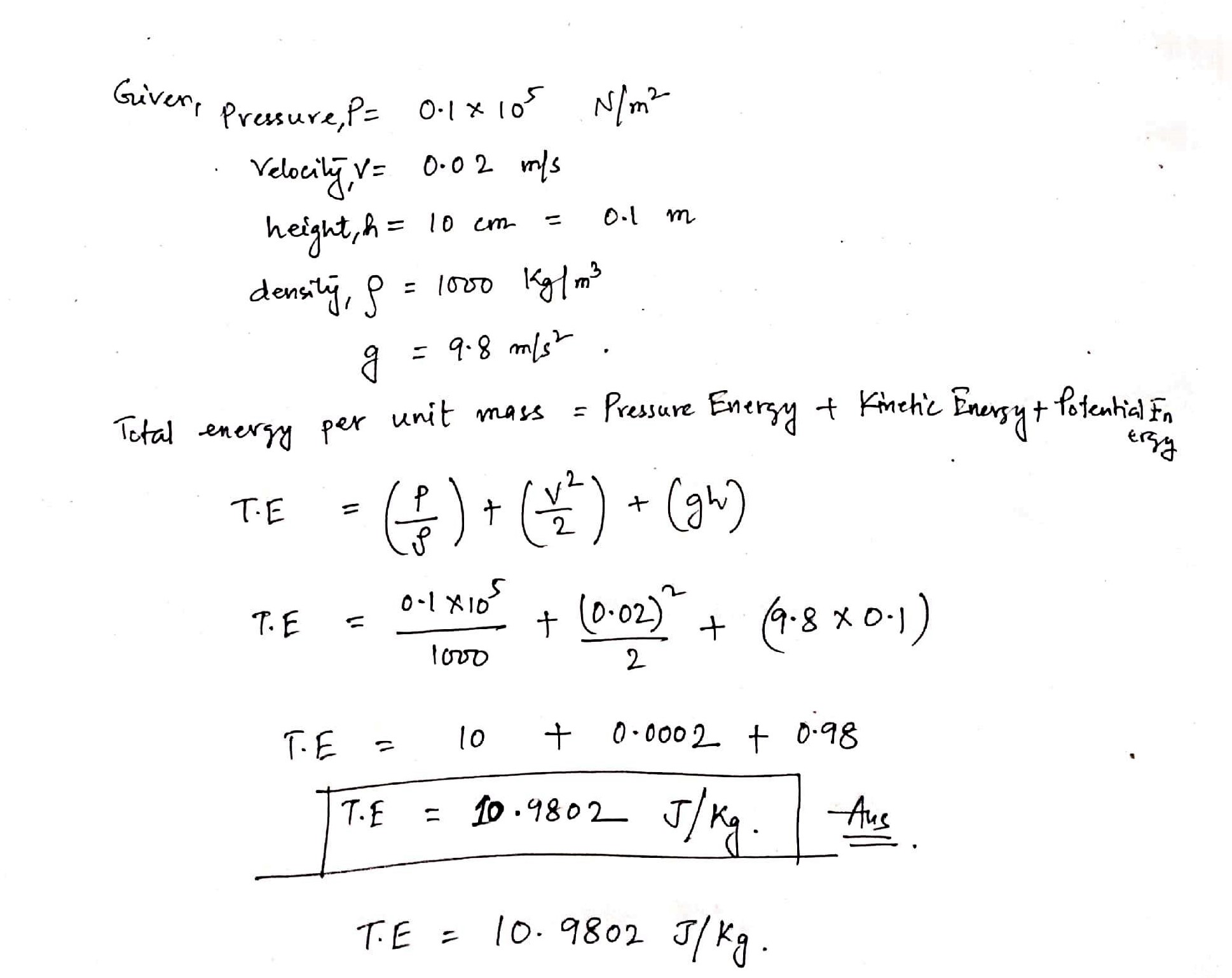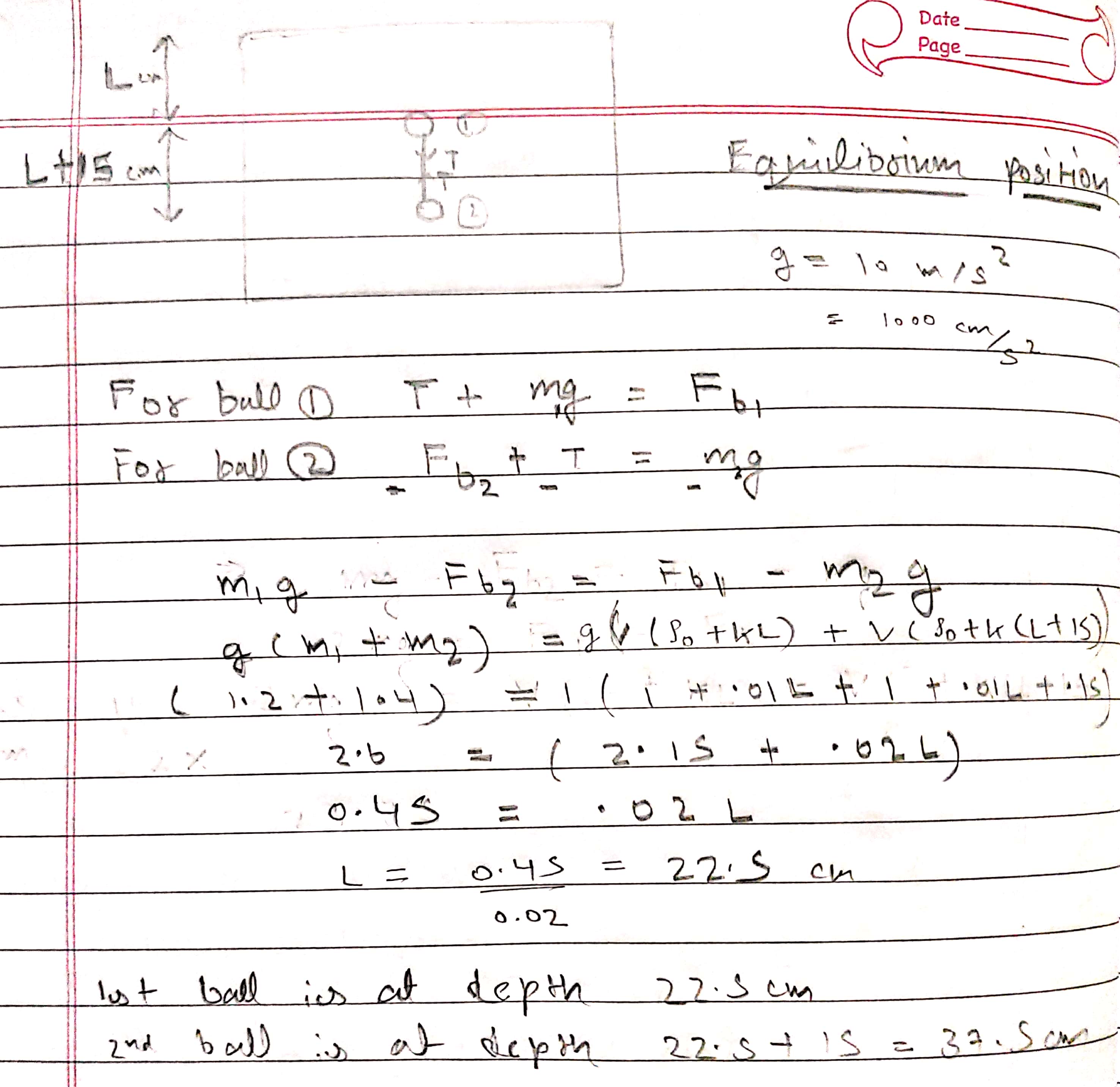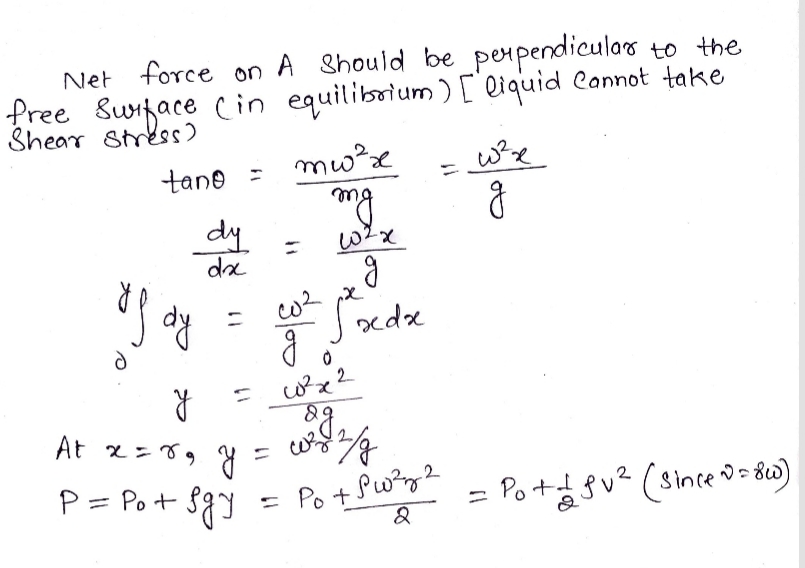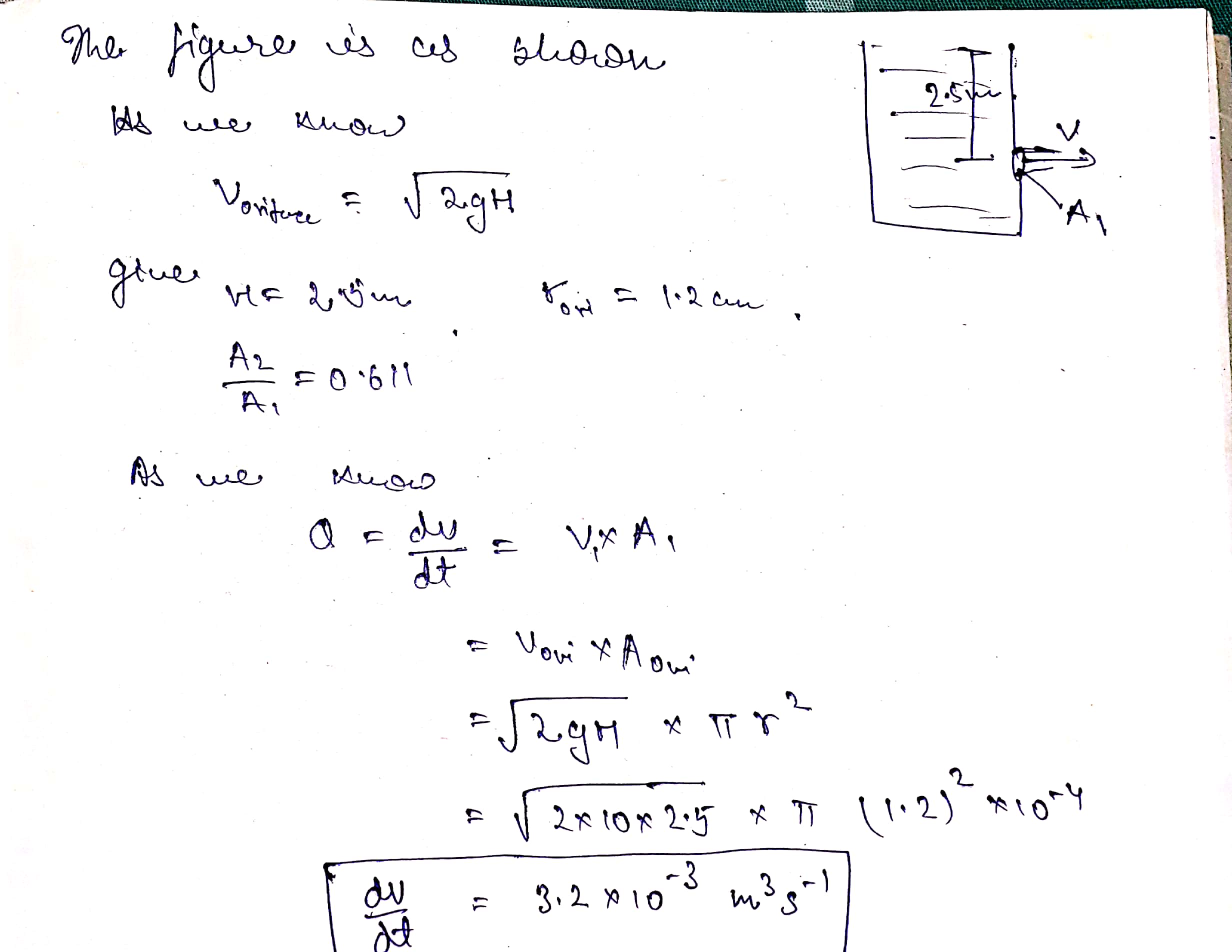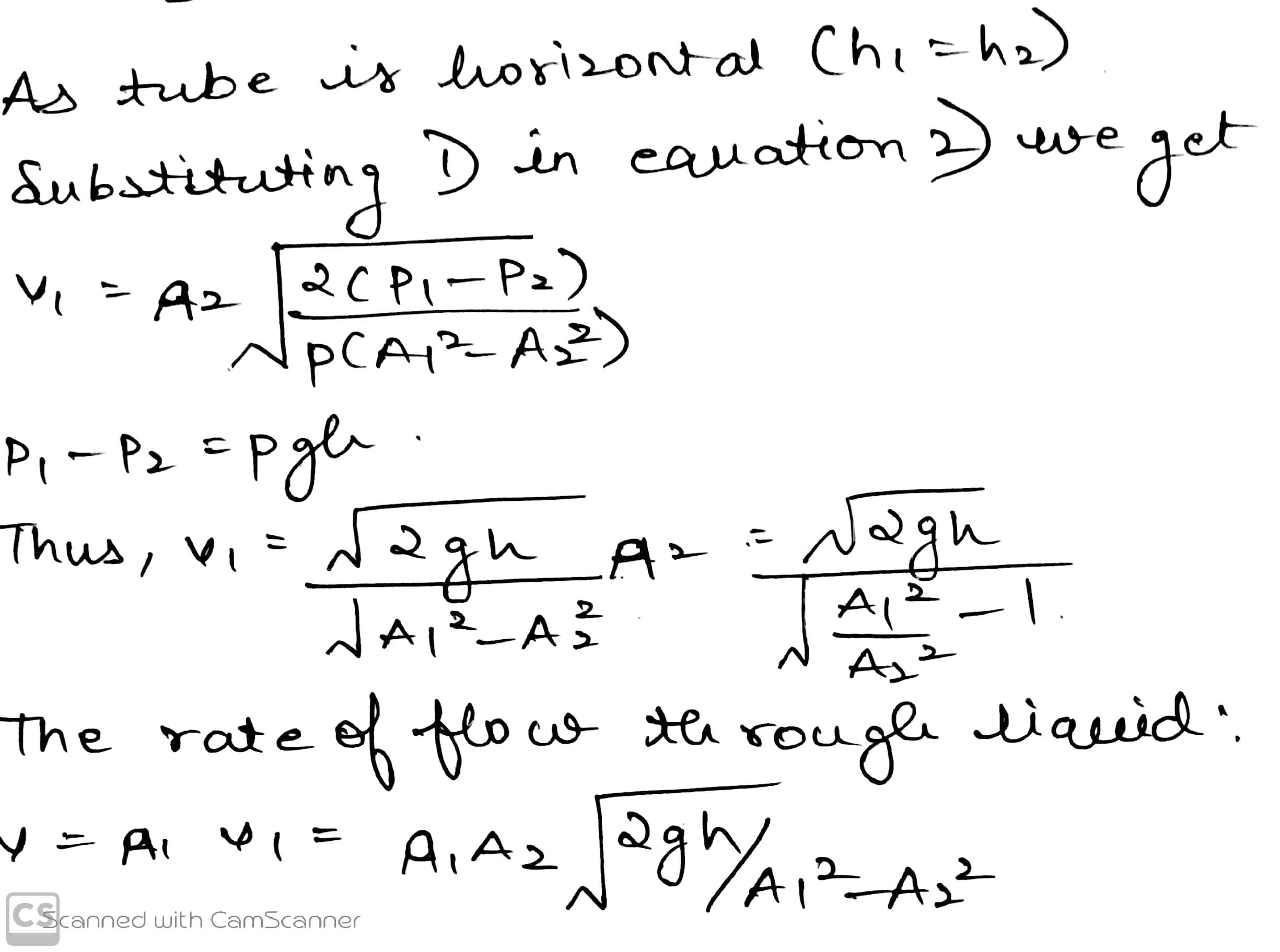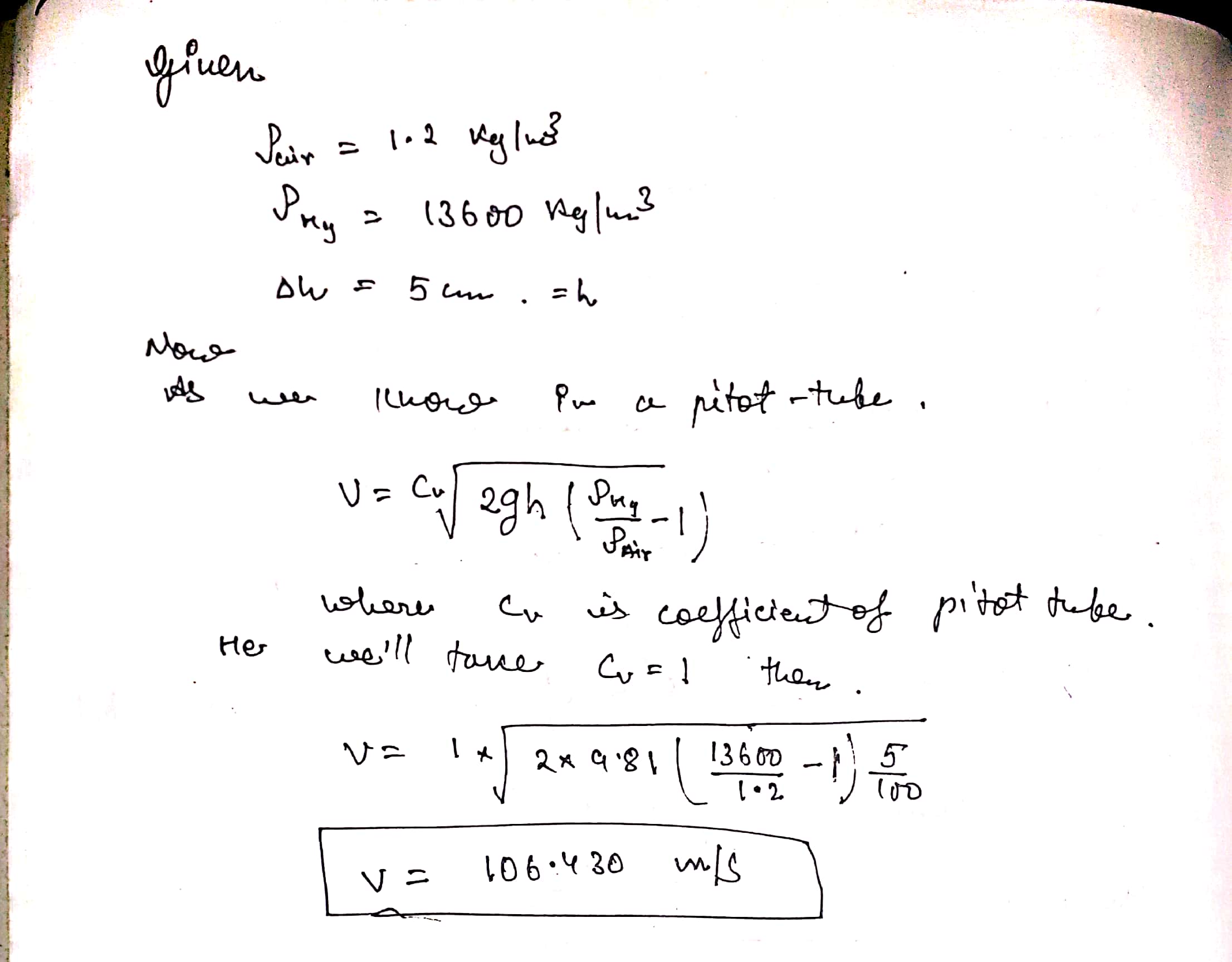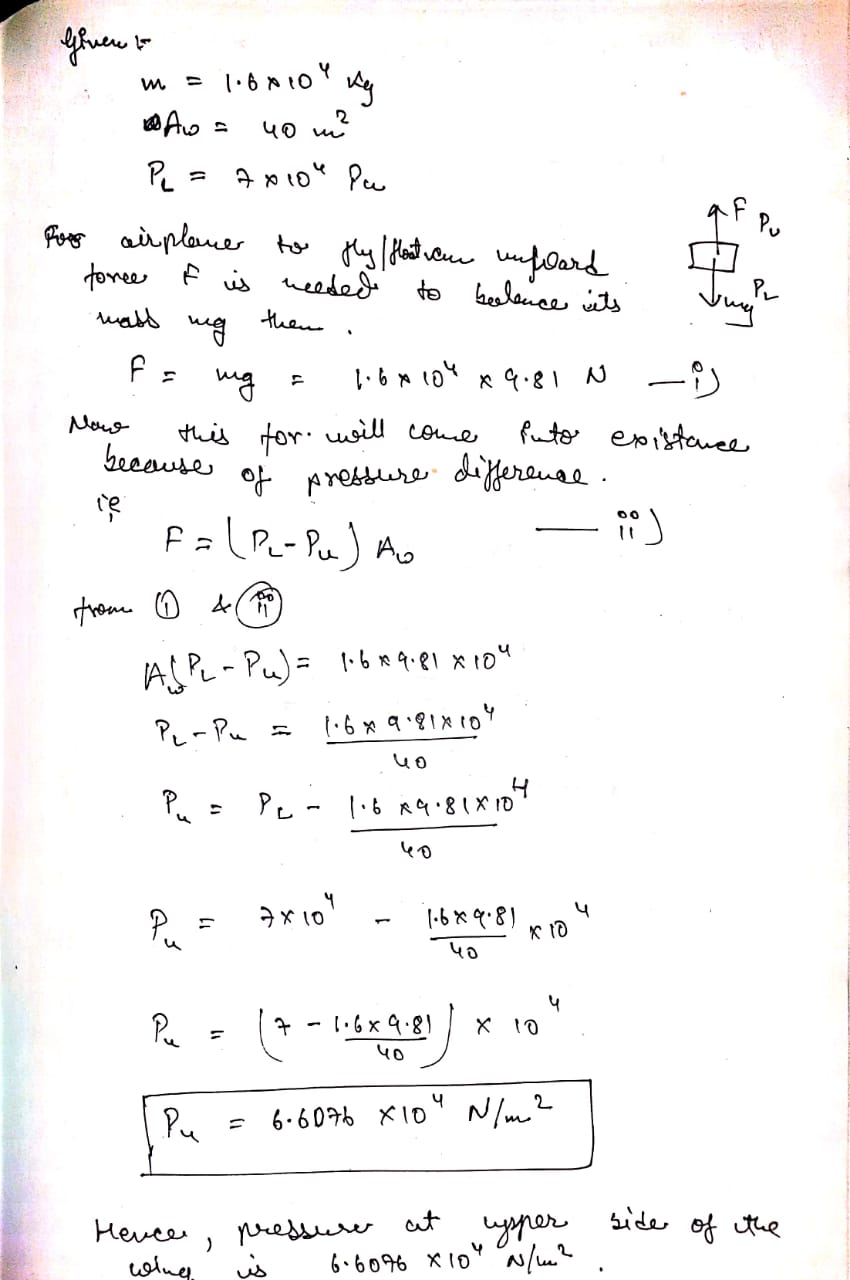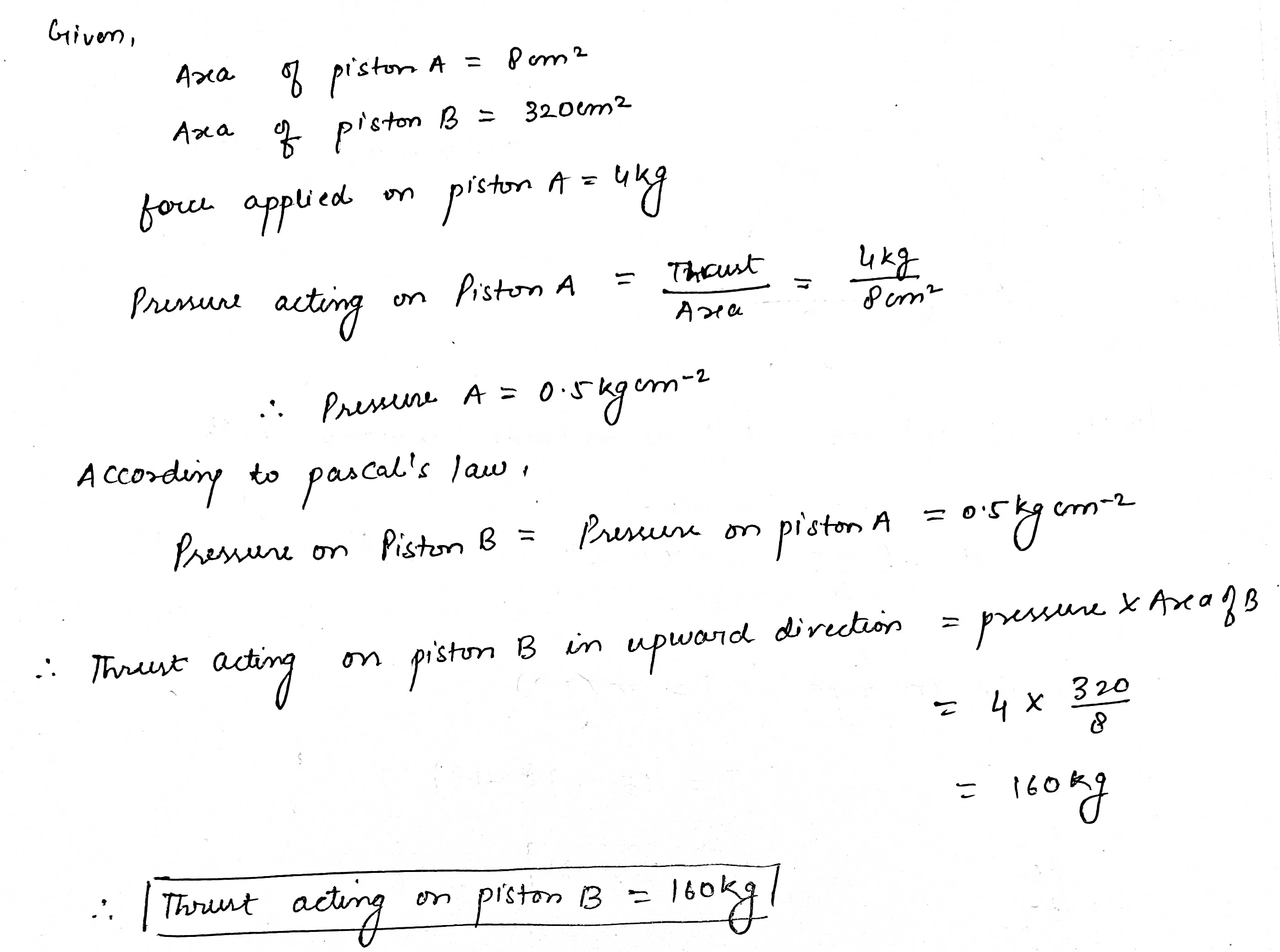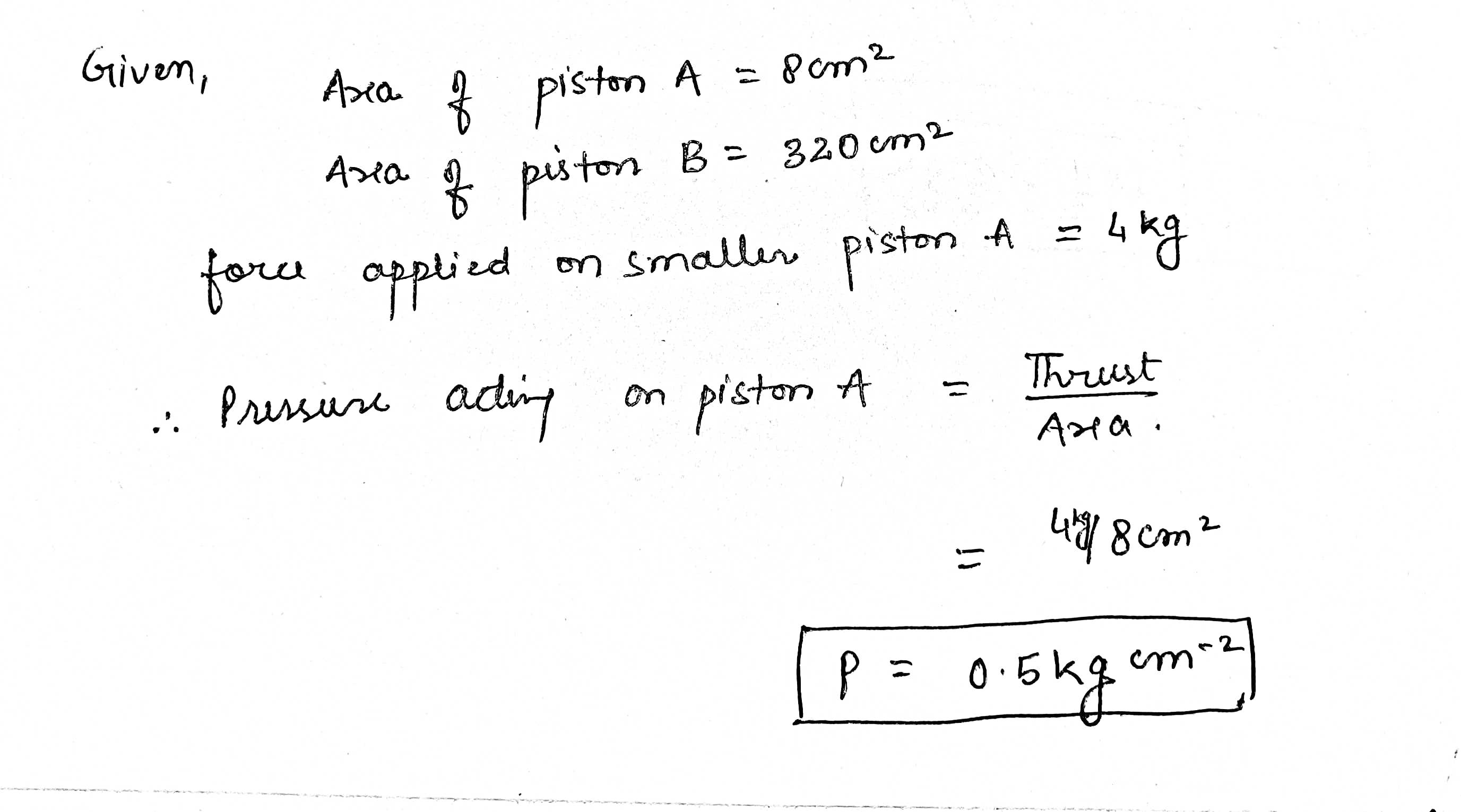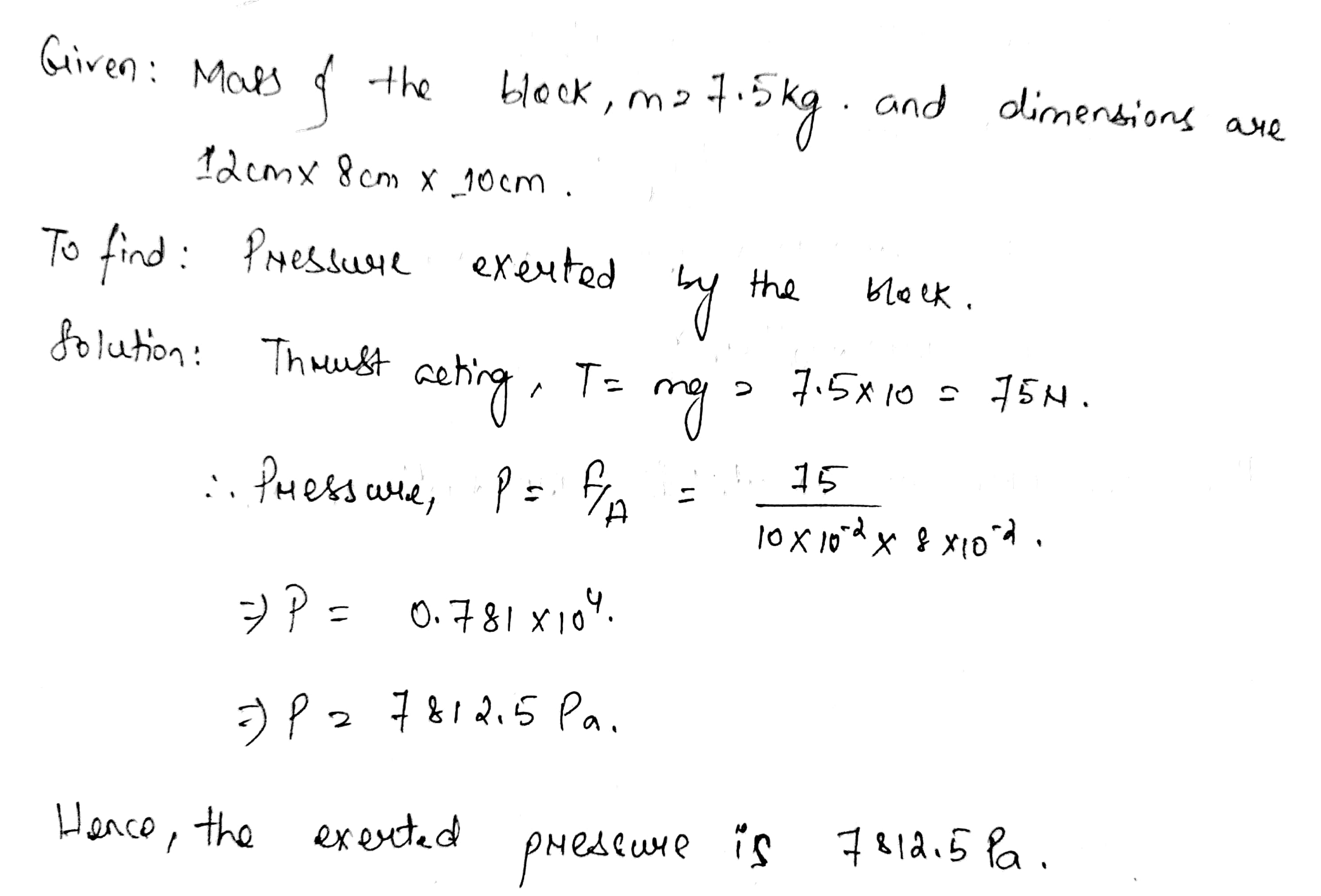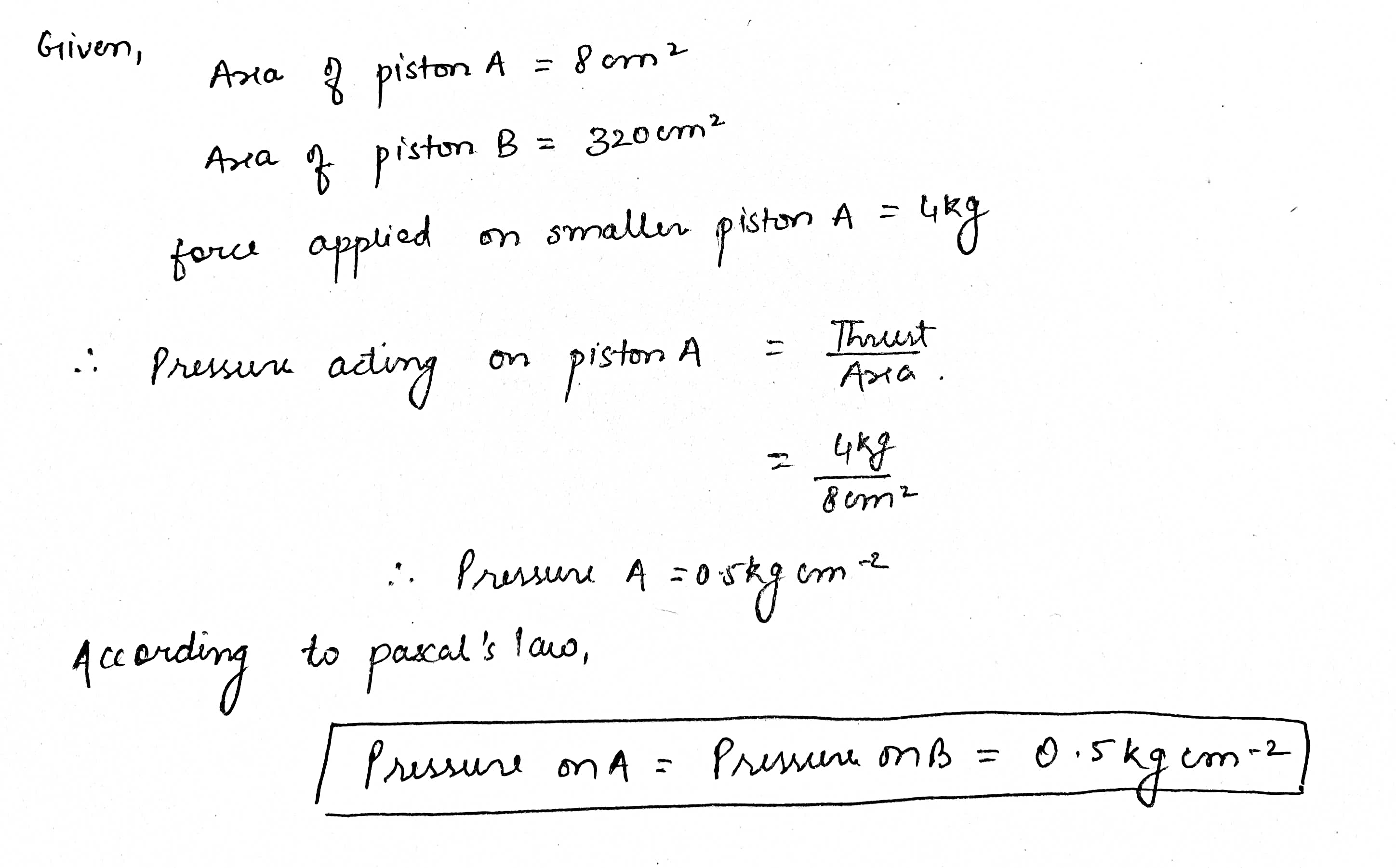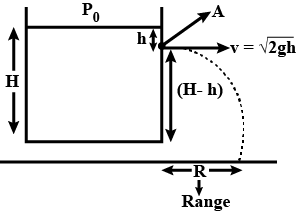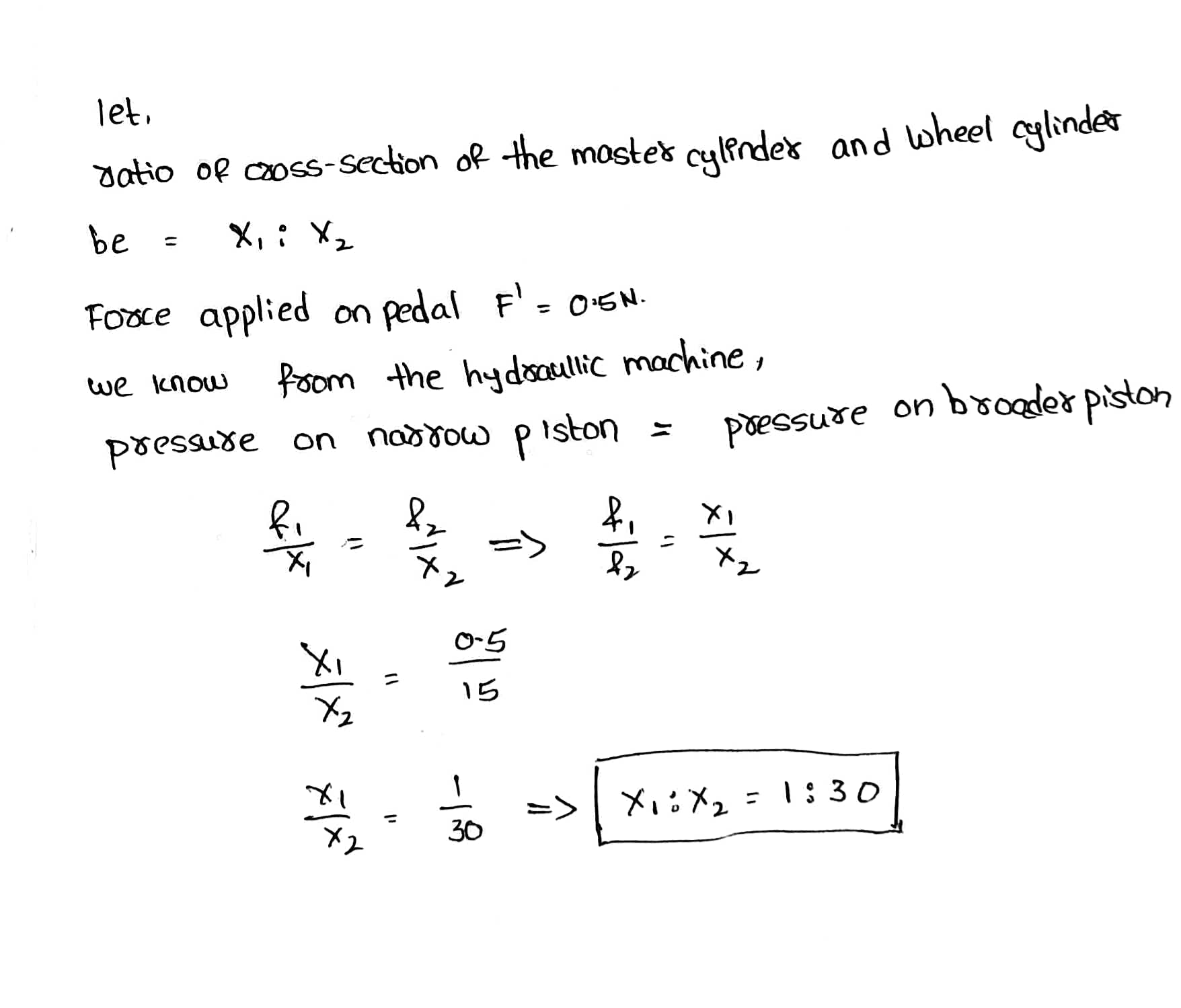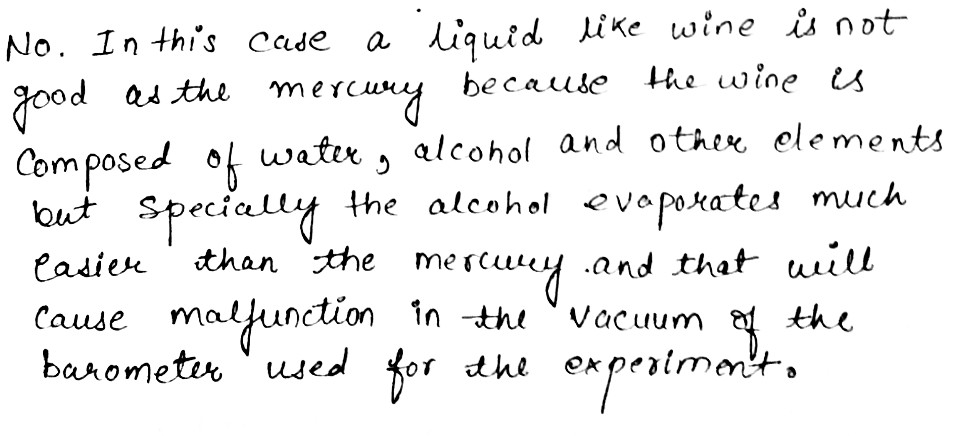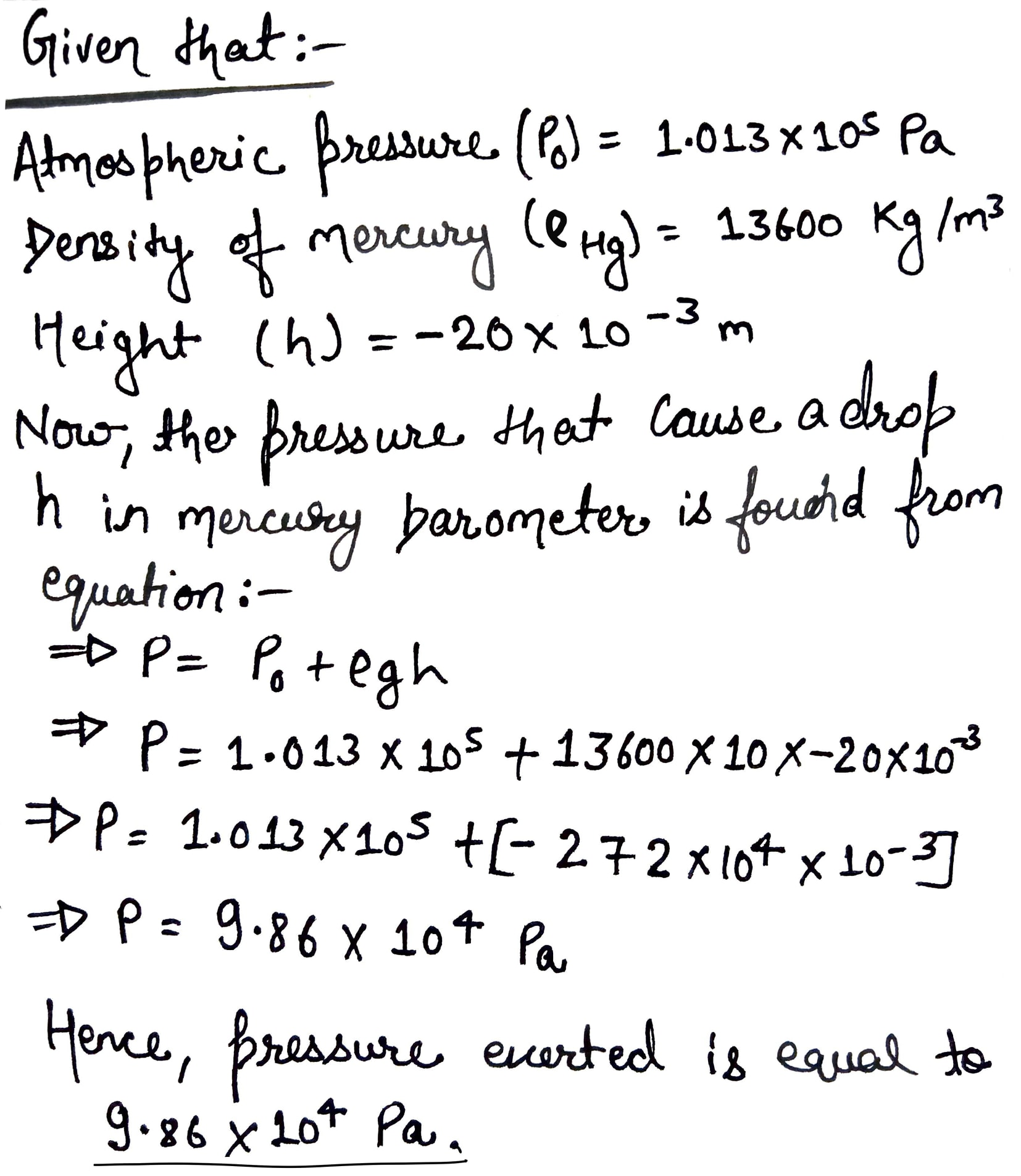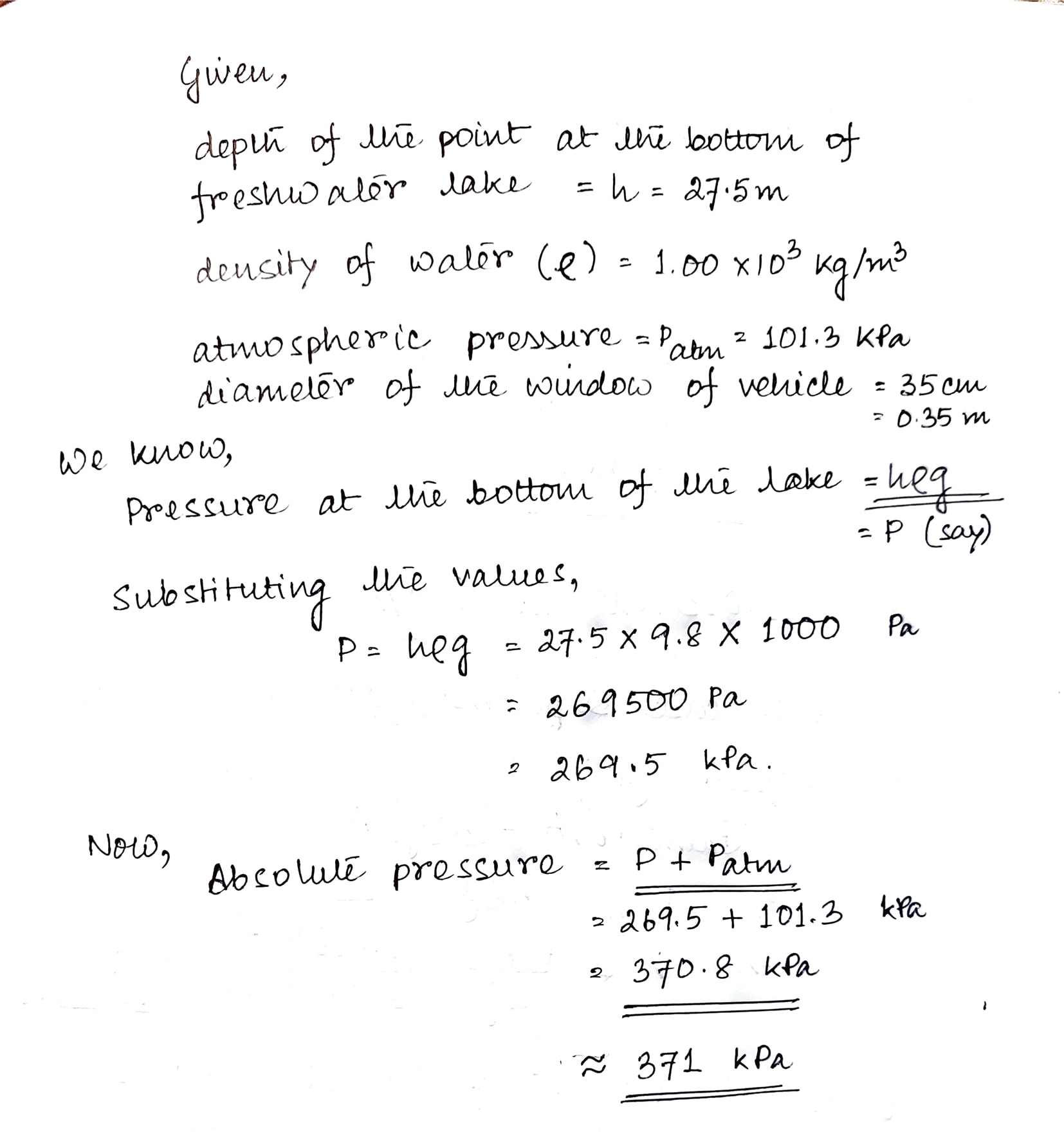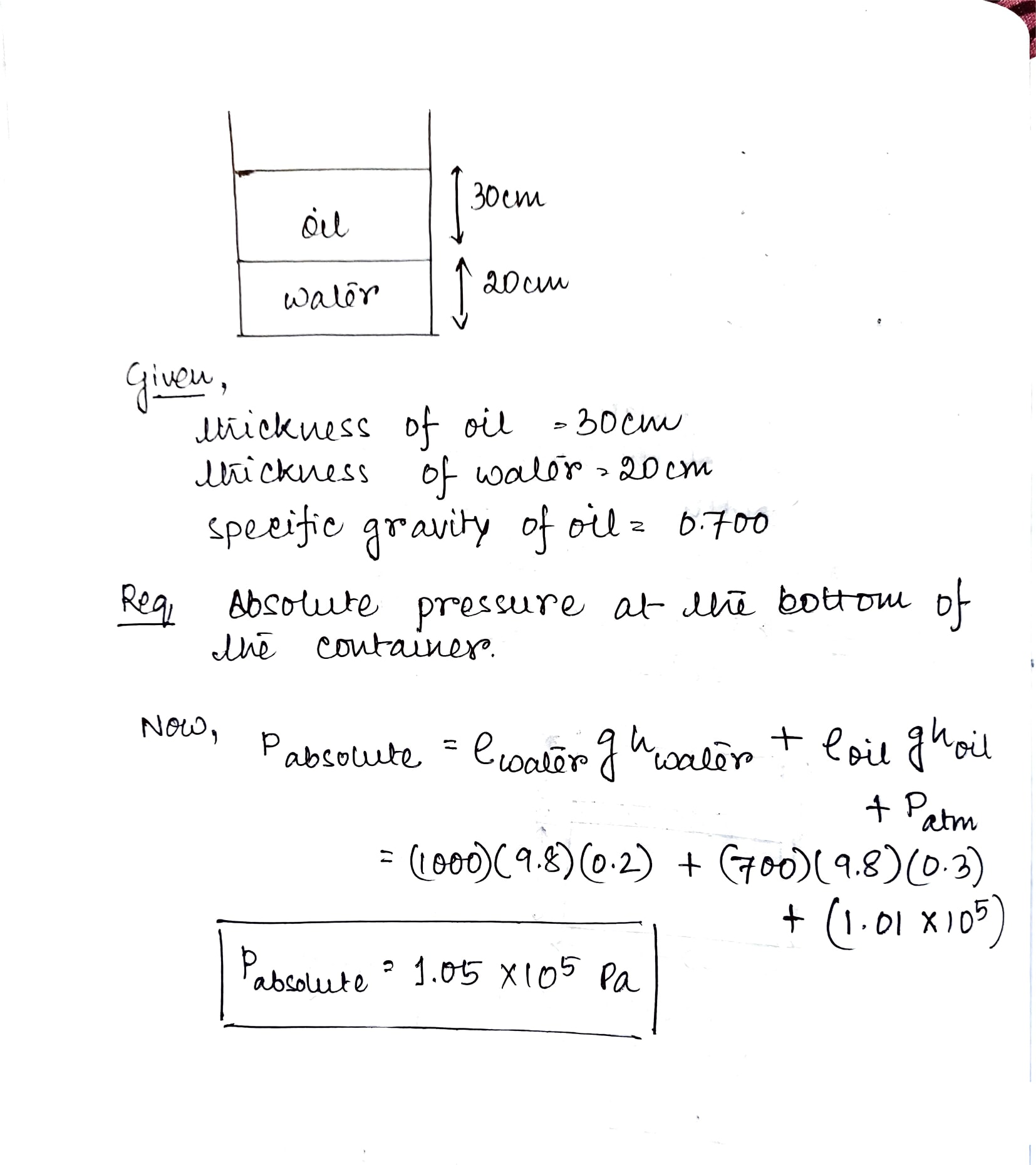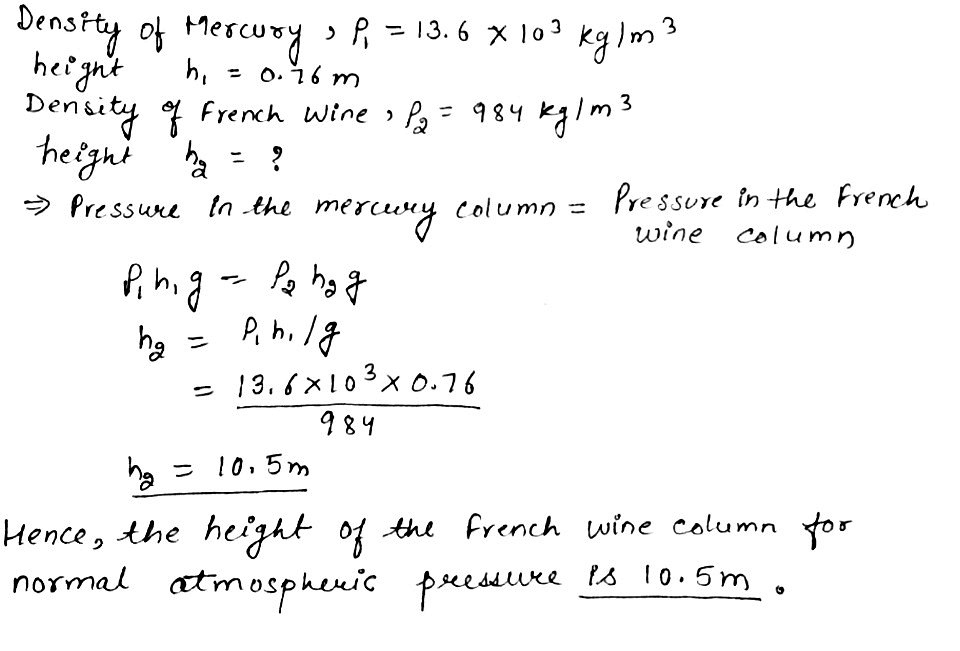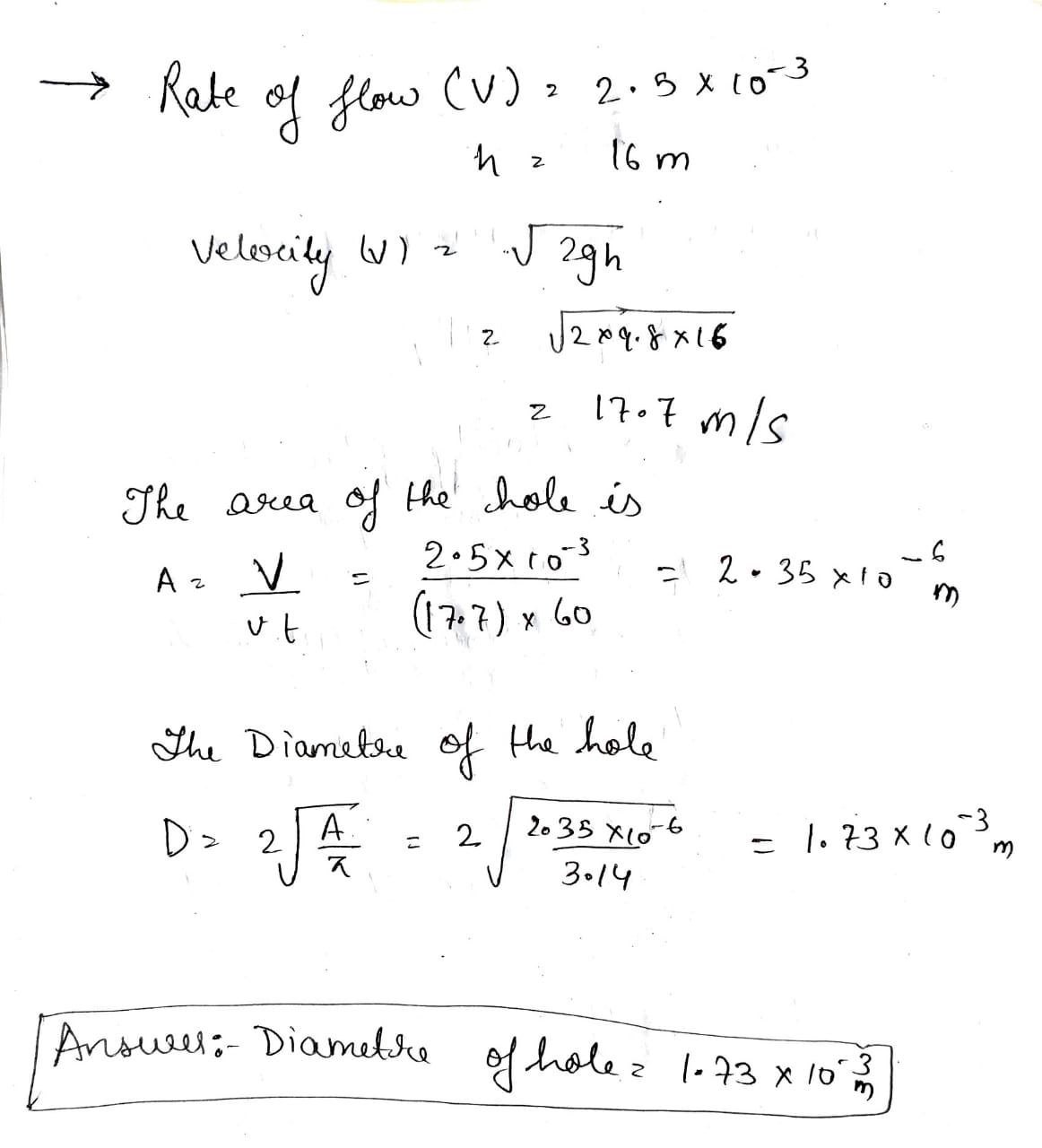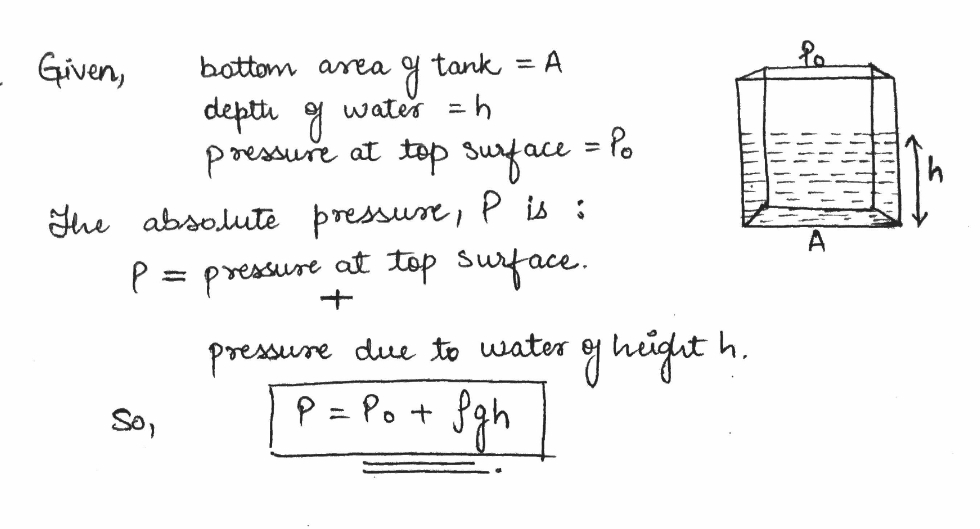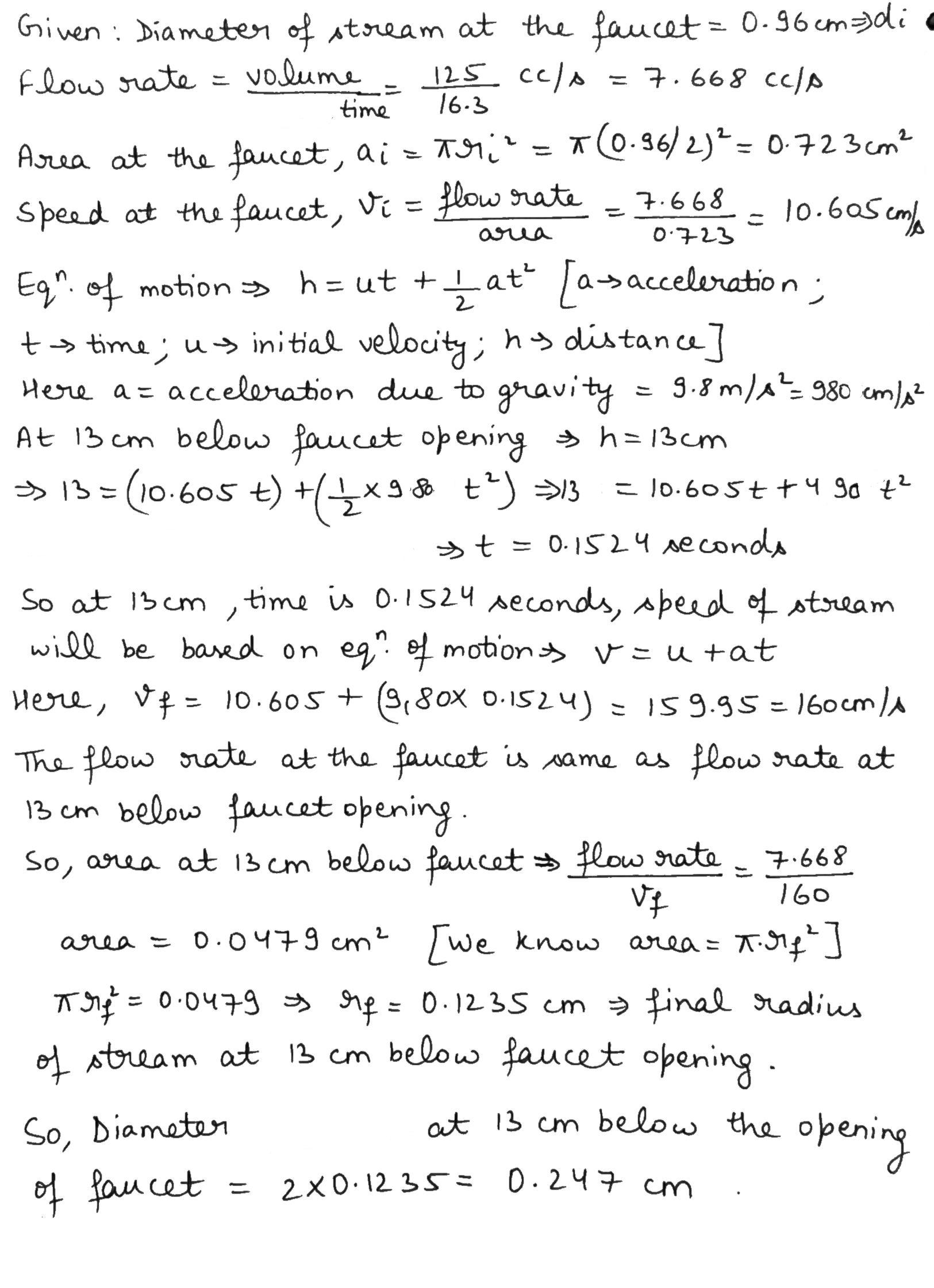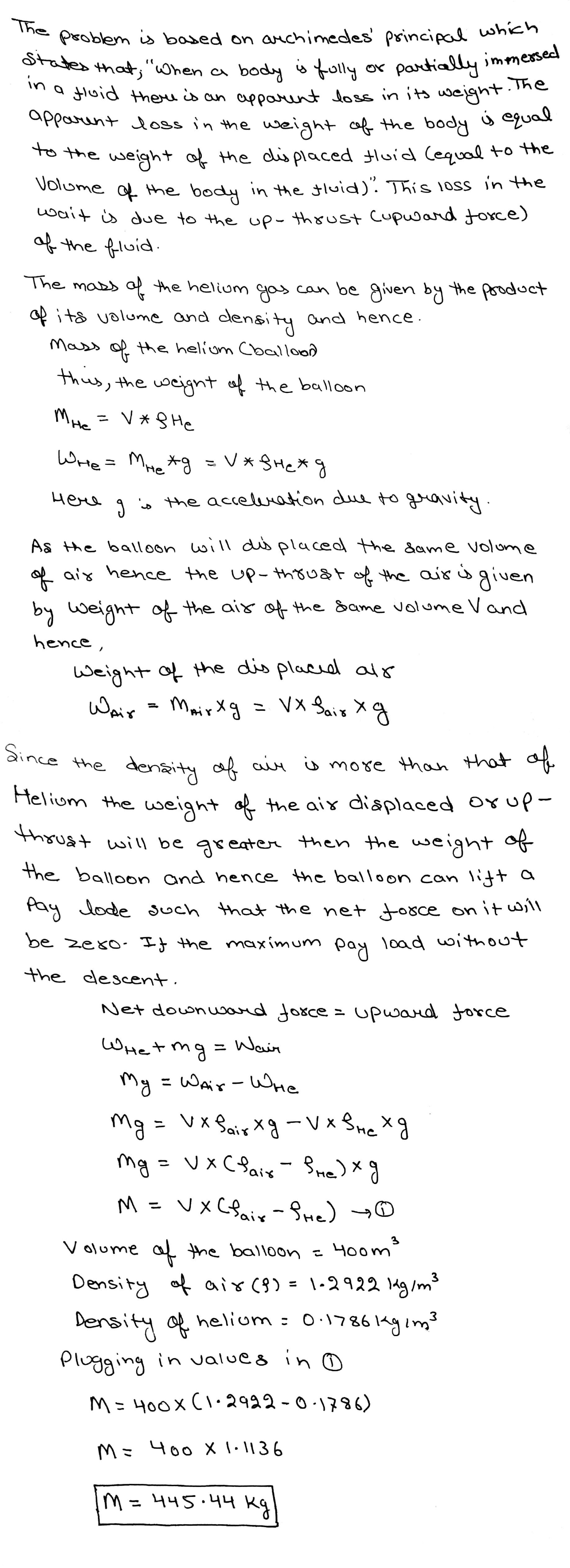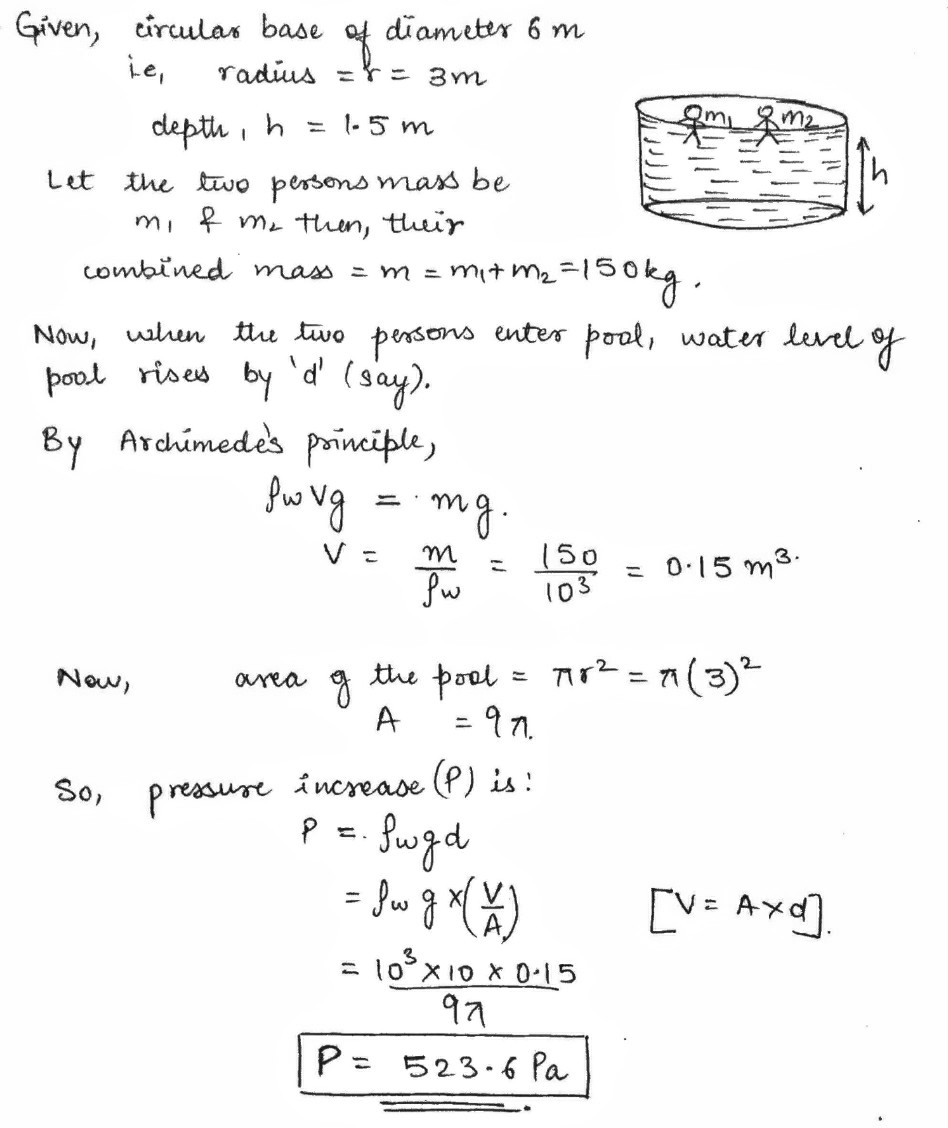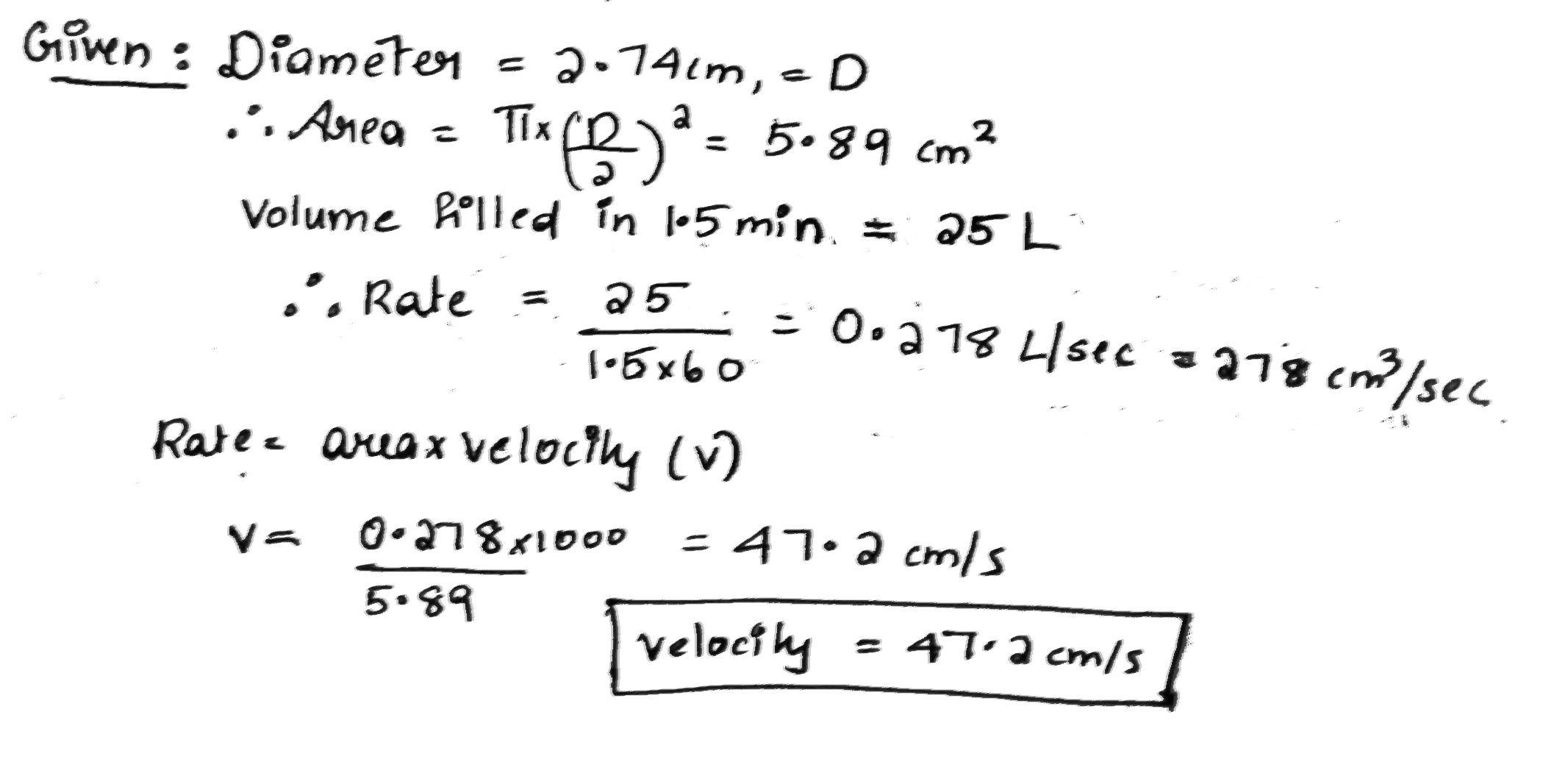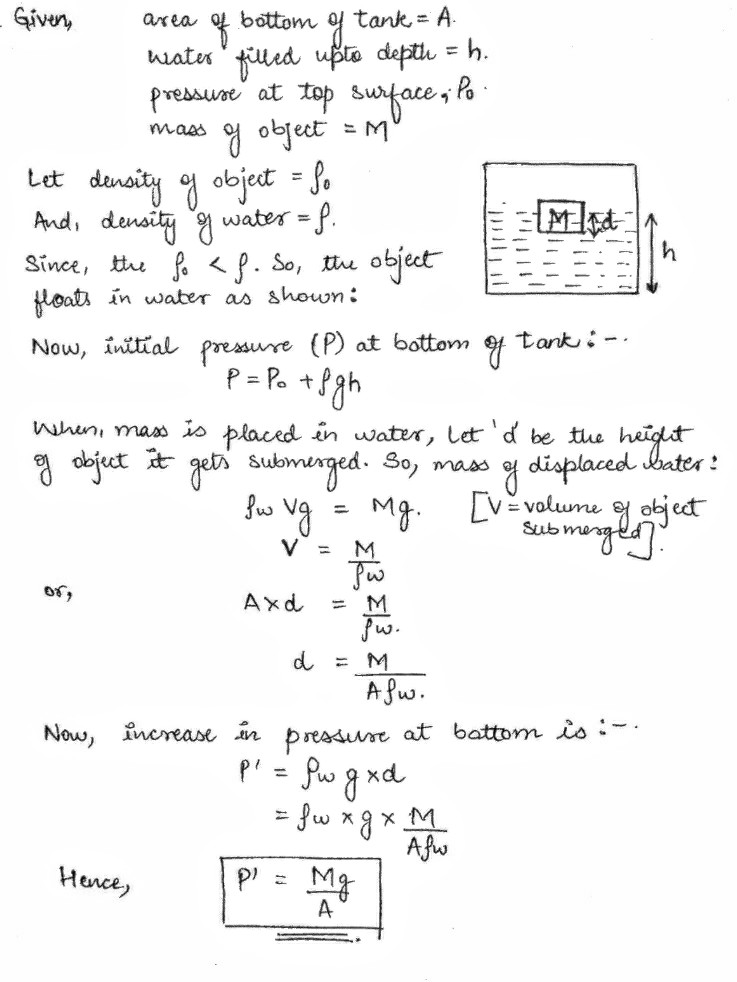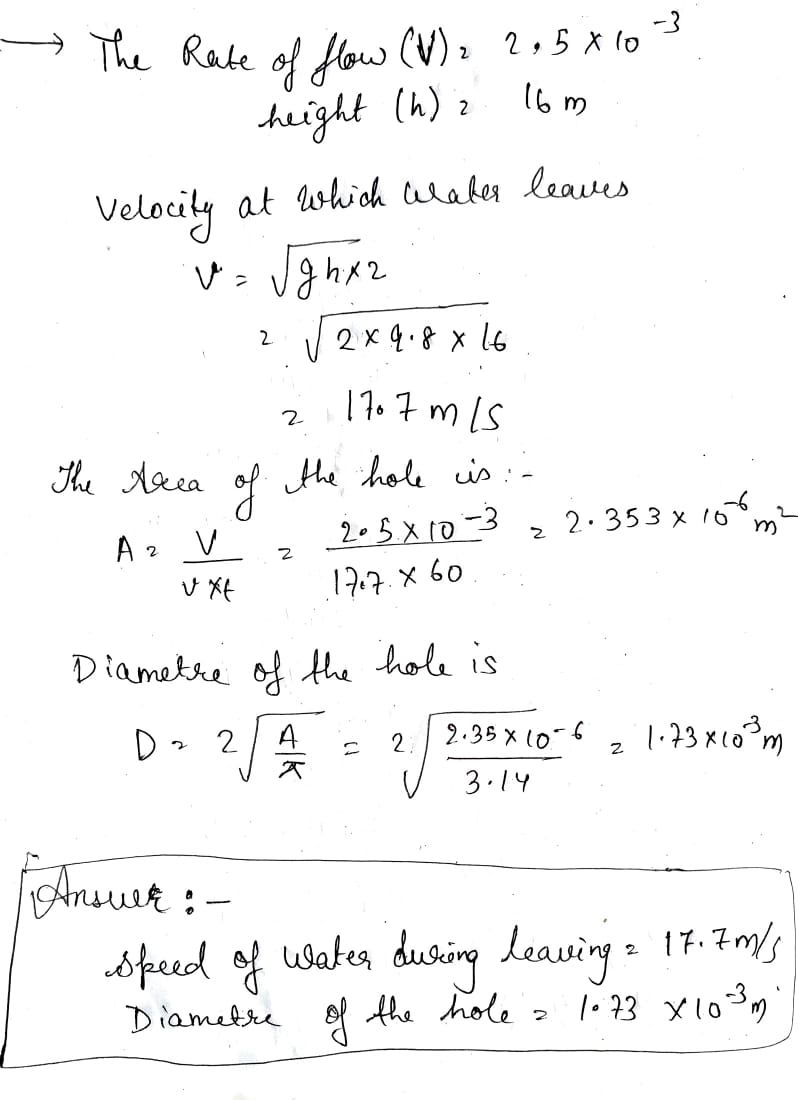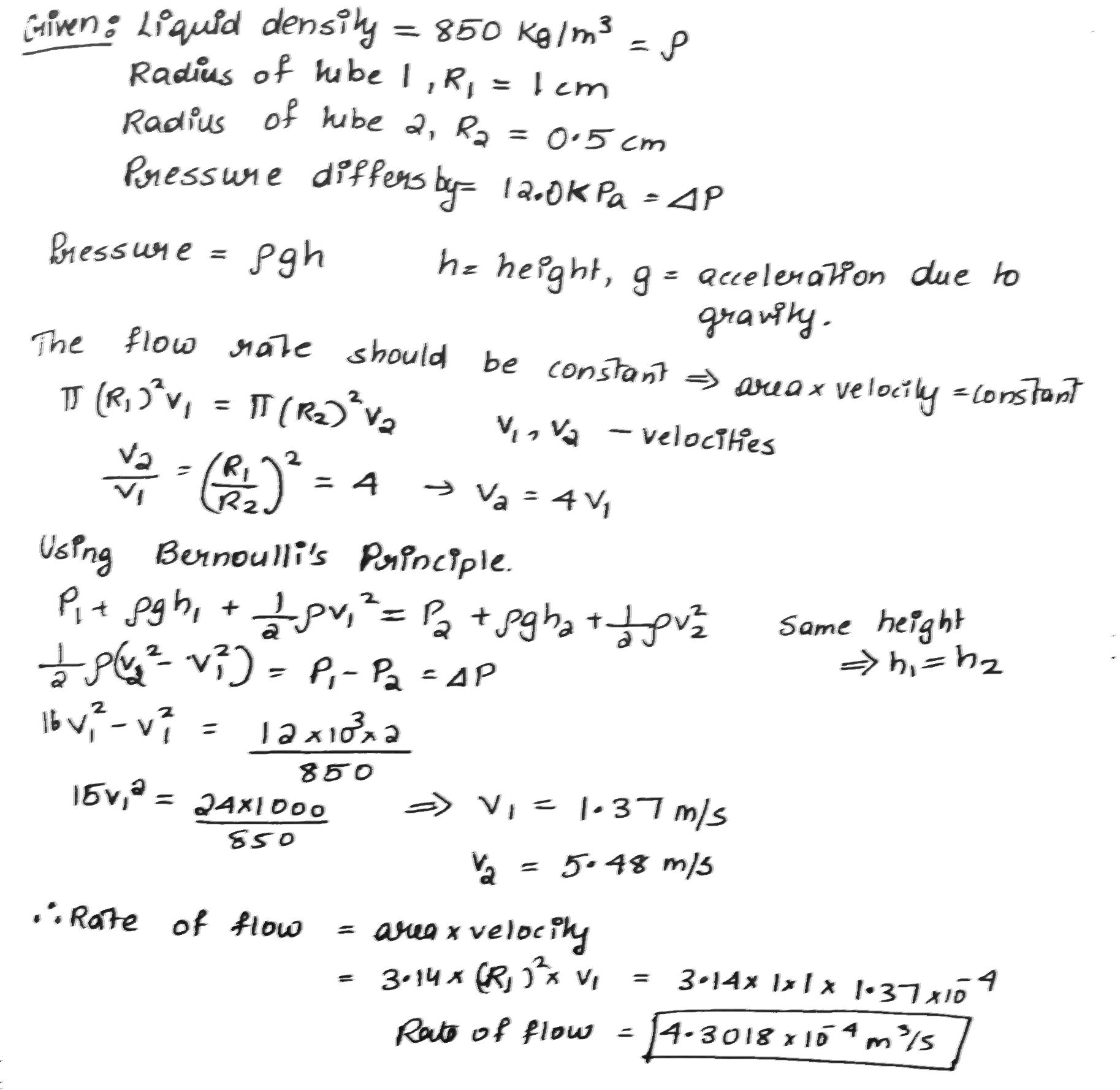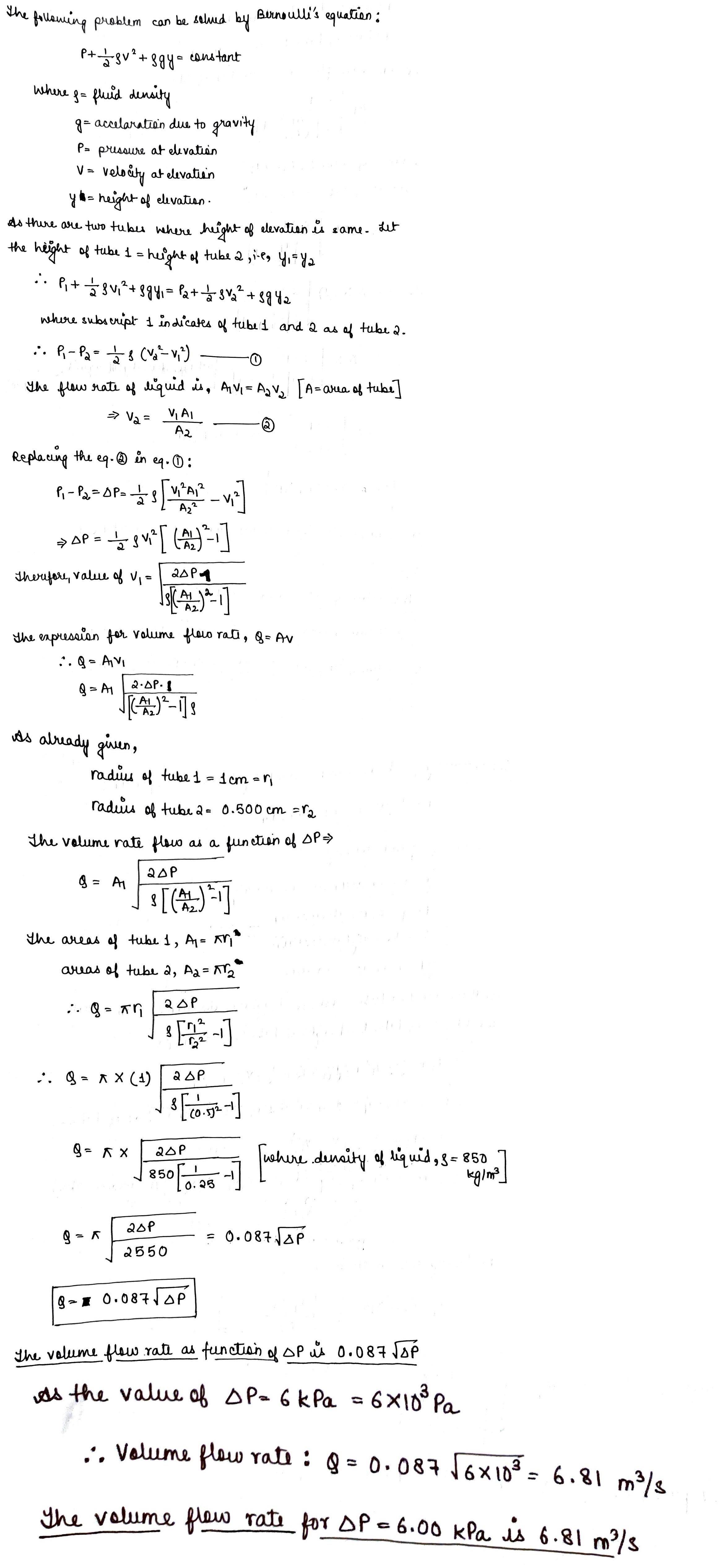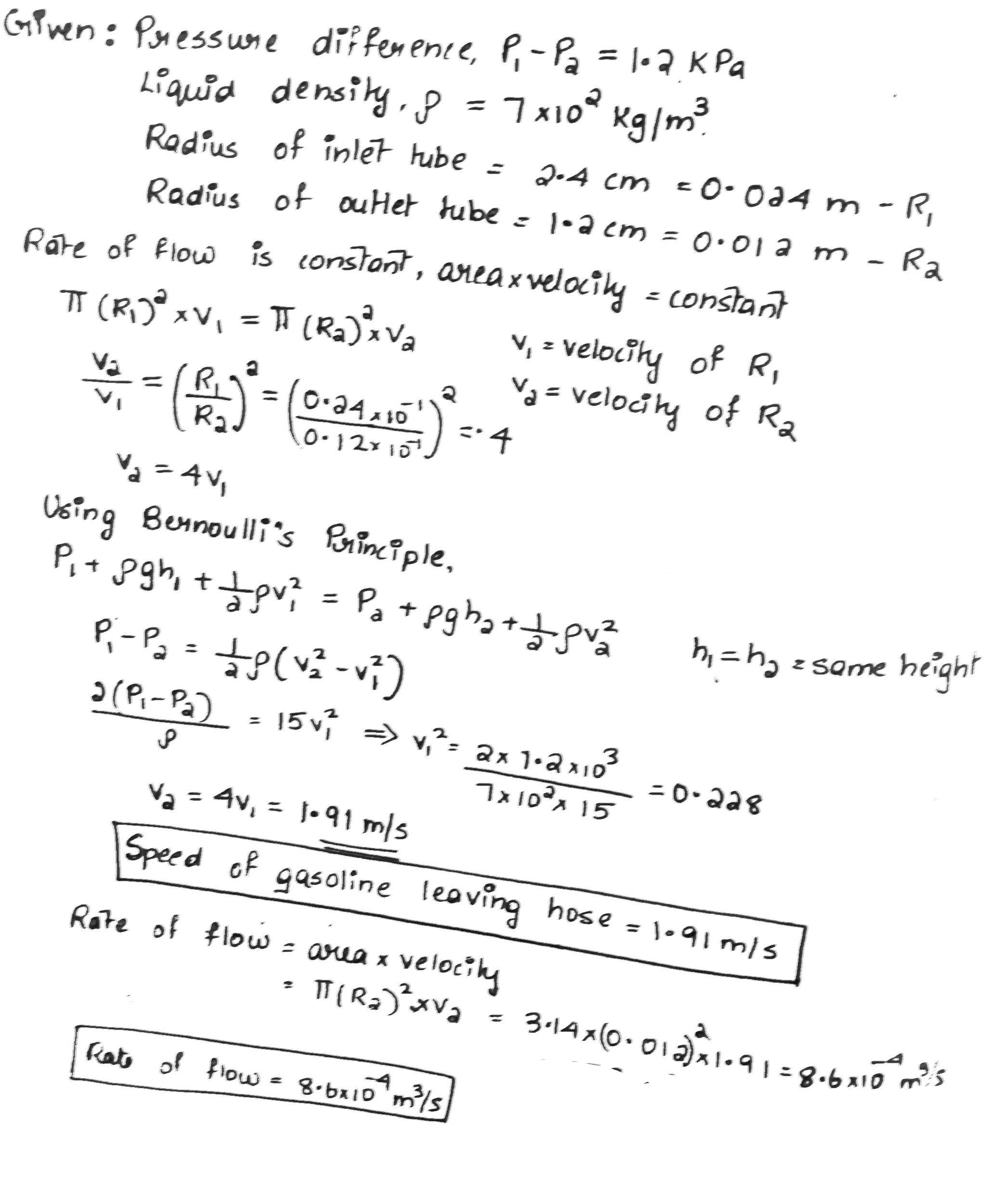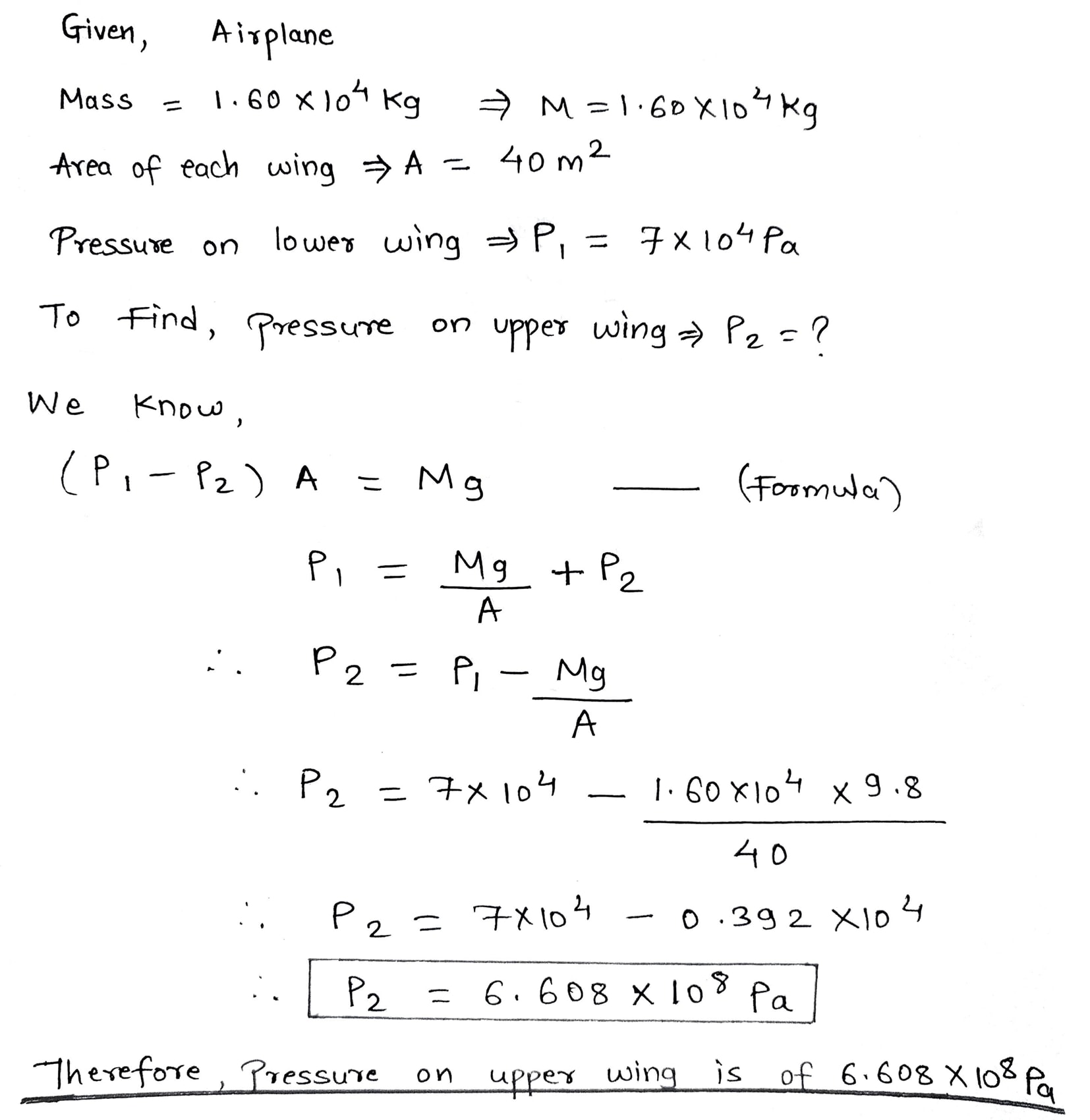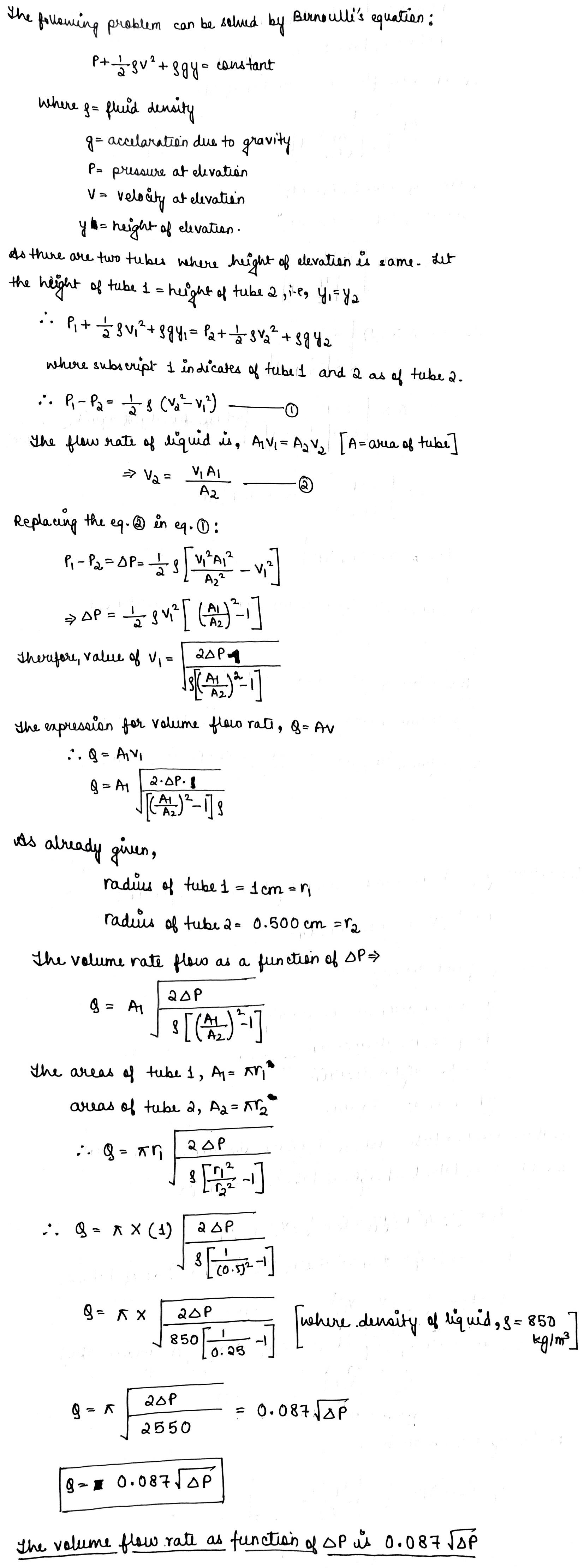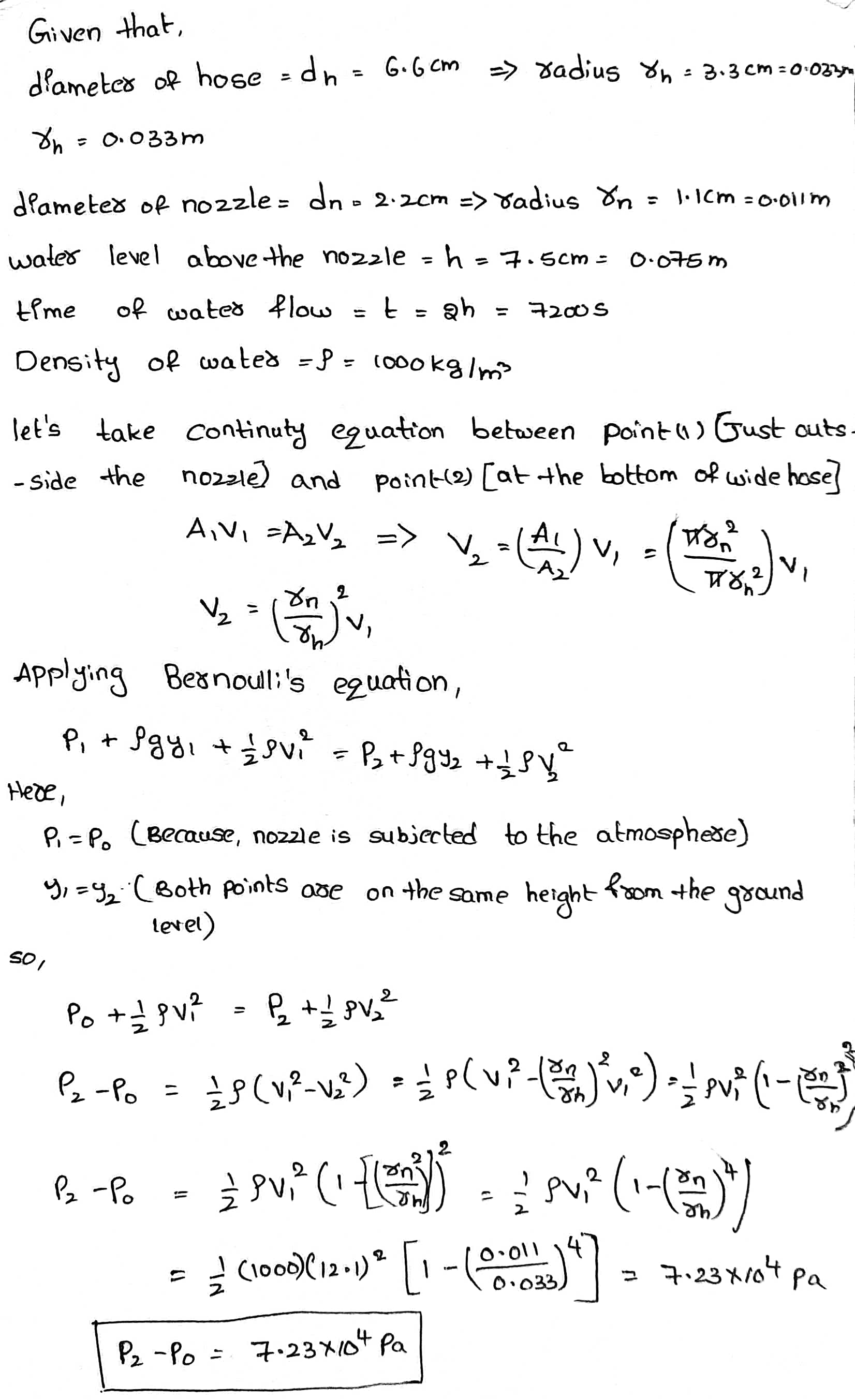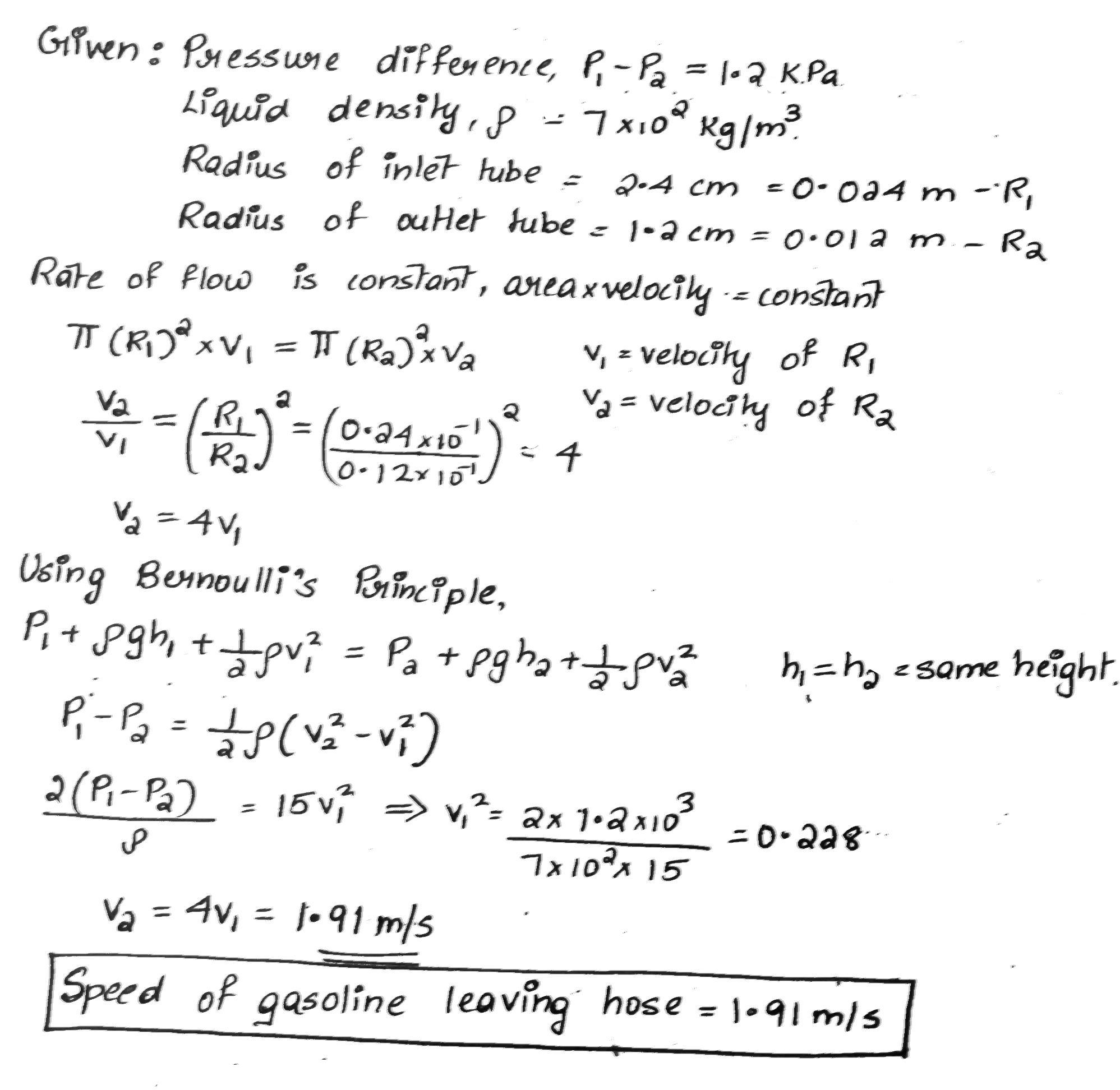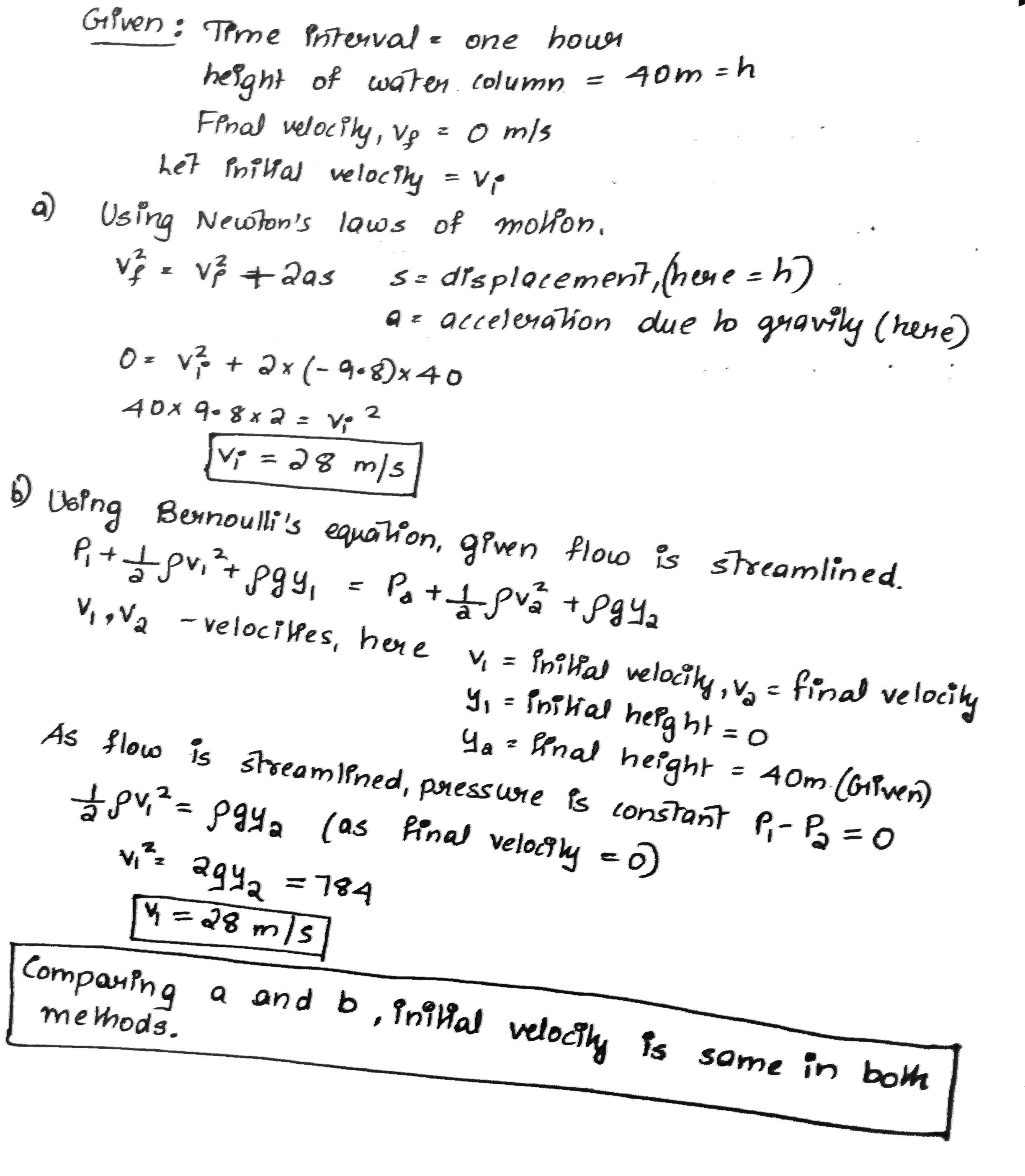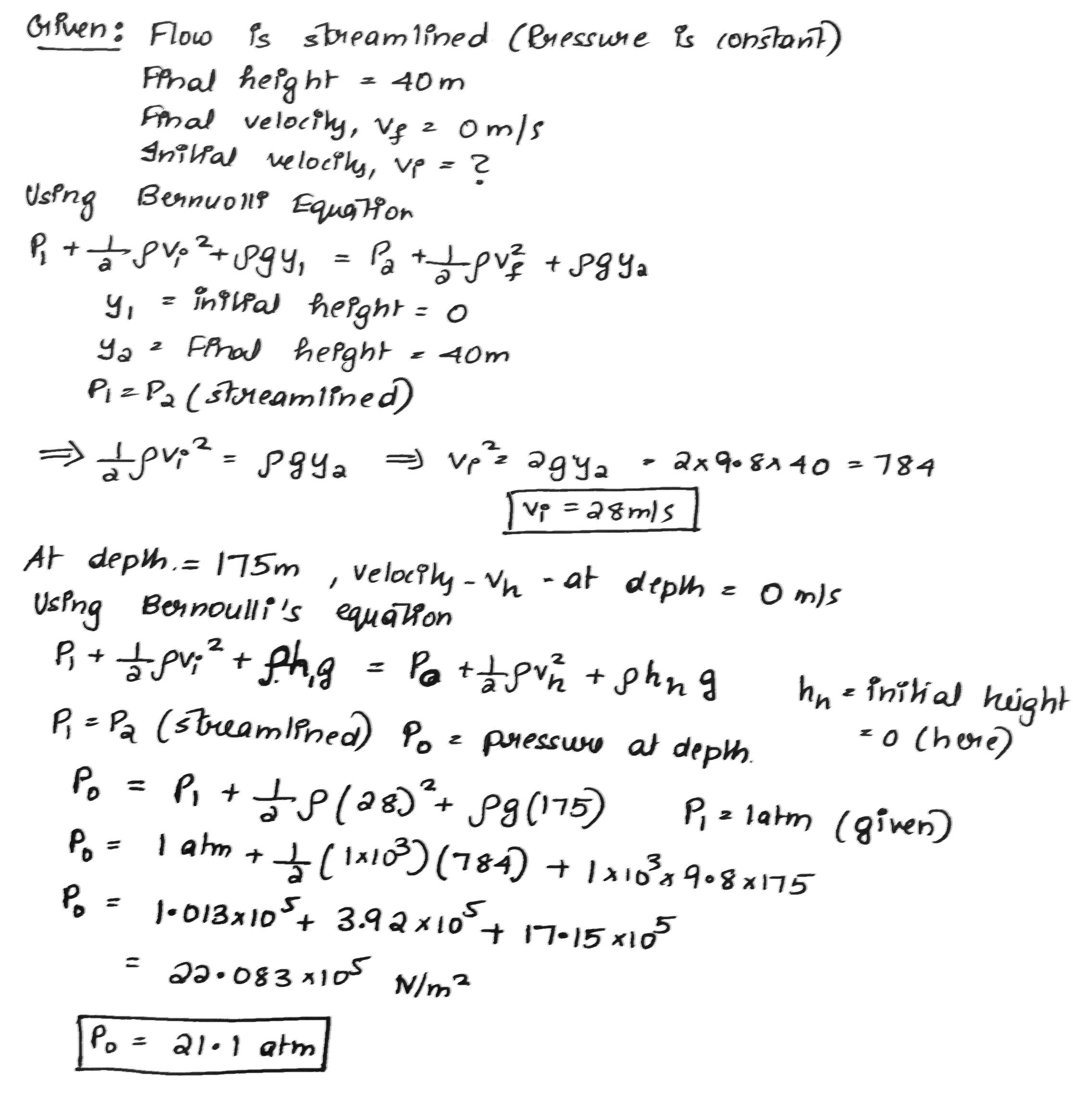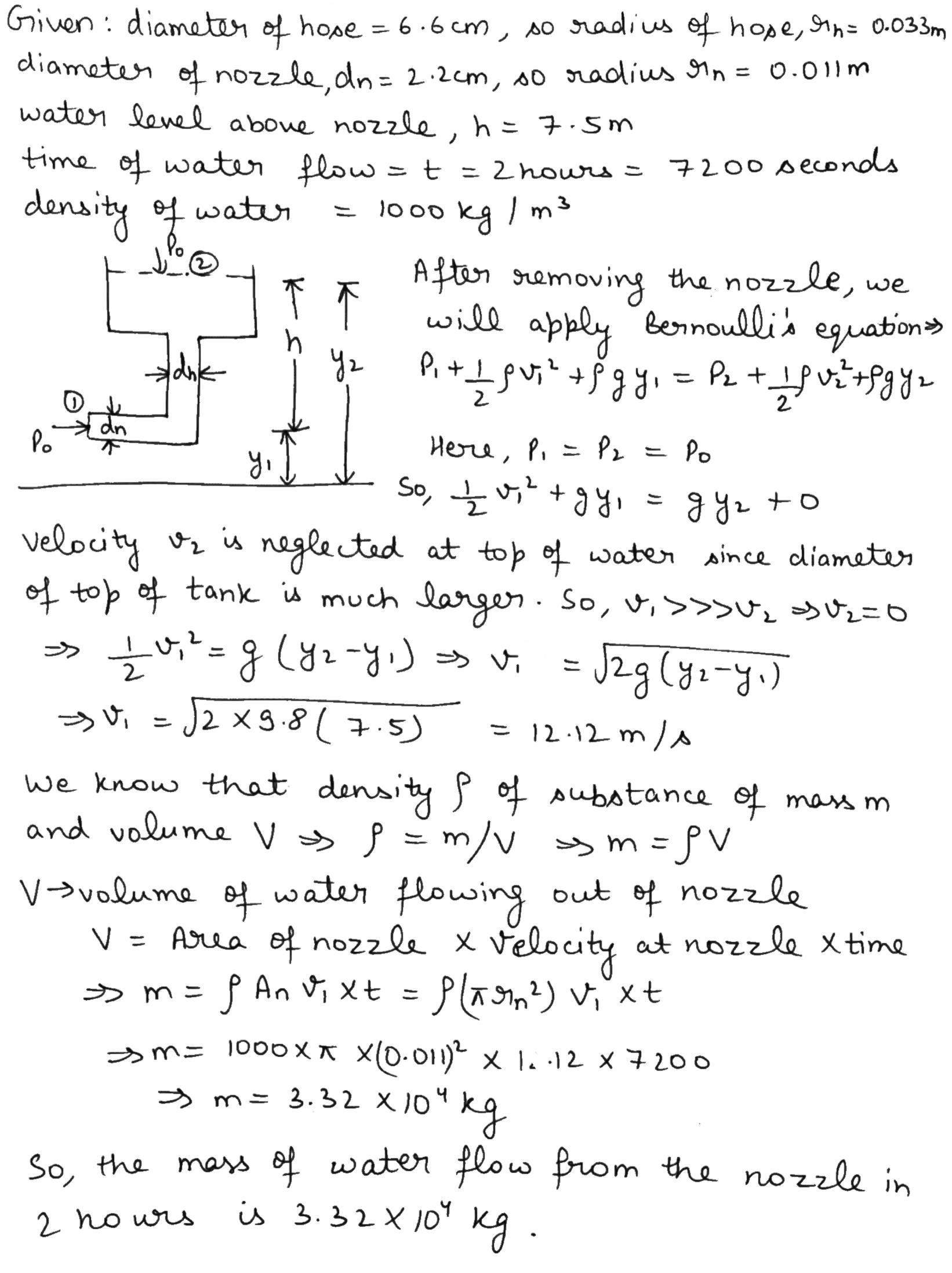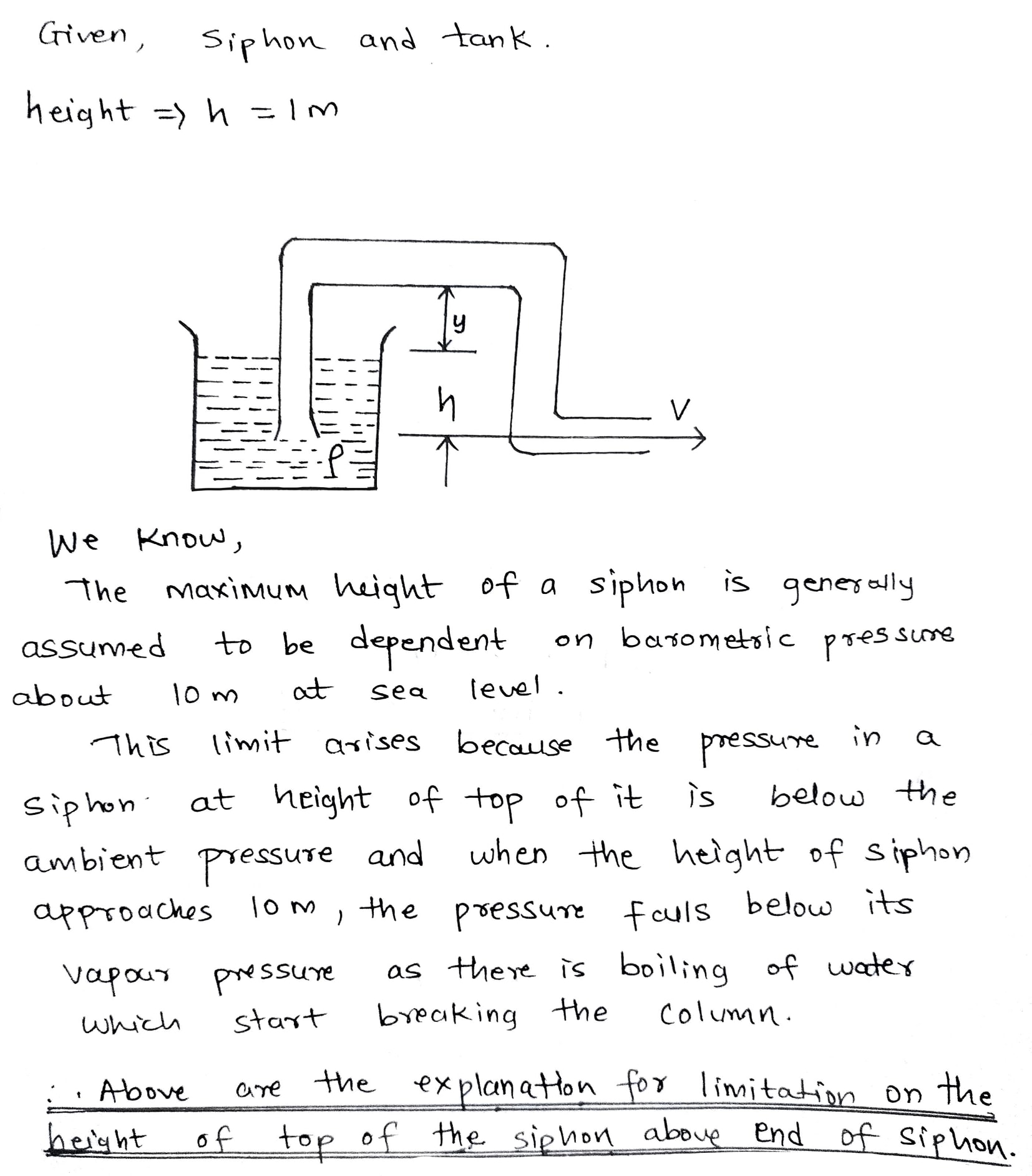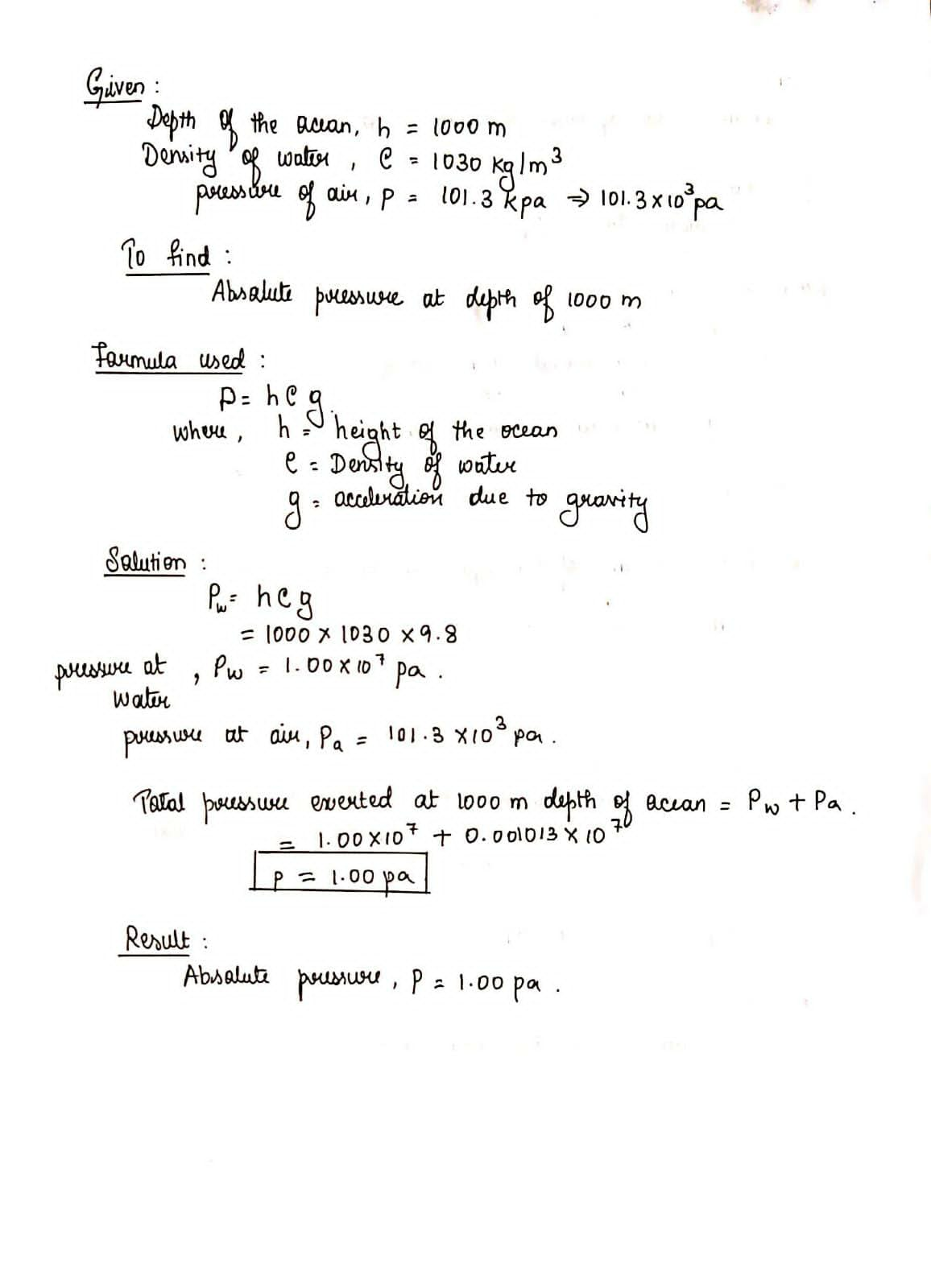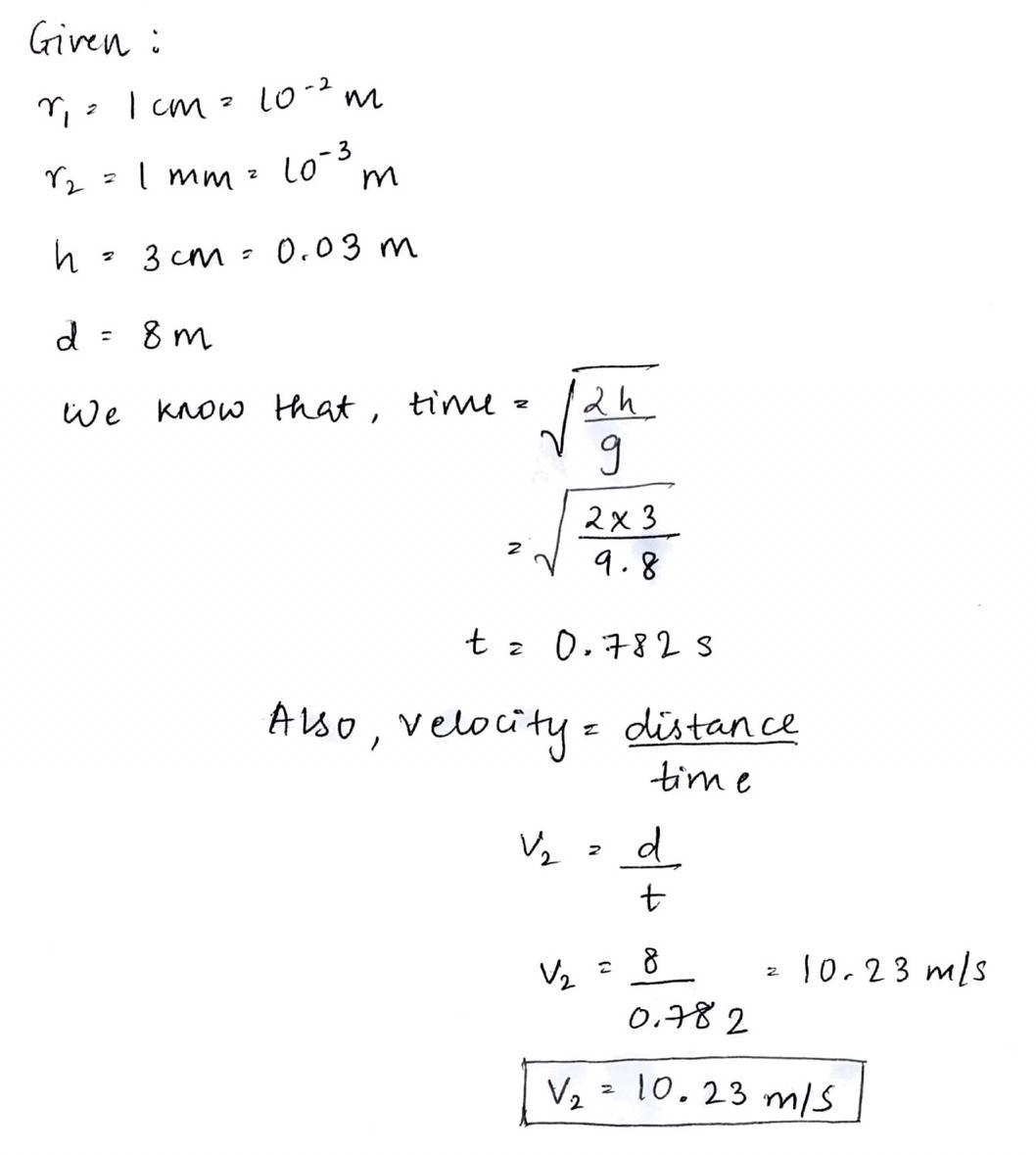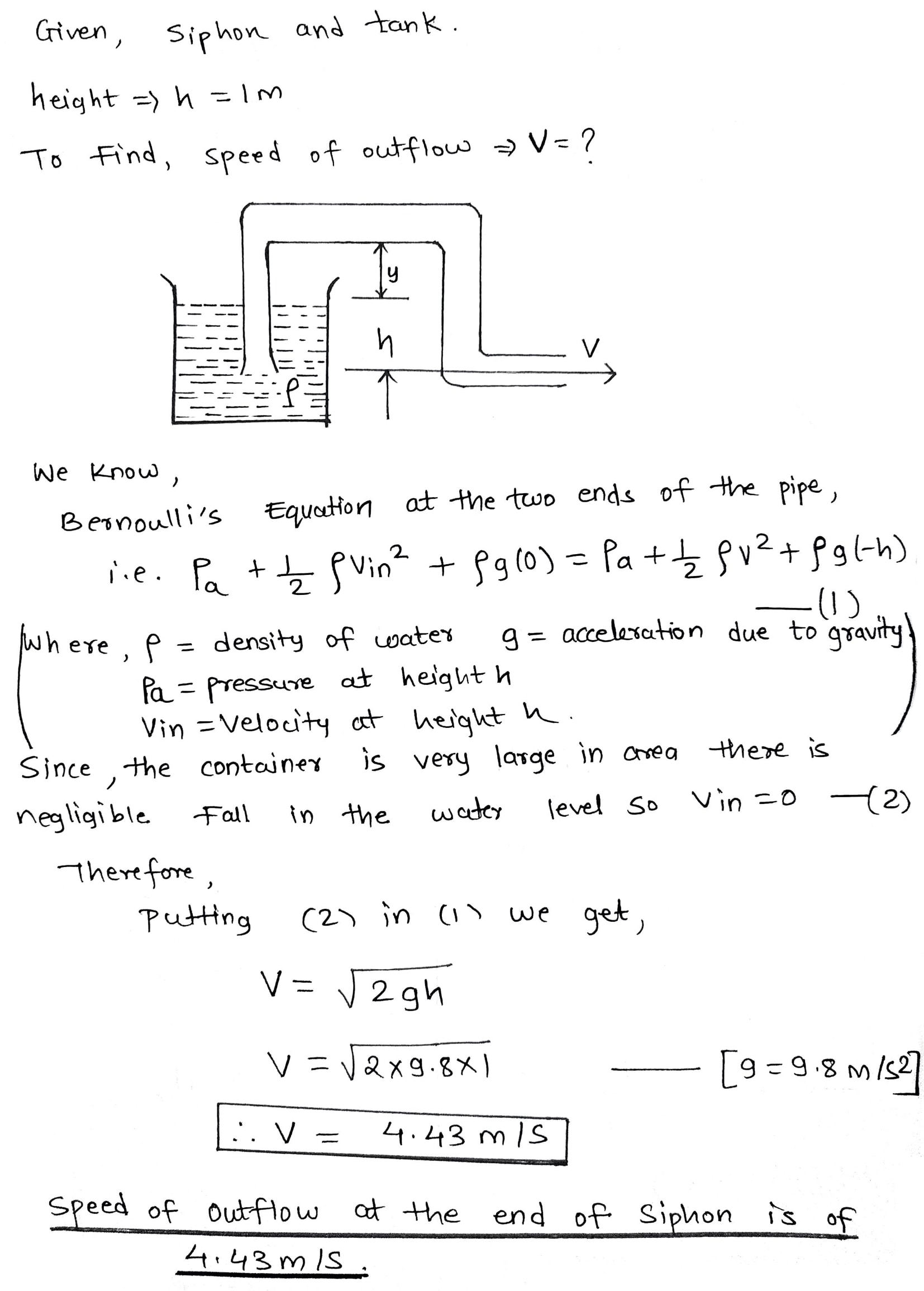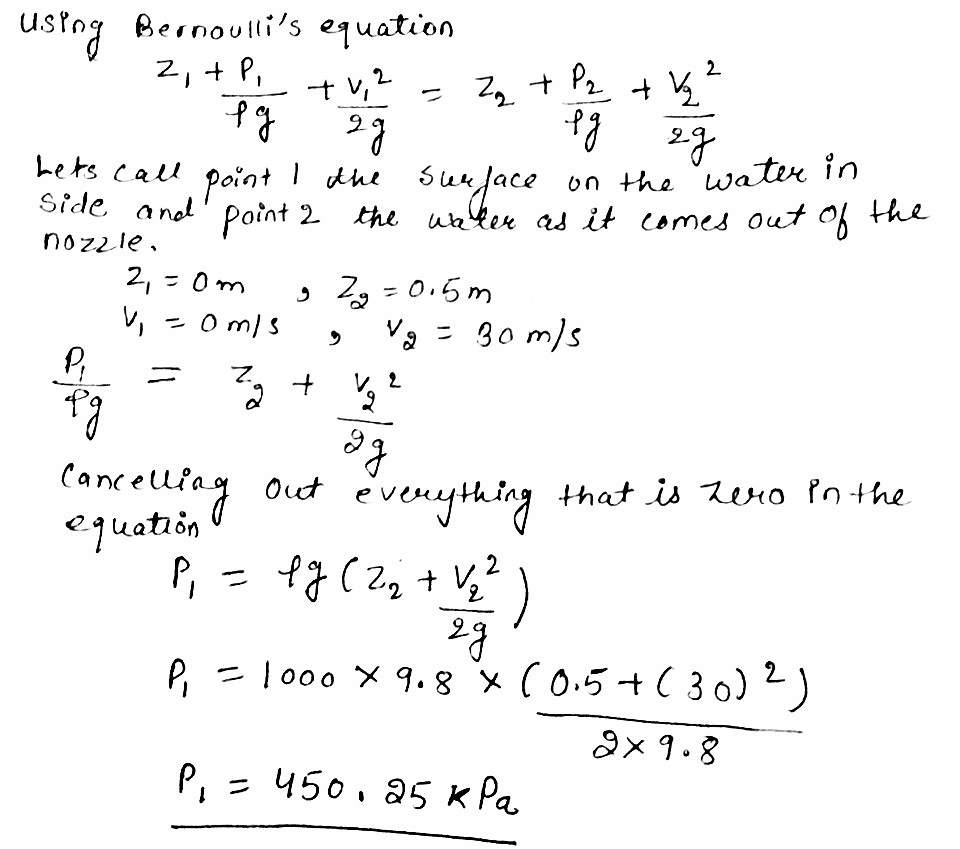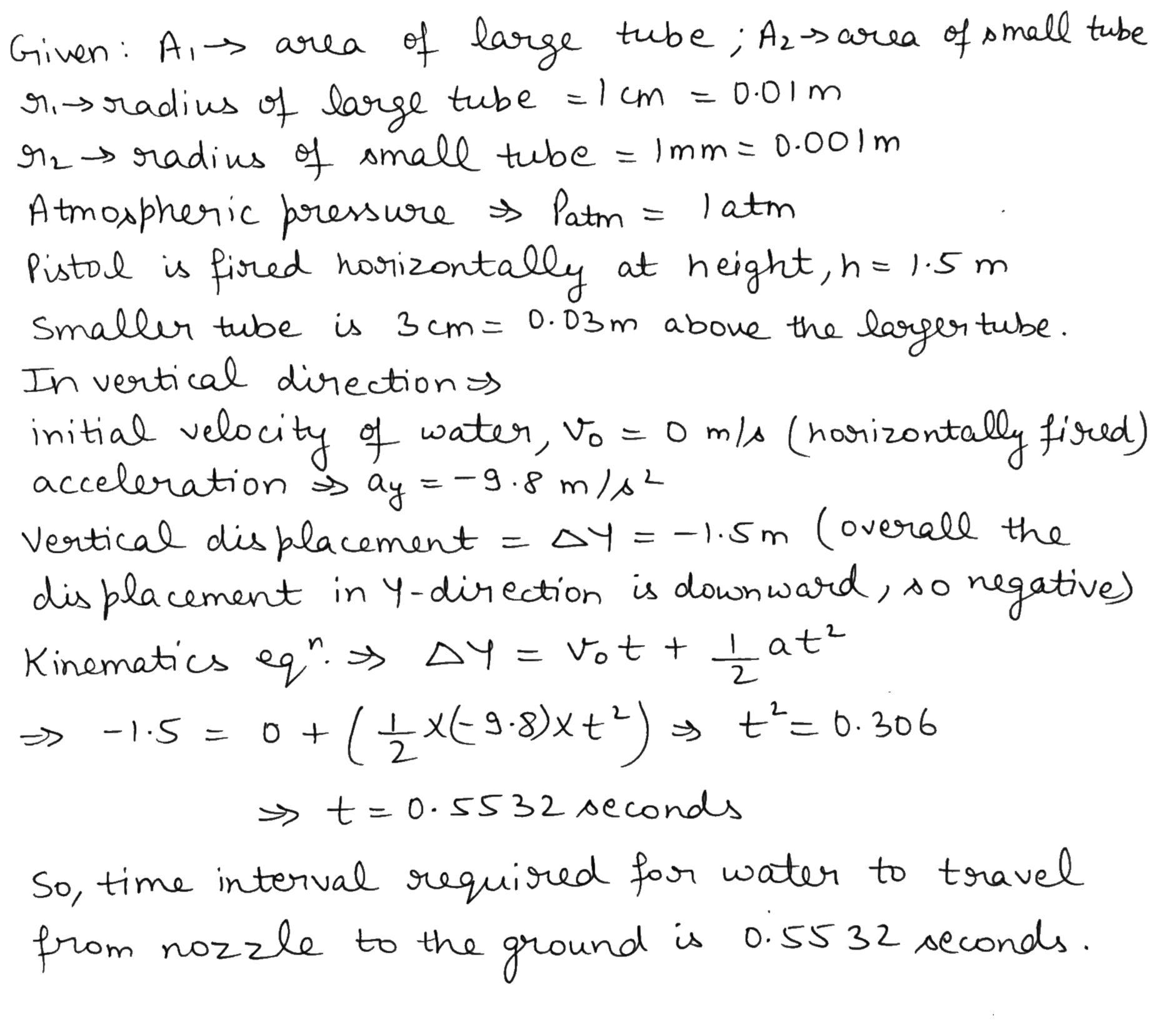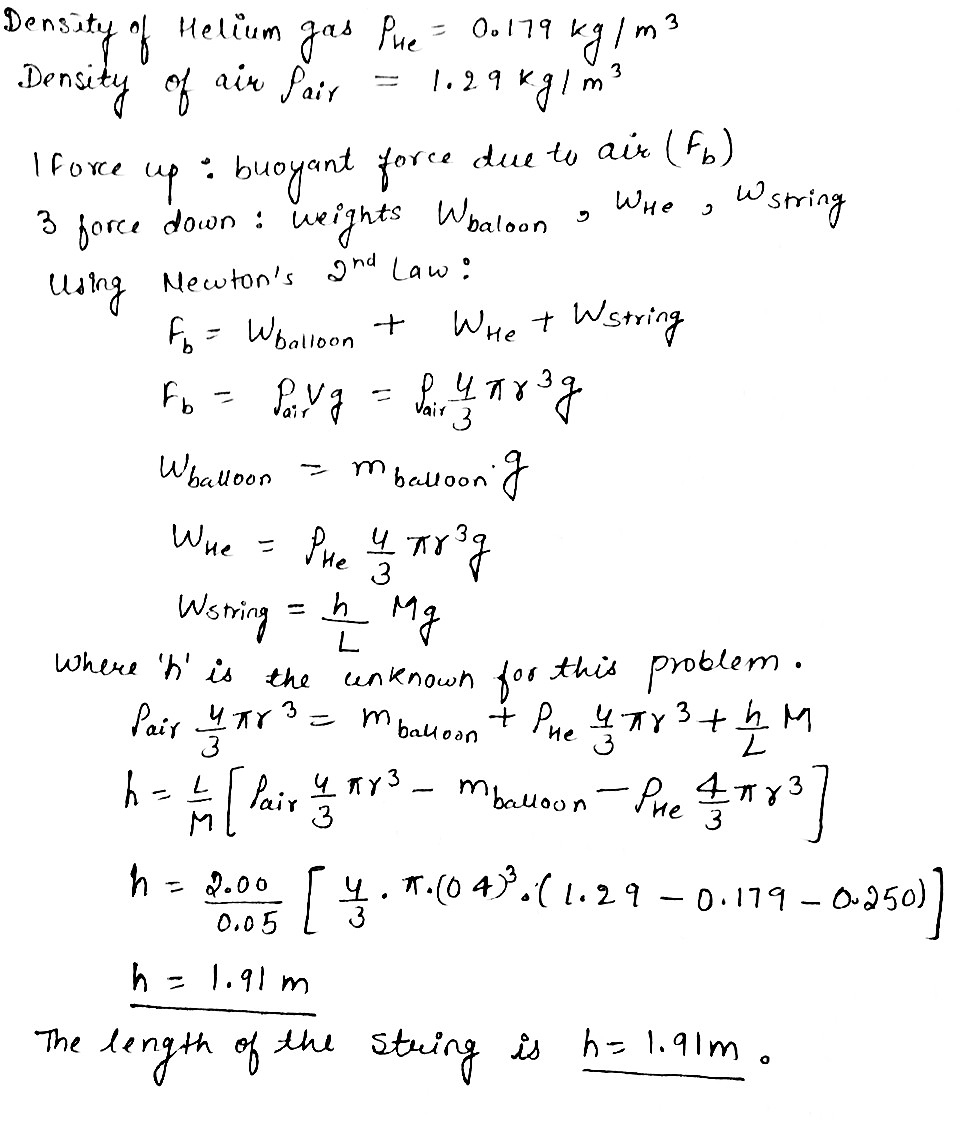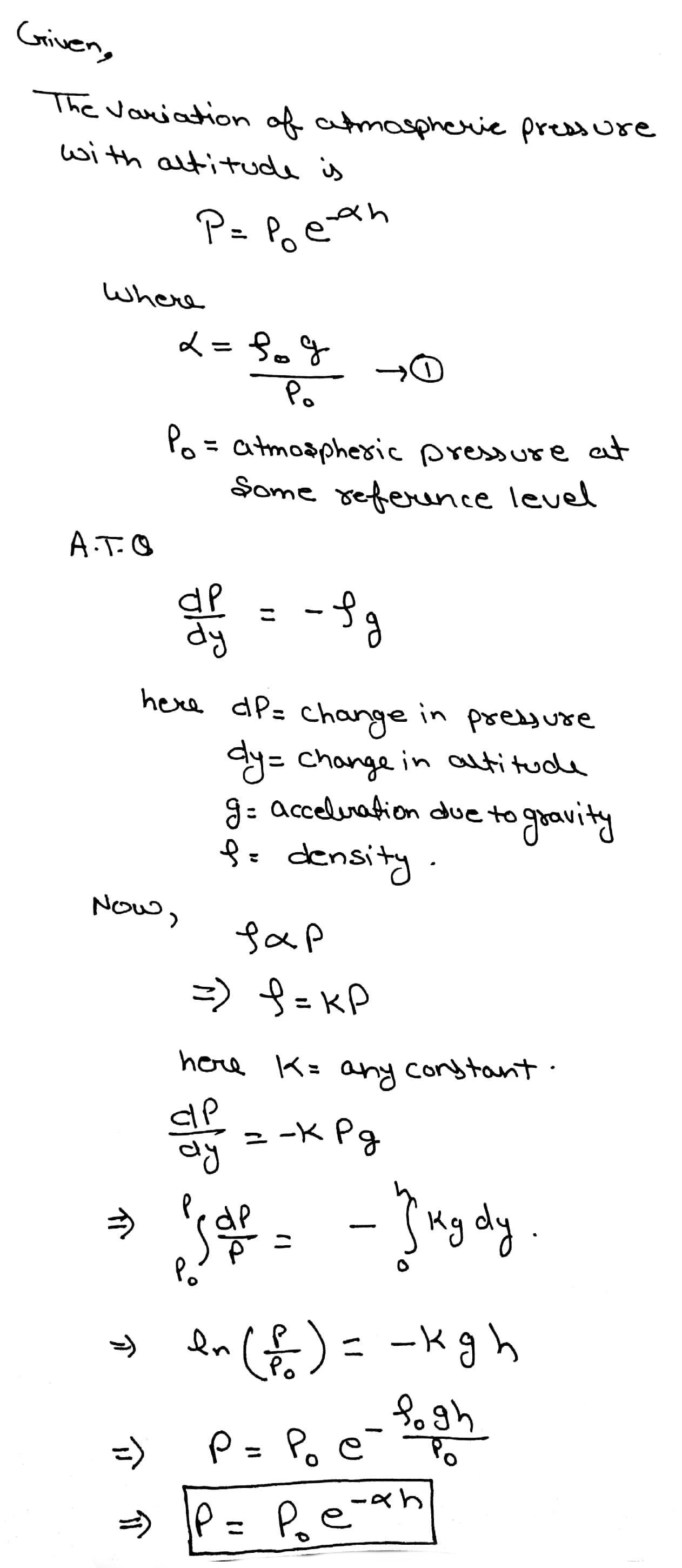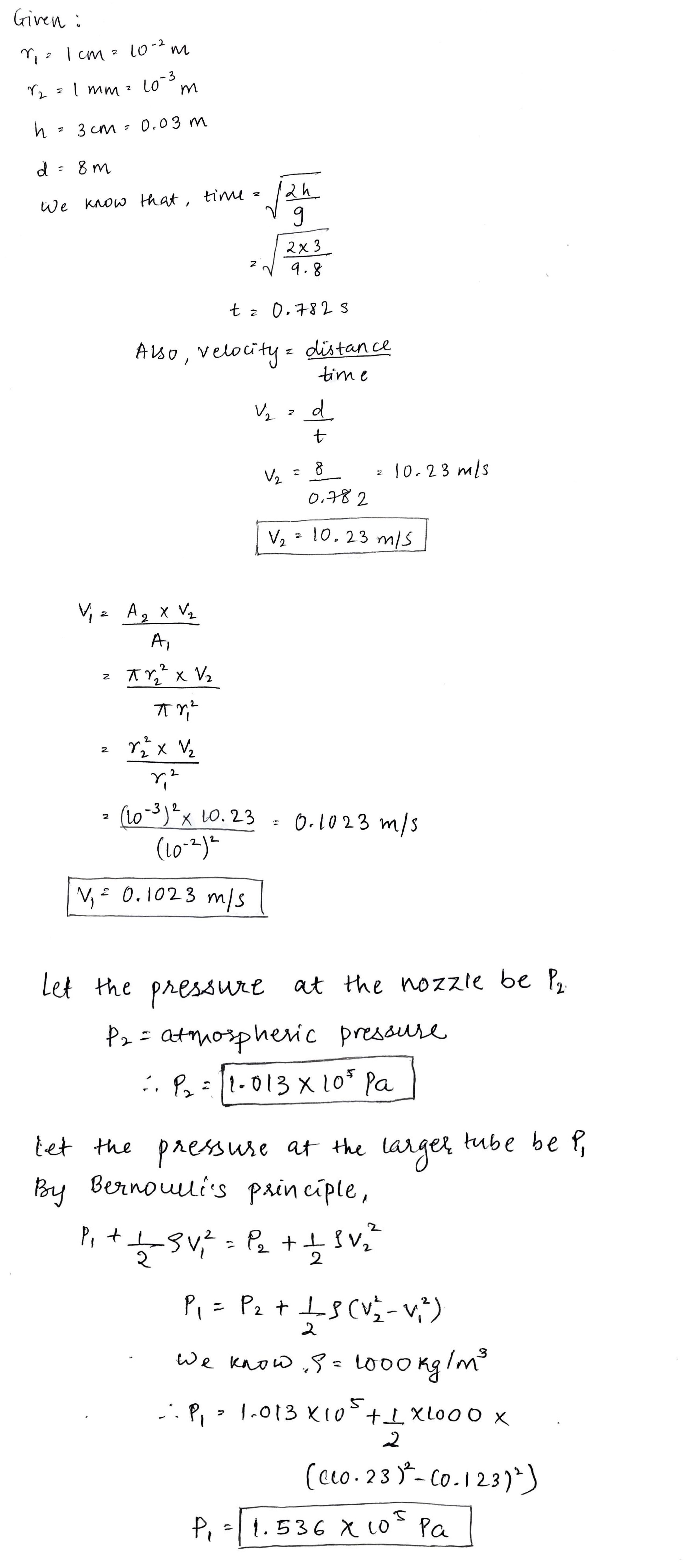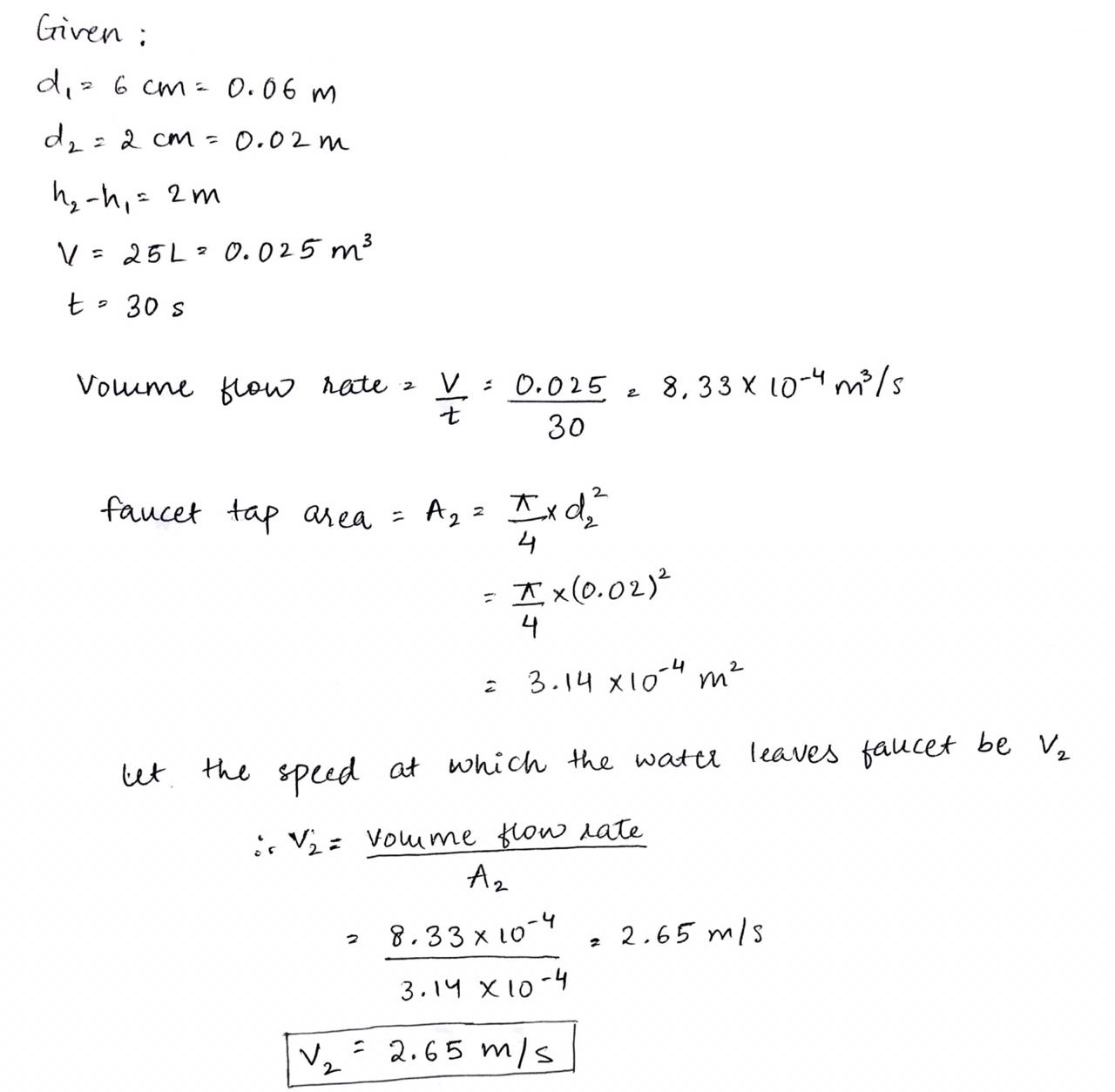Mechanical Properties Of Fluids - Class 11 Engineering Physics - Extra Questions
List 2 shows five systems in which two objects are labelled as X and Y. Also in each case a point P is shown. List 1 gives some statements about X and/or Y. Match these statements to the appropriate system(s) from List 2.
The type of flow in which there is a regular gradient of velocity in going from one layer to the next is called laminar flow.
If true enter 1, for false enter 0.
What force does water exert on the base of a house tank of base area $$1.5 m^2$$ when it is filled with water up to a height of 1 m?
[Density of water is $$10^3 kg m^{-3}$$ and $$g=10 m s^{-2}]$$
The press plungers of a Bramah (hydraulic) press is $$40cm^2$$ in cross-section and is used to lift a load of mass $$800 kg$$. What minimum force is required to be applied to the pump plunger if its cross-sectional area is $$0.02 m^2$$?
At what depth below the surface of water total pressure would be equal to $$1.5$$ atmosphere?
$$1\;atmosphere=10^5\;Nm^{-2}$$.
Why does a soft convertible top on a car bulges when the car travels at high speeds.
Sometimes you see a fountain of water rucshing out of the leaking joints (or holes) in the pipes of main water supply line in the city. Why does it happen?
Why do the tyres of a bicycle feel hard when air is filled in the tubes inside them.
What makes a balloon get inflated when air is filled in it?
What is the height of mercury which exerts the same pressure as $$20\;cm$$ of water column? Take density of mercury as $$13.6\;g/cc$$.
The areas of the pistons in a hydraulic machine are $$5{cm}^{2}$$ and $$625{cm}^{2}$$. What force on the smaller piston will support a load of $$1250N$$ on the larger piston?
In hydraulic machine, the two pistons are of area of cross section in the ratio $$1:10$$. What force is needed on the narrow piston to overcome a force of $$100N$$ on the wider piston?
If mercury height in a glass tube is $$50cm$$, find the pressure.
A hydraulic machine exerts a force of $$900N$$ on a piston of diameter $$1.80cm$$. The output force is exerted on a piston of diameter $$36cm$$. What will be the output force?
The radii of the press plunger and the pump plunger are in the ratio $$30:4$$. If an effort of $$32kgf$$ acts on the pump plunger. Find the maximum effort the press plunger can overcome. ( in kgf)
The space above the mercury column in a barometer contains_____ (mercury, water) vapour.
What is a Venturimeter? On what principle does the Venturimeter work?
Why do snow shoes stop you from sinking it into snow ?
Two small drops each of radius r coalesce to form a larger drop. Find energy of the new drop. (surface tension is T)
The average mass that must be lifted by a hydraulic press is 80 kg. If the radius of the larger piston is five times that of the smaller piston, what is the minimum force that must be applied?
Answer the following question in brief.
A plastic cube is released in water. Will it sink of come to the surface of water ?
Answer the following question in brief.
Why do the load carrying heavy vehicles have large number of wheels?
In the arrangement shown, a car of certain mass 'm' is in equilibrium by applying a force of 25 N. If the density of liquid taken is $$0.9 cm^{-3}$$, then find the mass of the car.
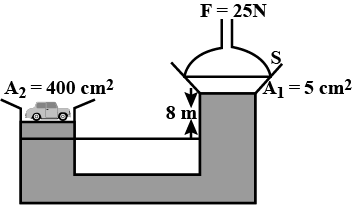
For the system shown in the figure, the cylinder on the left at $$L$$ has a mass of $$600 kg$$ and a cross sectional area of $$ 800 \ { cm }^{ 2 }$$. The piston on the right, at $$S$$, has a cross sectional area $$25 { cm }^{ 2 }$$ and negligible weight. If the apparatus is filled with oil. ( $$\rho= 75 gm/{ cm }^{ 3 }$$) Find the force $$F$$ required to hold the system in equilibrium.
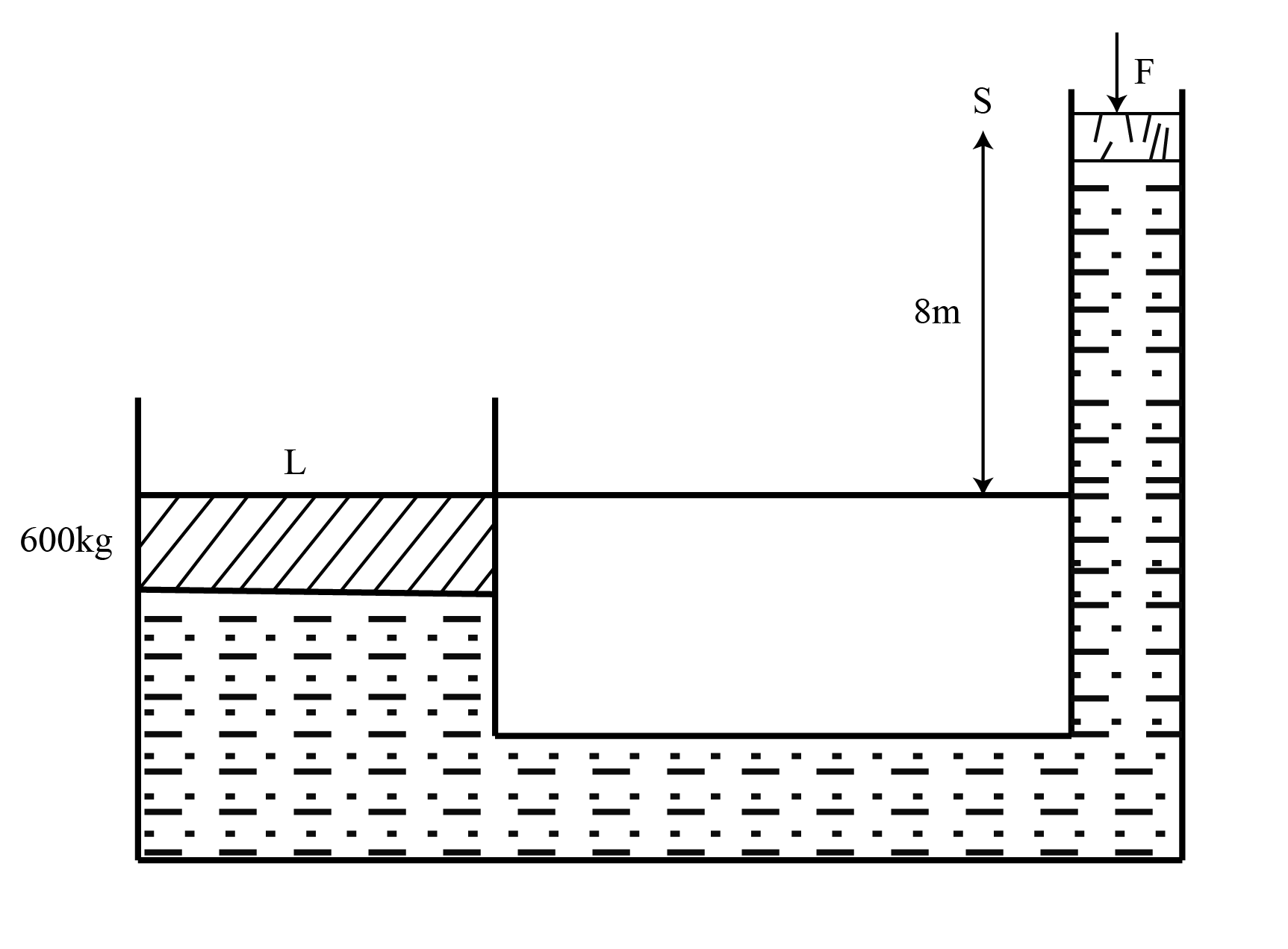
A spherical ball of density $$\rho$$ and radius $$0.003 m$$ is dropped into a tube containing a viscous fluid filled up to the $$0 cm$$ mark as shown in the figure. Viscosity of the fluid$$=1.2160 { N.m }^{ -2 }$$ and its density $${ \rho }_{ L }={ \rho }/2=1260 kg.{ m }^{ -3 }$$. Assume the ball reaches a terminal speed by the $$10 cm$$ mark. Find the time taken (in sec) by the ball to traverse the distance between the $$10 cm$$ and $$20 cm$$ mark. (g=acceleration due to gravity $$= 10 m{ s }^{ -2 }$$

A cylindrical vessel open at the top is $$20 cm$$ high and $$10 cm$$ in diameter. A circular hole whose cross-sectional area $$1{ cm }^{ 2 }$$ is cut at the centre of the bottom of the vessel. Water flows from a tube above it into the vessel at the rate $$100{ cm }^{ 3 }{ s }^{ -1 }$$. The height of water in the vessel under steady state (in cm) is
The height $$h$$ at which the hole should be punched so that the liquid travels the maximum distance $$x_m$$ initially is given as $$\frac {x}{4}H$$. Find $$x$$.
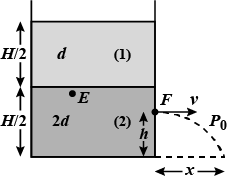
Determine the horizontal distance $$x$$ traveled by the liquid initially is given as $$=\sqrt {(3H-xh)h}$$. Find $$x$$.
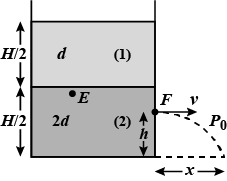
Calculate the energy spent in spraying a drop of mercury of radius $$R$$ into $$N$$ droplets all of same size. If the surface tension of mercury is $$T$$.
A rectangular tube of uniform cross section has three liquids of densities $$\rho_1, \rho_2$$ and $$\rho_3$$. Each liquid column has length l equal to length of sides of the equilateral triangle. Find the length x of the liquid of density $$\rho_1$$ in the horizontal limb of the tube, if the triangular tube is kept in the vertical plane
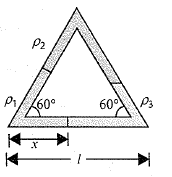
An open capillary tube contains a drop of water. When the tube is in its vertical position, the drop forms a column with a length of $$2cm$$. The internal diameter of the capillary tube is $$1mm$$. Determine the radii of curvature of the upper and lower meniscus in each case. Consider the wetting to be complete. Surface tension of water $$=0.0075N/m$$
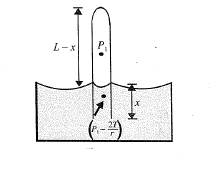
A force of $$50 kgf$$ is applied to the smaller piston of a hydraulic machine. Neglecting friction, The force exerted on the large piston, if the diameters of the piston are $$5 cm$$ and $$25 cm$$ respectively is $$'X' \ N$$. Find $$\cfrac{X}{250}$$
A U-tube of uniform cross-sectional area and open to the atmosphere is partially filled with mercury.Water is then poured into both arms. If the equilibrium configuration of the tube is as shown in figure with $$h_{2} = 1.0 cm$$, determine the value of $$h_{1}$$ .
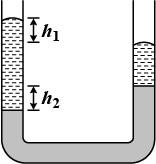
For the system shown in figure, the cylinder on the left, at L, has a mass of 600 kg and a cross-sectional area of $$800 cm^{2}$$. The piston on the right, at S, has cross-sectional area $$25 cm^{2}$$ and negligible weight. If the apparatus is filled with oil $$(p = 0.78 g/cm^{3})$$what is the force F required to hold the system in equilibrium?
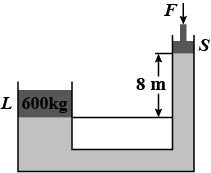
What is the time required for the same amount of water to flow out if the water level in tank is maintained always at a height of $$1 m$$ from orifice?
A tank having a small circular hole contains oil on top of water. It is immersed in a large tank of the same oil. Water flows through the hole. What is the velocity of this flow initially? When the flow stops, what would be the position of the oil-water interface in the tank from the bottom. The specific gravity of oil is $$0.5.$$
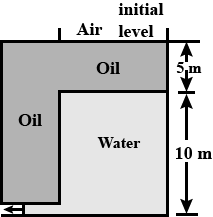
What is the time required to empty the tank through the orifice at the bottom?
A siphon tube is discharging a liquid of specific gravity $$0.9 $$ from a reservoir as shown in the figure find the velocity of the liquid through the siphon.
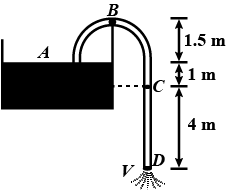
initial speed (in m/s) with which the water flows from the orifice.

Three holes $$A, B$$ and $$C$$ are made at depths $$1m, 2 m$$ and $$5 m$$ as shown. Total height of liquid in the container is $$8 m$$. Let v is the speed with which liquid comes out of the hole and $$R$$ the range on ground.Match the following two columns
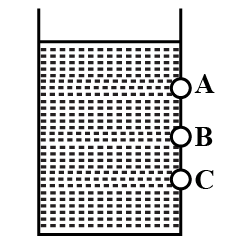
A long cylindrical tank of cross-sectional area $$0.5m^{2}$$ is filled with water. It has a small hole at a height $$50 cm$$ from the bottom. A movable piston of cross-sectional area almost equal to $$0.5 m^{2}$$ is fitted on the top of the tank such that it can slide in the tank freely. A load of $$ 20 kg$$ is applied on the top of the water by piston, as shown in the figure. Calculate the speed of the water jet with which it hits the surface when piston is $$1 m$$ above the bottom. (Ignore the mass of the piston).
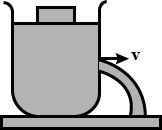
A siphon tube is discharging a liquid of specific gravity $$0.9 $$ from a reservoir as shown in the figure find the pressure at the highest point $$B$$.
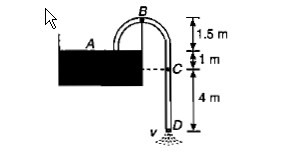
A siphon tube is discharging a liquid of specific gravity $$0.9 $$ from a reservoir as shown in the figure. Find the pressure at point $$C$$.

initial speed with which water strikes the ground.

When air of density $$1.3 kg/m^{3}$$ flows across the top of the lobe shown in the accompanying figure, water rises in the lobe to a height of $$1 .0 cm$$. What is the speed of the air?
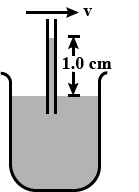
Water flows through the tube as shown in figure. The areas of cross-section of the wide and the narrow portions of the tube are $$ 5 cm^{2}$$ and $$2cm^{2}$$ respectively. The rate of flow of water through the tube is $$500cm^{3}/s$$. Find the difference of mercury levels in the U-tube.
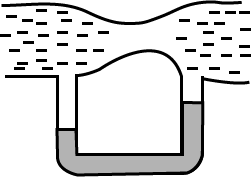
time taken to empty the tank to half its original value.$$(g = 10 m/s ^{2}) $$

What is the pressure drop (in mm Hg) in the blood as it passes through a capillary 1 mm long and $$2\mu m$$ in radius if the speed of the blood through the centre of the capillary is 0.66 mm/s ? (The viscosity of whole blood is $$4 \times 10^{-3}$$ poise).
The area of cross-section of a large tank is $$0.5 m^{2}$$ It has an opeoing near the bottom having area ofcross-section $$1 cm^{2}$$, A load of 20 kg is applied on the water at the top. Find the velocity of the water coming out of the opening at the time when the height of water level is 50 cm above the bottom. (Takeg$$= 10m/s^{2})$$
Water flows through a horizontal lobe as shown in figure , If the difference of heights of water column in the vertical lobes is $$2 cm$$ and the areas of cross-section at A and B are $$4 cm^{2}$$ and $$2cm^{2}$$ respectively. Find the rate of flow of water across any section.
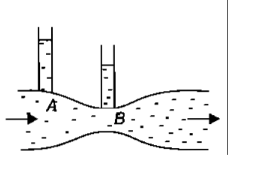
A water barrel stands ona table of heighth. lf a small hole is punched in the side of the barrel at its base, it is found that the resultant stream of water strikes the ground at a horizontal distance R from the barrel.What is the depth of water in the barrel?
Water is flowing smoothly through a closed-pipe system. At one point the speed of the water is $$3.0 m/s$$,while at another point $$1.0 m$$ higher the speed is $$4.0 m/s$$. If the pressure is $$20kPa$$ at the lower point, what is the pressure at the upper point? What would the pressure at the upper point be if the water were to stop flowing and the pressure at the lower point were $$18 kPa$$ ?
A typical river-borne silt particle has a radius of $$20 \mu m$$ and a density of $$ 2 \times 10^{3} kg/m^{3}$$. The viscosity of water is $$1.0\ \text{milli-poise}$$. Find the terminal speed with which such a particle will settle to the bottom of a motionless volume of water.
Two equal drops of water are falling through air with. steady velocity v. If the drops coalesced, what will be the new velocity ?
Velocity of a viscous liquid in long cylinder of radius R at a distance $$R_{1}$$ from centre is $$V_{1}$$ Find the velocity of the liquid as a function of the distance r from the axis of the cylinder,
Find the pressure exerted by a man weighing $$90\;kg$$ on the ground.
(a) when he is standing on one of his feet having an area of $$90\;cm^2$$.
(b) when he is lying flat. The area of his body in contact with the ground is $$0.9\;m^2$$. Given $$g=10\;ms^{-2}$$.
State a device that utilises 'Pascal's law' and also explain how it works.
What is the pressure exerted by a woman weighing $$500\;N$$ standing on one heel of area of $$1\;cm^2$$?
A glass is filled with water up to its brim and a thick hand card placed on top of it. Now keeping the card tightly closed and pressed with palm, the glass full of water is inverted and placed upside down. The palm is gently removed from the card. It is observed that the piece of card dose not fall off the glass though the glass is full of water and its whole weight is exerting pressure on the card. Why does it happen?
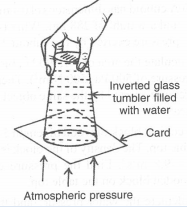
How can a scuba diver keep from floating back to the surface of the water?
In a test experiment on a model airplane in a wind tunnel, the flow speeds on the upper and lower surfaces of the wing are $$70\ ms^{-1}$$ and $$63\ ms^{-1}$$ respectively. What is the lift on the wing if its area is $$2.5$$ m$$^2$$ ? Take the density of air to be $$1.3\ kgm^{-3}$$.
A hydraulic automobile lift is designed to lift cars with a maximum mass of 3000 kg. The area of cross-section of the piston carrying the load is 425 cm$$^2$$. What maximum pressure would the smaller piston have to bear ?
What will be the pressure in $$dyne$$ $$ {cm}^{-2}$$, due to a water column of height $$12.5cm$$? ($$g=980cm$$ $${s}^{-2}$$) (density of water $${10}^{3}kg$$ $${m}^{-3}$$).
What is the magnitude of force required(in $$Newton$$) to produce a pressure of $$37500 \ Pa$$ in an area of $$300 \ {cm}^{2}$$?
A man weighing $$50kgf$$ is standing on a wooden plank of $$1m\times 0.5m$$. The pressure exerted by it on the ground will be ___________ (in Pa)
What will be the pressure in dyne $${cm}^{-2}$$, due to a water column of height $$10cm$$? [take $$g=980cm/{s}^{2}$$] (density of water$$={10}^{3}kg$$ $${m}^{-3}$$).
A brick with dimensions of $$20cm\times 10cm\times 5cm$$ has a weight $$500gwt$$. Calculate the pressure exerted by brick when the pressure is greatest?
The press plungers of a braman (hydraulic) press is $$40\ cm^{2}$$ in cross-section and is used to lift a load of mass $$800\ kg$$. What minimum force will be required to be applied on the pump plunger if its cross-sectional area is $$0.02\ m^{2}$$?
Force exerted by a truck is $$500000N$$ and the pressure on the ground is $$2500000Pa$$. Calculate the area of contact of tyres with ground?
A block wood is kept on table top. The mass wooden block is $$5kg$$ and its dimensions are $$40cm\times 20cm\times 10cm$$. Find the pressure exerted by the wooden block on the table top, if it is made to lie on the table top with its sides of dimension:
(a) $$20cm\times 10cm$$ and
(b) $$40cm\times 20cm$$
A force of $$50kgf$$ is applied to the smaller piston of a hydraulic machine. Neglecting friction, find the force exerted on the large piston, the diameters of the piston being $$5cm$$ and $$24cm$$ respectively.
Draw a neat, labelled diagram for a liquid surface in contact with a solid, when the angle of contact is acute.
A hydraulic lift at a service station can lift cars with a mass of $$3500\ kg$$. The area of cross section of the piston carrying the load is $$500\ cm^{2}$$. What pressure does the smaller piston experience? $$g = 9.8 m/s^{2}.$$
Two spherical soap bubbles collapses. If $$V$$ is the consequent change in volume of the contained air and $$S$$ is the change in the total surface area and $$T$$ is the surface tension of the soap solution, then if relation between $$P_{0}, V, S$$ and $$T$$ are $$\lambda P_{0}V + 4ST = 0$$, then find $$\lambda$$? (If $$P_{0}$$ is atmospheric pressure): Assume temperature of the air remain same in all the bubbles.
Two cylindrical vessels of equal cross-sectional area $$A$$ contain water upto heights $$h_{1}$$ and $$h_{2}$$. The vessels are interconnected so that the levels in them become equal. Calculate the work done by the force of gravity during the process. The density of water is $$\rho$$.
If $$A$$ denotes the area of free surface of a liquid and $$h$$ the depth of an orifice of area of cross-section $$a,$$ below the liquid surface, then find the velocity $$v$$ of flow through the orifice.
The diameter of a piston $$P_{2}$$ is $$50\ cm$$ and that of a piston $$P_{1}$$ is $$10\ cm$$. What is the force exerted on $$P_{2}$$ when a force of $$1\ N$$ is applied on $$P_{1}$$?
A container is filled with liquid upto height $$H$$ as shown in figure. There are $$2$$ holes in the container such that water coming out from them have same range. If the range of water coming out of the holes is half of maximum range, then find the distance $$x$$ between these holes.

The figure shows two immiscible liquids (Kerosens and water). Kerosene has density $$\rho_{2}$$ and water has density $$\rho_{1}$$. Find the velocity of water flow.
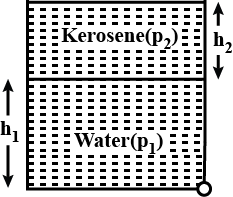
A fixed container of height $$'H'$$ with large cross-sectional area $$'A'$$ is completely filled with water. orifice of cross-sectional area $$'a'$$ are made, one at the bottom and the other on the vertical wall container at a distance $$H/2$$ from the top of the container. Find the time taken by the water level of a height of $$H/2$$ to get reduced to ground level .
A tank is filled with water up to a height $$H$$. Water is let out of a hole $$P$$ from one of the walls, at a depth $$D$$ below the surface of the water. Express the range of the efflux $$x$$ in terms of $$H$$ and $$D$$.
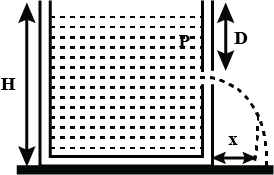
Two vertical parallel glass plates are partially submerged in water. The distance between the plates is d and the length is L. Assume that the water between the plates does not reach the upper edges of the plates and that the wetting is complete. To what height will the water rise? $$(\rho =$$ density of water and $$\sigma =$$ surface tension of water).
A large cylindrical tank of cross-sectional are $$1m^{2}$$ is filled with water. It has a small hole at a height of $$1m$$ from the bottom. A movable piston of mass 5kg is fitted on top of the tank such that it can slide in the tank freely. A load of 45kg is applied on the top of water piston as shown in figure. Find the value of v when piston is 7m above the bottom($$g=10m/s^{2}$$)
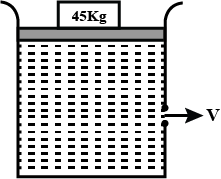
Spherical particles of pollen are shaken up in water and allowed to settle. The depth of water is $$2 \, \times \,10^{-2}$$ m. What is the diameter of the largest particles remaining in suspension one hour later? Density of pollen = $$1.8 \, \times \, 10^3 \, kg \, m^{-3}$$, viscosity of water = $$1 \, \times \, 10^{-2}$$ poise and density of water = $$1 \, \times \, 10^{3} \, kg \, m^{-3}.$$
A capillary tube is dipped in water vertically. It is long enough for the water to rise to the maximum height h in the tube. The length of portion immersed in water is l < h. The lower end of the tube is closed and then the tube is taken out and opened again. Will all the water flow out of tube? Explain.
The end of a capillary tube with a radius r is immersed in water. Is mechanical energy conserved when the water rises in the tube? The tube is sufficiently long. If not, calculate the energy change.
If a 5 cm long capillary tube with 0.1 mm internal diameter, open at both ends, is slightly dipped in water having surface tension 75 dyne/cm, state whether:
water will overflow out of the upper end of capillary. Explain your answer.
Two liquid gets coming out of the small holes at $$P$$ and $$Q$$ intersect at the point $$R$$. Find the position of $$R$$ if we maintain the liquid level constant.
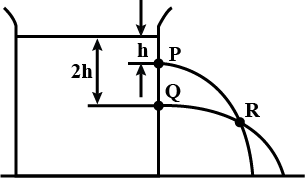
The area of cross section of the wider tube shown in fig. is 900 cm$$^2$$. If the body standing on the position weighs 45 kg, find the difference in the levels of water in the two tubes.
The flow rate of a water from a tap of diameter $$1.25\ cm$$ is $$0.48\ L/min$$. If the coefficient of viscosity of water is $$10^{-3}\ Pa\ s$$, what is the nature of flow of water?
Water is flowing through a horizontal tube. The pressure of the liquid in the portion where velocity is $$2\ m/s$$ is $$2\ m$$ of $$Hg$$. What will be the pressure in the portion where velocity is $$4\ m/s$$
The pressure of liquid column ____________ with the depth of column.
Calculate the amount of energy evolved when $$8$$ droplets of water of radius $$0.5\ mm$$ each combine into one. Surface tension of water is $$72\ dyne\ c{m}^{-1}$$.
Two cylindrical vessels fitted with pistons A and B of area of cross section 8 $$cm^2$$ and 320 $$cm^2$$ respectively are joined at their bottom by a tube and they are completely filled with water. When a mass of 4 kg is placed on piston A, find: (i) the pressure on piston A , (ii) the pressure on piston B, and (iii) the thrust on piston B.
find the angle of $${\phi _1}$$.
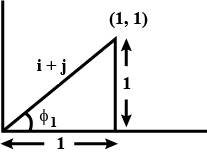
If an oil drop of density $$0.95\times 10^{3}\ kg\ m^{-3}$$ and radius $$10^{-4}\ cm$$ is falling in air whose density is $$1.3\ kg\ m^{-3}$$ and coefficient of viscosity is $$18\times \ 10^{-6}\ kg\ m^{-1}s^{-1}$$. Calculate the terminal speed of the drop.
What will be the terminal velocity of a steel ball of radius $$2\ mm$$ in glycerine?
A wind speed 40 m/s blows parallel to the roof of a house. The area of the roof is $$ 250 m^2 $$ Assuming that the pressure inside the house is atmospheric pressure,the force exerted by the wind on the roof and the direction of the force will be:
Water is flowing through a horizontal tube $$4\ km$$ in $$4\ cm$$ in radius at a rate of $$20\ litre\ s^{-1}$$ Calculate the pressure required to maintain the flow in terms of the height of mercury column.?
Rain drops, each of radius r, are falling through air with steady velocity v. If eight drops coalesce to form a big drop, then the big drop so formed will fall with velocity ?
A horizontal pipe line carries water in a streamline flow. At a point along the tube where the cross-sectional area is $$10^{-2}$$ $$m^2$$, the water velocity is $$2$$ $$ms^{-1}$$ and the pressure is $$8000$$ Pa. The pressure of water at another point where the cross-sectional area is $$0.5\times 10^{-2}m^2$$ is?
The density of the atmosphere at sea level is $$1.29kg/{m}^{3}$$ and $$g=9.8m/{s}^{2}$$. Assume that both do not change with altitude, how high should the atmosphere extend?
Two identical vessels with their bases at same level each contains a liquid of density $$\rho$$. The height of the liquid in one vessel in $$h_1$$ and that in other is $$h_2$$, the area of either bases is $$A$$. What is the work done by the gravity in equalizing the levels when two vessels are connected?
Two drops of equal radii are falling through air with a terminal velocity of $$5\ cm\ s^{-1}$$. If they coalesce into one drop, what will be the terminal velocity of the new drop?
Show that the pressure in a fluid at rest in same at all points if we ignore gravity.
A body of mass $$2 kg$$ is let fall from top of a $$10 m$$ tall building. It lands on a sandy patch of ground and burries itself $$20 cm$$ deep in the sand. Find the average resistance offered to it by the sand. Also find the approximate time of penetration.
In a venturimeter, the diameter of the pipe is $$4\ cm$$ and that of constriction is $$3\ cm$$. The heights of the liquid of density $$1.5\ gm/cc$$ in the pressure tube is $$20\ cm$$ at the pipe and $$5\ cm$$ at the constrictions. What is the discharge rate of water flowing inside the pipe?
Derive expression for terminal velocity when a ball of radius r is dropped thrugh a liquid of viscousity $$\eta$$ and density $$\rho$$.
Equal volumes of two immiscible liquids of densities p and 2p are filled in a vessel as shown in the figure. Two small holes are punched at depth$$\dfrac{h}{2}$$and$$\dfrac{3h}{2}$$ from the surface of lighter liquid. If $${{v}_{1}}$$ and $${{v}_{2}}$$ are the velocities of efflux at these holes, then $$\dfrac{{{v}_{1}}}{{{v}_{2}}}$$ will be:

Water rises to a height of 10 cm in a capillary tube and mercury falls to a depth of the same capillary tube. If the density of water is 1 gm/c.c and its angle of contact is $$0^{\circ}$$, then the ratio of such of two liquids is ( cos$$135^{\circ}$$=0.7)
When the system shown in the adjoining fig. is in equilibrium and the areas of cross sec. of the small and big piston are $$'a'$$ and $$'10a'$$, then what is the value of $$m/M$$?

What is the effect of temperature on angle of contact?
Calculate the work done in blowing a soap bubble from a radius of $$2\ cm$$ to $$3\ cm$$. The surface tension of the soap solution is $$30\ dyne\ cm^{-1}$$.
Water is flowing through a pipe of non unifrom cross section. at the point when the velocity of flow is 35 cm/s, the pressure is 1 cm of mercury. What is the pressure at the point where the velocity of flow is 65 cm/s?(0.887 cm of mercury)
The flow rate of water from a tap of diameter $$1.25$$ cm is $$0.48$$ $$L/min$$. the coefficient of viscosity of water is $${ 10 }^{ -3 }$$ $$Pa-s$$. After sometime, the flow rate is increased to $$3$$ $$L/min$$. Characterize the flow for both the flow rates.
The area of a man's foot is $$80\ \mathrm { cm } ^ { 2 }$$. How much pressure will the man exert on the ground, while standing, if the weight is $$800\ N$$?
What is the pressure on a swimmer 10 m below the surface of a lake?
Write any two practical applications of stoke's law.
If pressure at half depth of a lake is equal to $$2/3$$ pressure at the bottom of the lake that what is the depth of the lake
The height of mercury in a barometer is 760 mm, then the atmospheric pressure is $$\left[ g=9.8m/{ s }^{ 2 } \right] $$
Find the force exerted by the water on a $$2\ m^{2}$$ plane surface of a large stone placed at the bottom of a sea $$500\ m$$ deep. Does the force depend on the orientation of the surface?
A beaker of liquid accelerates from rest, on a horizontal surface, with acceleration $$a$$ to the right.
How does the pressure vary with depth below the surface?
Hovering over the pit of hell, the devil observed that as a student falls past ( with terminal velocity ), the frequency of the scream decreases from $$842$$ to $$820\ Hz$$.
Find the speed of descent of the student.
A rocket ejects the fuel (hot gases) of density $$\rho$$ from the chamber which is maintained at a pressure $${P}_{1}$$, say. The atmospheric pressure is $${P}_{0}$$. If the base area of the cylindrical chamber is $${A}_{1}$$ and the area of the hole through which hot gases escape from the rocket is $${A}_{2}$$, find $$(a)$$ velocity of efflux of the fuel, $$(b)$$ thrust exerted on the rocket given by the escaping fuel.
Bernoulli's equation can be written in the following different forms (Column I). Column II lists certain units each of which pertains to one of the possible forms of the equation. Match the unit associated with each of the equation.
A pressure of 10 Pa acts on an area of $$3.0 m^2$$. What is the force acting on the area? What force will be exerted by the application of same pressure if the area is made one-third?
A partially evacuated airtight container has a tight-fitting lid of surface area $$77\hspace{0.05cm}m^2$$ and negligible mass. If the force required to remove the lid is $$480\hspace{0.05cm}N$$ and the atmospheric pressure is $$1.0 \times 10^5\hspace{0.05cm}Pa$$, what is the internal air pressure?
Water flows through a fire hose of diameter $$6.35\ cm$$ at a rate of $$0.0120\ m^{3}/s$$. The fire hose ends in a nozzle with an inner diameter of $$2.20\ cm$$. What is the speed at which the water exists the nozzle?
The plastic tube in Figure has across-sectional area of $$5.00\hspace{0.05cm}cm^2$$.The tube is filled with water until the short arm (of length $$d= 0.800\hspace{0.05cm}m$$) is full. Then the short arm is sealed and more water is gradually poured into the long arm. If the seal will pop off when the force on it exceeds $$9.80\hspace{0.05cm}N$$ , what total height of water in the long arm will put the seal on the verge of popping?

Why would an aircraft be unable to fly on the moon?
An incompressible, nonviscous fluid initially rests in the vertical portion of the pupe shown in Fig $$3.55$$ (a) where $$L=2.00\ m$$. When the valve is opened, the fluid flows into the horizontal section of the pipe. What is the speed of the fluid when all of its is in the horizontal section as in Fig $$3.55$$ (b)? Assume that the cross-sectional area of the entire pipe is constant.
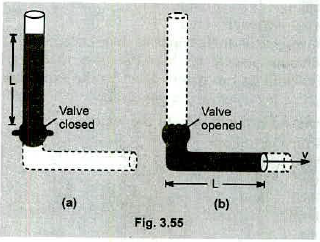
A large storage tank is filled to a height $$h_{0}$$. The tank is punctured at a height $$h$$ above the bottom of the tank (Fig $$3.57$$). Find an expression for how far from the tank the exiting stream lands.
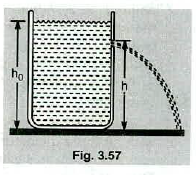
An office window has dimensions $$3.4\hspace{0.05cm}m$$ by $$2.1\hspace{0.05cm}m$$. As a result of the passage of a storm, the outside air pressure drops to $$0.96\hspace{0.05cm}atm$$, but inside the pressure is held at $$1.0\hspace{0.05cm}atm$$. What net force pushes out on the window?
What should be the ratio of area of cross section of the master cylinder and wheel cylinder of a hydraulic brake so that a force of 15N can be obtained at each of its brake show by exerting a force of 0.5N on the pedal ?
A vessel contain water up to a height of 1.5m.Taking the density of water $$ 10^{3}kg m^{-3} $$ acceleration due to gravity $$ 9.8ms^{-2} and area of base vessel $$ 100^{2}, calculate ;
the pressure and
A normal force of $$ 200 N $$ acts on an area of $$ 0.02 m^2 $$ Find the pressure in pascal.
A man first swims in sea water and then in river water. Where does he find it easier to swim and why?
A block of iron of mass 7.5 kg and of dimension $$ 12cm\times8cm\times 10cm $$ is kept on a table top on its base of side $$ 12cm \times8cm $$. Calculate :
pressure exerted on the table top. Take 1kg = 10N
A pitot tube on a high-altitude aircraft measures a differential pressure of 180 Pa. What is the aircrafts airspeed if the density of the air is $$0.031\hspace{0.05cm} kg/m^3?
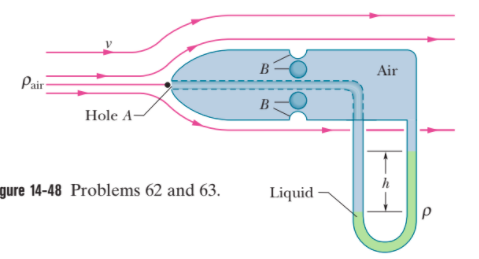
Water is moving with a speed of $$5.0\hspace{0.05cm}m/s$$ through a pipe with a cross-sectional area of $$4.0\hspace{0.05cm}cm^2$$. The water gradually descends 10 m as the pipe cross-sectional area increased to $$8.0\hspace{0.05cm}cm^2$$. (a)What is the speed at the lower level?
(b)If the pressure at the upper level is $$1.5\times 10^5 \hspace{0.05cm}Pa$$, what is the pressure at the lower level?
The diagram in figure shows a device which makes use of the principal of transmission of pressure.
Name the parts labelled by the letters X and Y.
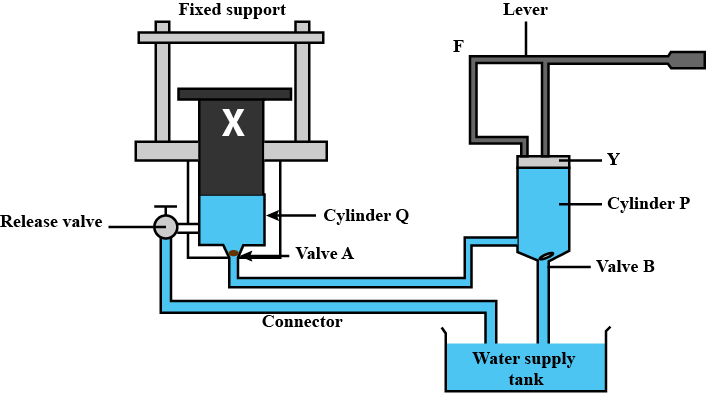
Two cylindrical vessels fitted with pistons A and B of area section $$ 8cm^{2}$$ and $$320cm^{2} $$ respectively are joined at their bottom by a tube and they are completely filled with water. When a mass of $$4kg$$ is placed on piston A, find the pressure on piston A,
A hammer exerts a force of 1.5 N on each of the two nails A and B. The area of cross section of to of nail A is $$2mm^{2}$$ while that of nail B is $$6mm^{2}$$. Calculate pressure on each nail in pascal.
What force is applied on a piston of area of cross section $$2cm^{2}$$ to obtain a force $$150N$$ on the piston of area of cross section $$12cm^{2}$$ in a hydraulic machine?
Write the numerical value of the atmospheric pressure on the surface of the earth in pascal.
Why is the meant by the statement 'the atmospheric pressure at a place is $$76$$ cm of Hg ? State its value in Pa.
The areas of pistons in a hydraulic machine are $$ 5 cm^{2} and 625 cm^{2} $$ What force on the smaller piston will support a load of 1250N on the larger piston? State any assumption which you make in your calculation.
Assumption:There is no friction and no leakage of liquid.
Explain shape of meniscus for different liquids in capillary.
Derive a formula to measure the rate of flow of a liquid through venturi meter.
What is the effect on angle of contact on mixing soap solution in water?
Water is flowing through a non-uniform cross-sectional area pipe. In pipe where the velocity of water is 0.4 m/s, pressure 0.1 m of mercury. A another place, where velocity of water is 0.5 m/s, calculate the value of pressure.
Name the forces which are responsible for shape of liquid surface in a capillary tube.
Why does the speed of a liquid increase and its pressure decrease when a liquid passes through a constriction in a horizontal pipe?
A force of 1 kN is applied on a road surface by the tyre of a car. If the contact area of the tyre is $$10\,cm^2$$, find the pressure on the contact area.
The pressure of water inside a closed pipe is $$3 \times 10^5 \ N/m^2$$. This pressure reduces to $$2 \times 10^5 \ N/m^2$$ on opening the valve of the pipe. Calculate the speed of water flowing through the pipe..[Density of water $$1000 kg/m^0$$].
Explain why:
Water with detergent dissolved in it should have small angles of contact.
Fill in the blanks using the word(s) from the list appended with each statement:
For the model of a plane in a wind tunnel, turbulence occurs at a .. speed for turbulence for an actual plane (greater / smaller).
With what velocity does water flow out of an orifice in a tank with gauge pressure $$4 \times 10^5 \ N/m^2$$ before the flow starts? Density of water = $$1000 \ kg/m^3$$.
An air bubble of radius $$0.2 \ mm$$ is situated just below the water surface. Calculate the gauge pressure. Surface tension of water = $$7.2 \times 10^{-2} \ N/m$$
Explain why
The angle of contact of mercury with glass Is obtuse, while that of water with glass is acute.
Find the pressure $$200 \ m$$ below the surface of the ocean if pressure on the free surface of liquid is one atmosphere. (Density of sea water = $$1060 \ kg/m^3$$)
The speed of water is $$2 \ m/s$$ through a pipe of internal diameter $$10 \ cm$$. What should be the internal diameter of the nozzle of the pipe if the speed of the water at nozzle is $$4 \ m/s$$?
Explain why water with detergent dissolved in it should have small angles of contact.
Derive an expression for the velocity of the fluid at a wide neck in a venturi meter.
What is a venturi meter? Name two applications.
State Stokes law? What are the factors on which viscous drag depends?
What is terminal velocity? What are the factors on which terminal velocity depends?
An open tank contains water up to a depth of $$3m$$ and above it an oil of sp.gr $$0.9$$ for a depth of $$1m$$. Find pressure intensity
- at the interface of two liquids
- at the bottom of the tank.
A hole of area $$2$$ mm opens near the bottom of a large water storage tank and a stream of water shoots from it. If the top of the water in the tank is to be kept $$30$$ m above leaking point, how much water in liters Is should be added to the reservoir tank to keep this level? Take $$g = 10\,m/s^2$$
Diameter of a ball A is thrice that of B. What will be the ratio of their terminal velocities in the water?
Define terminal velocity. Give reasons why a sphere attains this velocity. Derive a relation for the terminal velocity.
What do you mean by the angle of contact of a liquid with a solid surface? What are the factors that affect it?
Why is there a continuous flow of water the valve is opened?
Calculate the total energy possessed by one kg of water at a point where pressure is $$30\,gm\,wt/sq.mm$$. The velocity of $$0.1\, ms^{-1}$$ and height is $$60$$ cm above the ground.
On which law, hydraulic break works? Name other three devices that works on the basis of this law. State the law.
In the bottom of a vessel with mercury there is a round hole of diameter $$d = 70 \mu m$$. At what maximum thickness of the mercury layer will the liquid still not flow out through this hole?
When a drop of mercury of radius R is split into n similar drops, What is the change in surface energy? Assume as the surface tension of the mercury.
Are you able to balance with 1N at Y?
Water flows through a horizontal pipe of varying cross-section. If the pressure is $$1$$ cm of mercury when the velocity is $$0.35$$ m/s. Find the pressure at a point where velocity is $$0.65$$ m/s.
Press slightly on the end X. What do you observe.
The container shown in the figure below is filled with a liquid of density $$\rho$$. Note that the container has height $$h_1$$ and area of cross-section $$A_1$$ for the upper half height $$h_2$$ and area of cross-section $$A_2$$ for the lower half. Find:
- The pressure at the base of the container.
- Force exerted by the liquid on the base of the container.
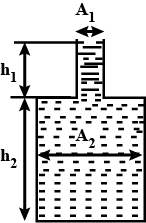
The area of one end of a U-tube is $$0.01 \,m^2$$ and that of the other end the force $$1 \,m^2$$, When a force was applied on the liquid at the first end?
Find the pressure in an air bubble of diameter $$d = 4.0 \mu m$$, located in water at a depth $$h = 5.0 m$$. The atmospheric pressure has tho standard value $$P_0$$.
You are a passenger on a spacecraft. For your survival and comfort, the interior contains air just like that at the surface of the Earth. The craft is coasting through a very empty region of space. That is, nearly perfect vacuum exists just outside the wall. Suddenly, a meteoroid pokes a hole, about the size of a large coin, right through the wall next to your seat. (a) What happens?
(b) Is there anything you can or should do about it?
Let us suppose that a planet of mass M and radius r is surrounded by an atmosphere of constant density, consisting of a gas of molar mass R.Determine the temperature T of the atmosphere on the surface of the planet if the height of the atmosphere is $$h\,(h << r)$$.
Find the increment of the free energy of the surface layer when two identical mercury droplets, each of diameter $$d = 1.5 \ mm$$, merge isothermally.
Answer the question:
The diagram shows a simple mercury barometer, used to measure atmospheric pressure.
Atmospheric pressure decreases.
Which row states what happens to the pressure at point P and what happens to the level L ?
| Pressure at P | level L | |
| A | decreases | falls |
| B | decreases | rises |
| C | stays the same | falls |
| D | stays the same | rises |
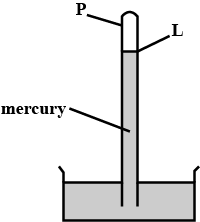
Review. Inside the wall of a house, an L-shaped section of hot-water pipe consists of three parts: a straight, horizontal piece h = 28.0 cm long; an elbow; and a straight, vertical piece = 134 cm long. A stud and a second story floorboard hold the ends of this section of copper pipe stationary. Find the magnitude and direction of the displacement of the pipe elbow when the water flow is turned on, raising the temperature of the pipe from $$18.0^0C $$ to $$46.5^0C$$.
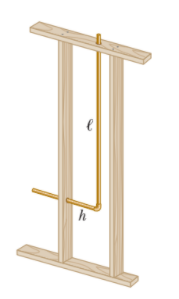
A backyard swimming pool with a circular base of diameter $$6.00\ m$$ is filled to depth $$1.50\ m$$.
Find the absolute pressure at the bottom of the pool.
A cylindrical vessel of height $$500 \ mm$$ has an orifice (small hole) at its bottom. The orifice is initially closed and water is filled in it upto height $$H$$. Now the top is completely sealed with a cap and the orifice at the bottom is opened. Some water comes out from the orifice and the water level in the vessel becomes steady with the height of water column being $$200 \ mm$$. Find the fall in height (in mm) of water level due to the opening of the orifice.
[Take atmospheric pressure $$=1.0\times 10^{5}\mathrm{N}/\mathrm{m}^{2}$$, density of water $$=1000\mathrm{k}\mathrm{g}/\mathrm{m}^{3}$$ and $$\mathrm{g}=10\mathrm{m}/\mathrm{s}^{2}$$ Neglect any effect of surface tension.]
A large tank is filled with two liquids of specific gravities $$2\sigma$$ and $$\sigma$$. Two holes are made on the wall of the tank as shown. Find the ratio of the distances from $$O$$ of the points on the ground where the jets from holes $$A$$ & $$B$$ strike.
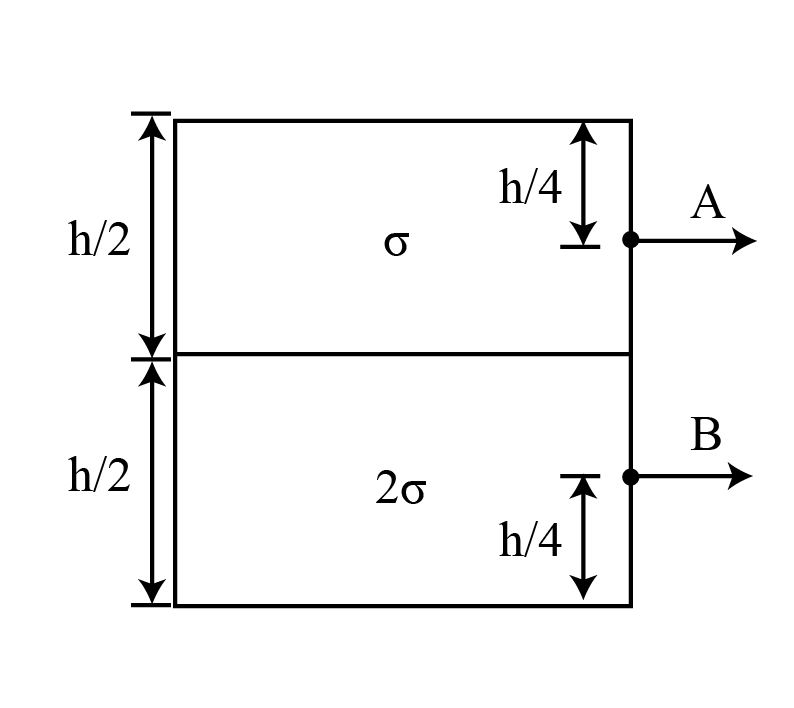
A tank with a small orifice contains oil on top of water. It is immersed in a large tank of the same oil. Water flows through the hole. Assuming the level of oil outside the tank above orifice does not change. a. What is the velocity of this flow initially? b. When the flow stops, what would be the position of the oil-water interface in the tank? c. Determine the time at which the flow stops. Density of oil $$=800 kg/m^3$$.

A bent tube is lowered into a water stream as shown in figure above. The velocity of the stream relative to the tube is equal to $$v=2.5\:m/s$$. The closed upper end of the tube located at the height $$h_0=12\:cm$$ has a small orifice. The height $$h$$ the water jet spurt?
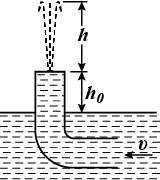
$$n$$ drops of water, each of radius $$2\ mm$$, fall through air at a terminal velocity of $$8\ cm/s$$. If they coalesce to form a single drop, then the terminal velocity of the combined drop is $$32\ cm/s$$. The value of $$n$$ is
A wide vessel with a small hole in the bottom is filled with water and kerosene. Neglecting the viscosity, find the velocity of the water flow, if the thickness of the water layer is equal to $$h_1=30\:cm$$ and that of the kerosene layer to $$h_2=20\:cm$$.
A Pitot tube (Shown in figure above) is mounted along the axis of a gas pipeline whose cross-sectional area is equal to $$S$$. Assuming the viscosity to be negligible, the volume of gas flowing across the section of the pipe per unit time, if the difference in the liquid columns is equal to $$\Delta h$$, and the densities of the liquid and the gas are $$\rho_0$$ and $$\rho$$ respectively.

A side wall of a wide open tank is provided with a narrowing tube (figure shown above) through which water flows out. The cross-sectional area of the tube decreases from $$S=3.0\:cm^2$$ to $$s=1.0\:cm^2$$. The water level in the tank is $$h=4.6\:m$$ higher than that in the tube. Neglecting the viscosity of the water, find the horizontal component of the force tending to pull the tube out of the tank (in $$N$$). Round off to the closest integer.

When a sphere of radius $$r_1=1.2\ \text{mm}$$ moves in glycerin, the laminar flow is observed if the velocity of the sphere does not exceed $$v_1=23\ \text{cm/s}.$$ At what minimum velocity $$v_2\ ($$in $$\mu\ \text{m/s}\ )$$ of a sphere of radius $$r_2=5.5\ \text{cm}$$ will the flow in water become turbulent? The viscosities of glycerin and water are equal to $$\eta_1=13.9\:P$$ and $$\eta_2=0.011\:P$$ respectively.
A non-viscous liquid of constant density $$1000 kg/m^{3}$$ flows in a streamline motion along a tube of variable cross section, The tube is kept inclined in the vertical plane as shown in the figure, The area of cross-section of the tube at two points P and Q at heights of $$2 m $$and $$5 m$$ are respectively $$4 \times 10^{-3} m^{2}$$ and $$ 8 \times 10^{-3}m^{2}$$. The velocity of the liquid at point $$P$$ is $$1 m/s.$$ Find the work done per unit volume by the pressure and the gravity forces as the fluid flows from point P to Q, Take $$g = 9.8 m/s^{"2}$$
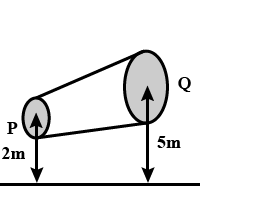
In the arrangement shown in figure above viscous liquid whose density is $$\rho=1.0\:g/cm^3$$ flows along a tube out of a wide tank $$A$$. Find the velocity (in m/s) of the liquid flow, if $$h_1=10\:cm$$, $$h_2=20\:cm$$, and $$h_3=35\:cm$$. All the distances $$l$$ are equal.
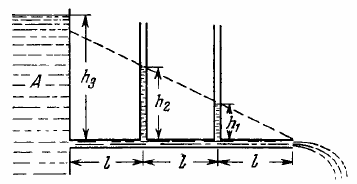
On the opposite sides of a wide vertical vessel filled with water two identical holes are opened, each having the cross-sectional area $$S=0.50\:cm^2$$. The height difference between them is equal to $$\Delta h=51\:cm$$. If the resultant force of reaction of the water flowing out of the vessel.
A rectangular tank of height $$6 m$$ filled with water is placed near the bottom of an incline of angle $$\displaystyle 30^{\circ}$$. At height $$x$$ from bottom a small hole is made (as shown in figure ) such that stream coming out from hole strikes the inclined plane normally. Find $$x$$ in meter .
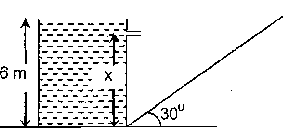
In the figure shown, cylinder 'A' has pump piston, whereas B and C cylinders have lift pistons. If the maximum weight that can be placed on the pump piston is $$50\ kgwt$$ what is the maximum weight that can be lifted by the piston in the cylinder 'B'. Find the total mechanical advantage. (Take $$g = 10\ m\ s^{-2})$$
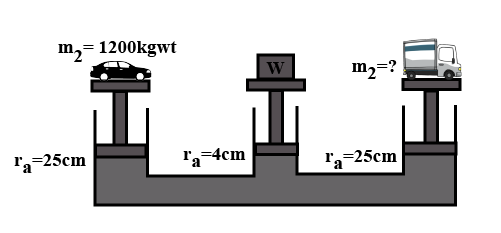
A cylindrical vessel of height $$500$$mm has an orifice(small hole at its bottom). The orifice is initially closed and water is filled in it up to height H. Now the top is completely sealed with a cap and the orifice at the bottom is opened. Some water comes out from the orifice and the water level in the vessel becomes steady with height of water column being $$200$$mm. Find the fall in height (in mm) of water level due to opening of the office. [Take atmospheric pressure $$=1.0\times 10^5N/m^2$$, density of water $$=1000$$ kg$$/m^3$$ and $$g=10m/s^2$$. Neglect any effect of surface tension].
The figure shows two immiscible liquids(Kerosene and water). Kerosene has density $$\rho_2$$ and water has density $$\rho_1$$. Find the velocity of water flow.
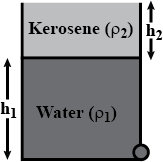
Water shoots out a pipe and nozzle as shown in the figure. The cross-sectional area for the tube at point $$A$$ is four times that of the nozzle. The pressure of water at point $$A$$ is $$41\times 10^{3}Nm^{-2}$$ (guage). If the height $$'h'$$ above the nozzle to which water jet will shoot is $$x/10$$ meter than $$x$$ is. (Neglect all the losses occurred in the above process) $$[g= 10m/s^{2}]$$.
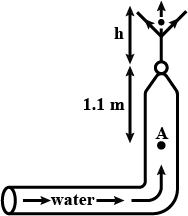
Water stands at a height H in a tall cylinder (see figure). Two holes A and B are made on the sides of the cylinder. If hole A is at a height $$h$$ above the ground, what is the height of hole B above the ground so that the two streams of water emerging from holes A and B strikes the ground at the same point?
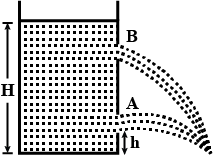
If n identical water droplets falling under gravity with terminal velocity v coalesce to form a single drop which has the terminal velocity $$4$$v, find the number n.
Find the pressure in the circular water pipe shown in the figure .
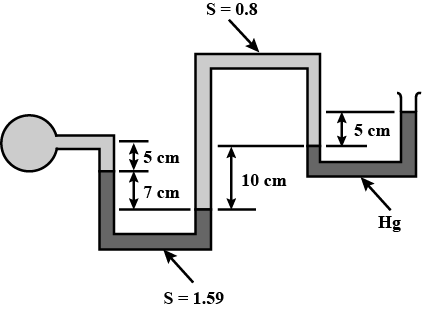
Water is filled to a height of $$2.5\ m$$ in a container lying at rest on a horizontal surface as shown in the figure. The bottom of the container is square shaped of side $$\sqrt { 3 }\ m$$ and its top is open. There is a very small hole in the vertical wall of the container near the bottom. A small cap closes the hole. The hole gets opened when pressure near the bottom becomes more than $$4\times { 10 }^{ 4 }$$ pascal.
(a) What minimum acceleration can be given to the container in the positive $$x-$$ direction so that the cap will came out of the hole? Assume water dose not spill out of container when the container accelerates.
(b) Find the velocity of efflux as soon as the container starts moving with the acceleration calculate in part (a) of the question.
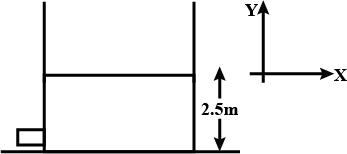
Two tubes of length $${ l }_{ 1 }$$ ,$${ l }_{ 2 }$$ and radius $${ r }_{ 1 }$$,$${ r }_{ 2 }$$ are connected in series, and allowed to carry a liquid $$\eta$$ through it. If $${ p }_{ 1 }$$ and $${ p }_{ 2 }$$ are the pressure at the two extreme ends, calculate the pressure at the junction.
Find the area of a body which experiences a pressure of $$50,000\ Pa$$ by a thrust of $$100\ N$$.
How much force should be applied on an area of $$10^{-4} m^2 $$ to get a pressure of $$15 Pa $$ ?
There is a uniform tube of cross-section area . A Liquid of density $$\rho$$ is flowing in the tube flowing with uniform speed $$v$$. Wat will be the force applied by liquid at the bend ?$$\theta=^{o}$$
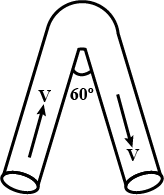
Explain the relation between the area of contact and pressure exerted on a body.
The doctor prescripts to a patient an infusion of $$30 mg/h $$ . You gave a bag of $$200 mg $$ in $$50 ml$$ . At what rate $$(ml/min)$$ do you set the pump?
Do liquids exert pressure on the sides of the container they are kept in? Justify.
An aeronautical engineer observed that on the upper and lower surfaces of the wings of an aeroplane, the speed of the air are $$90m/s$$ & $$72 m/s $$ respectively. What is the left on the wing if its area is $$3.2 m^2 $$ density of air is $$0.29 kg/m^3$$
A small hole is made at the bottom of a symmetrical jar, as shown in figure. A liquid is filled into the jar up to a certain height. The rate of fall of liquid is independent of the level of liquid in the jar. The surface of jar is a surface of revolution of the curve $$y=kx^{n}$$. The value of $$n$$ is ?

A solid cube of dimensions $$50\ cm \times 50\ cm $$ and weighing $$25\ N$$ placed on a table. Calculate the pressure exerted on the table.
Air stream horizontally across an aeroplane wing of area 3m$$^{2}$$ weighing 250 kg. The air speed is 60 m/s and 45 m/s over respectively. What is the lift on the wing ? (Density of air 1.293 g/1)
A water hose 2 cm in diameter is used to fill a 20 litre bucket. If it takes 1 minute to fill the bucket, then the speed v at which the water the water leaves the hose is,
Find the terminal velocity of a steel ball of diameter $$0.2 cm$$ when it falls through a tube filled with glycerin.$$(g=9.8m/s^2$$,density of steel $$=8000 kg/m63$$,density of glycerin $$=1.33 g/cm^3, \eta =8.33$$ poise $$=0.833 Ns/m^2$$)
Water follows through a tube shown in the figure. The areas of cross-section at $$A$$ and $$B$$ are $$1\ cm^{2}$$ and $$0.5\ cm^{2}$$ respectively. The height difference between $$A$$ and $$B$$ is $$5\ cm$$. If the speed of water at $$A$$ s $$10\ cm/s$$. find (a) the speed at $$B$$ and (b) the difference in pressure at $$A$$ and $$B$$.

The area of cross section of the wider tube shown in Fig. is $$900 cm^{2}$$. If the body standing on the position weighs $$45 kg$$, find the difference in the levels of water in the two tubes.
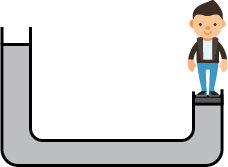
Velocity of flow of water in a horizontal pipe is $$10.0\ m\ s^ {-1}$$. Find the velocity-head of water. $$(g=10.00\ ms^ {-2})$$
Water is flowing through a cylinderical pipe of cross-sectional area 0.09 $$\quad \pi \quad m^{ 2 }$$ at a speed of 1.0 m $$s^{ -1 }$$. If the diameter of the pipe is halved , then find the speed of the flow of water through it .
The thrust due to atmospheric pressure on us is around 15 tonne. How we withstand such a thrust?
8 Rain Drops of radius 1 mm each falling down of Terminal velocity 5 m/s Combine to from a bigger drop. find the Terminal velocity of bigger drop .
A cemented wall of thickness one metre can withstand a side pressure of $${ 10 }^{ 5 }{ Nm }^{ -2 }$$. What should be the thickness of the side wall at the bottom of a water dam of depth 100 m.take density of water =$${ 10 }^{ 3 }{ kg\quad m }^{ -3 }$$ and g= $$9.8{ ms }^{ -2 }$$
Calculate total energy per unit mass possessed by water at a point where the pressure is $$0.1 \times 10^5 \ N/m^2$$ , velocity 0.02 m/s and height of water level from the ground is 10 cm. (Density of water = $$1000 \ kg/m^3 , \ g= 9.8 \ m/s^2$$).
The contact angle between water and glass is $$0^o$$. When water is poured in a glass to the maximum of its capacity, the water surface is convex upward. The angle of contact in such a situation is more than $$90^o$$. Explain.
In a vessel is a liquid, density of which increases with depth $$y$$ from its surface according to the law $$\rho ={ \rho }_{ 0 }+ky$$, where $${ \rho }_{ 0 } = 1.0 g/cm^3$$ and $$k = 0.01 g/cm^4$$. Two balls connected with an inextensible thread of length $$15 cm$$ are dropped in the liquid. Volume of each ball is $$1.0 cm^3$$ and their masses are $$1.2 g$$ and $$1.4 g$$. At what depth will these balls settle in equilibrium?
A pipe of uniform cross-section is used to siphon an ideal fluid of density $$\rho$$ from one tank to another, as shown below. The lower end of the pipe is above the liquid level in the receiving tank. If the atmospheric pressure is $$P_{a}$$, find (a) the speed of the fluid as it passes through the pipe; (b) the pressure of the fluid at points $$1,2,3,4$$ and $$5$$. (The value of $$P_{a}$$ is essentially the same at the both ends of the pipe).
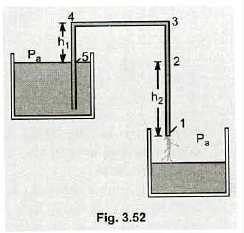
A cylindrical bucket of liquid (density $$\rho$$) is rotated about its symmetry axis, which is vertical. If the angular velocity is $$\omega $$, show that the pressure at a distance $$r$$ from the rotation axis is
$$P = P_0 +\dfrac {1}{2} \rho \omega^2 r^2$$,
where $$P_0$$ is the pressure at $$r=0$$,
In working out his principle, Pascal showed dramatically how force can be multiplied with fluid pressure. He placed a long thin tube of $$0.30\ cm$$ radius vertically into a $$20\ cm$$ radius wine barrel. He found that when the barrel was filled with water and the tube filled to a height of $$12\ cm$$, the barrel burst. Calculate
The mass of fluid in the tube.

Sketch in Fig $$3.61$$ is a thin walled tank having a small circular hole of area $$A_{1}$$ in its side. As you can see from the sketch, the cross-sectional area of the water jet emerging from the hole does not have constant area $$A_{1}$$ because this would require the streamlines to have sharp kinks in them where they pass through the hole. Instead the cross-sectional area of the jet diminishes for some distance after the jet leaves the hole. The area attains a minimum value $$A_{2}$$ where the streamlines are essentially parallel to one another. The location is called the vena contracta (Latin for narrow conduit). A detailed analysis is very difficult, even for the simplest case of circular hole in a thin plate. But, for this case, the result is $$A_{2}=\pi/(2+\pi)=0.611\ A_{1}$$. If the hole is circular with radius $$1.20\ cm$$ and the depth of the hole below the water surface is $$2.5\ m$$, what is the volume flux $$dV/dt$$ through the hole?
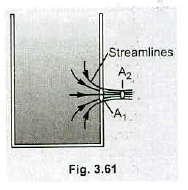
The device shown in Fig $$3.60$$ can be used as flowmeter. The horizontal man pipe has a cross-sectional area $$A_{1}$$ except at the constriction where the area is $$A_{2}$$. When an ideal fluid flows through the main pipe, there is a difference $$H$$ in the fluid levels in the two small vertical standpipes (a) Show that the flow speed $$v_{1}$$ at any point in the main pipe except at the constriction is
$$v_{1}=\dfrac{\sqrt{2gh}}{\sqrt{\dfrac{A_{1}^{2}}{A_{2}^{2}}}-1}=\dfrac{A_{2}}{\sqrt{A_{1}^{2}-A_{2}^{2}}}\sqrt{2gh}$$
(b) Show that the volume flux in the main pipe is
$$\dfrac{dV}{dt}=\dfrac{A_{1}A_{2}}{\sqrt{A_{1}^{2}-A_{2}^{2}}}\sqrt{2gh}$$
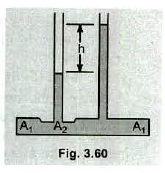
The liquid-filled tank illustrated in Fig $$3.65$$ has a drain of radius $$R_{1}$$ at the bottom. The drain is covered with a large circular plate of radius $$R_{2}$$, with $$R_{2}>>R_{1}$$. The space between the plate and the bottom of the tank is quite narrow, so the drain does not fill with liquid. Show that the pressure in the space between the plate and the bottom of the tank is
$$P=P_{atm}+\rho gh\left(1-\dfrac{R_{1}^{2}}{r^{2}}\right)$$
where $$r$$ is the distance from the axis of the drain $$(R_{1}<r<R_{2}), h$$ is the depth of the liquid in the tank, and $$\rho$$ the density of the liquid.
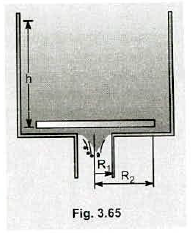
A Pitot tube can be used to determine the velocity of air flow by measuring the difference between the total pressure and the static pressure (Fig: $$3.54$$). If the fluid in the tube is mercury, whose density is $$\rho_{Hg}=13600\ kg/m^{3}$$, and if $$\Delta h=5.00\ cm$$, find the speed to air flow. (Assume that the air is stagnant at point $$A$$, and take $$\rho_{air}=1.2\ kg/m^{3}$$)
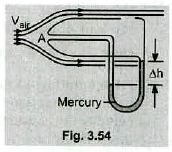
A siphon is used to drain water from a tank,as illustrated in Fig $$3.58$$. The siphon has a uniform diameter. Assume steady flow without friction (a) If the distance $$h=1.00\ m$$, find the speed of outflow at the end of the siphon (b) What is the limitation on the height of the top of the siphon above the water surface> (For the flow of liquid to be continuous the pressure must not drop below the vapour pressure of the liquid.)
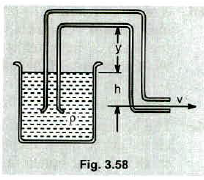
In 1654 Otto von Guericke, inventor of the air pump, gave a
demonstration before the noble-men of the Holy Roman Empire in
which two teams of eight horses could not pull apart two evacuated brass hemispheres. (a) Assuming the hemispheres have (strong) thin walls so that R in Figure may be considered both the inside and outside radius, show that the force required to pull apart
the hemispheres has magnitude $$F=\pi R^2 \vartriangle p$$, where $$\vartriangle p$$ is the difference between the pressures outside and inside the sphere.
(b) Taking R as 30 cm, the inside pressure as 0.10 atm, and the outside pressure as 1.00 atm, find the force magnitude the teams of
horses would have had to exert to pull apart the hemispheres. (c) Explain why one team of horses could have proved the point just as well if the hemispheres were attached to a sturdy wall.

An airplane has a mass of $$1.60\times 10^{4}\ kg$$ and each wing has an area of $$40.0\ m^{2}$$. During level flight the pressure on the lower wing surface is $$7.00\times 10^{4}\ Pa$$. Determine the pressure on the upper wing surface.
The bends during flight. Anyone who scuba dives are advised not to fly within the next $$24\hspace{0.05cm} h$$ because the air mixture for diving can introduce nitrogen to the bloodstream. Without allowing the nitrogen to come out of solution slowly, any sudden air-pressure reduction (such as during aeroplane ascent) can result in the nitrogen forming bubbles in the blood, creating the bends, which can be painful and even fatal. Military special operations forces are especially at risk. What is the change in pressure on such a special-op soldier who must scuba dive at a depth of $$20\hspace{0.05cm} min$$ seawater one day and parachute at an altitude of $$7.6\hspace{0.05cm}km$$ the next day? Assume that the average air density within the altitude range is $$0.87\hspace{0.05cm}kg/m^3$$
Two cylindrical vessels fitted with pistons A and B area of cross section $$ 8 cm^{2}$$ and $$320 cm^{2}$$ respectively, are joined at their bottom by a tube and they are completely filled with water. When a mass of 4 kg is placed on piston A,find
the thrust on piston B,
Two cylindrical vessels fitted with pistons A and B area of cross section $$ 8 cm^{2}$$ and $$320 cm^{2}$$ respectively, are joined at their bottom by a tube and they are completely filled with water. When a mass of 4 kg is placed on piston A,find
the pressure on piston A,
A block of iron of mass 7.5 kg and of dimensions 12cm $$12cm \times 8cm \times 10cm$$ is kept on a table top on its base of side $$12cm \times 8cm$$. Calculate :
pressure exerted on the table top. Take 1kgf = 10N.
Figure shows a brick of weight $$ 2 kgf $$ and dimensions $$ 20 cm \times 10 cm \times 5 cm $$ placed in three different positions on the ground . find the pressure exerted by the brick in each case.
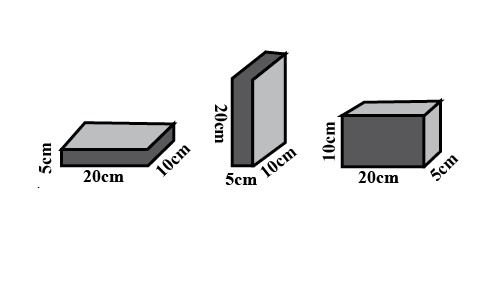
A pitot tube is used to determine the air-speed of an airplane. It consists of an outer tube with a number of
small holes B (four are shown) that allow air into the tube; that tube is connected to one arm of a U-tube. The other arm of the U-tube is connected to hole A at the front end of the device, which points in the direction the plane is headed. At A the air becomes
stagnant so that $$v_{A}=0$$. At B, however, the speed of air presumably equals the airspeed $$v$$ of the plane (a) Use Bernoullis equation
to show that $$v=\sqrt{\dfrac{2\rho gh}{\rho_{air}}}$$, where $$\rho$$ is the density of the liquid in the U-tube and $$h$$ is the difference in the liquid levels in that tube.
(b) Suppose that the tube contains alcohol and level difference $$h$$ is 26.0 cm. What is the plane's speed relative to the air? The density of the air is $$1.03\hspace{0.05cm}kg/m^3$$ and that of alcohol is $$810\hspace{0.05cm} kg/m^3$$
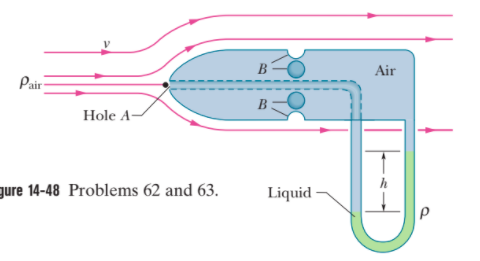
Two cylindrical vessels fitted with pistons A and B area of cross section $$ 8 cm^{2}$$ and $$320 cm^{2}$$ respectively, are joined at their bottom by a tube and they are completely filled with water. When a mass of 4 kg is placed on piston A,find
the pressure on piston B,
A tank is filled with water to a height H. At a depth h from the free surface, a hole is made so that the water comes out of it. What is the velocity of efflux? Also, what are the maximum range and the position of the hole for the same? Find the time taken by a water molecule to reach the ground. Determine the horizontal length covered by the molecule.
What should be the ratio of area of cross section of the master cylinder and wheel cylinder of a hydraulic brake so that a force of 15N can be obtained at each of its brake show exerting a force of 0.5N on the pedal?
Why is the following situation impossible? Figure shows Superman attempting to drink cold water through a straw of length $$\ell=12.0\ m$$. The walls of the tabular straw are very strong and do not collapse. With his great strength, he achieves maximum possible suction and enjoys drinking the cold water.

Blaise Pascal duplicated Torricelli's barometer using a red Bordeaux wine, of density $$984\ kg.m^3$$, as the working liquid.
Would you expect the vacuum above the column to be as good as for mercury ?
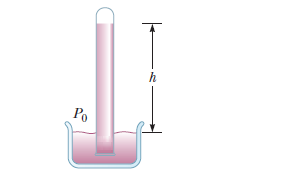
A jet plane having a cabin of length $$l-50\ m$$ flies along the horizontal with an acceleration $$a=1 \
m/s^2$$ The air density in the cabin is $$\rho=1.2 \times 10^{-3}\ g/cm^3$$
What is the difference between the atmospheric pressure and the air pressure exerted on the ears of the passengers sitting in the front, middle, and rear parts of the cabin?
Normal atmospheric pressure is $$1.013 \times 10^5\ Pa$$. The approach of a storm causes the height of a mercury barometer to drop by $$20.0\ mm$$ from the normal height. What is the atmospheric pressure?
Find the free energy of the surface layer of
(a) a mercury droplet of diameter $$d = 1 4 \ mm$$;
(b) a soap bubble of diameter $$d = 6.0 \ mm$$ if the surface tension of the soap water solution is equal to $$\alpha = 45 \ mN/m$$.
Calculate the absolute pressure at the bottom of a freshwater lake at a point whose depth is $$27.5\ m$$. Assume the density of the water is $$1.00 \times 10^3 \ kg/m^3$$ and that the air above is at a pressure of $$101.3\ kPa$$.
A container is filled to a depth of $$20.0\ c$$ with water. On top of the water floats a $$30.0-cm$$-thick layer of oil with specific gravity $$0.700$$. What is the absolute pressure at the bottom of the container?
A child loves to watch as you fill a transparent plastic bottle with shampoo (Fig above). Every horizontal cross section of the bottle is circular, but the diameters of the circles have different values. You pour the brightly colored shampoo into the bottle at a constant rate of $$16.5 cm^{3}/s$$. At what rate is its level in the bottle rising (a) at a point where the diameter of the bottle is $$6.30 cm$$ and (b) at a point where the diameter is $$1.35 cm$$?
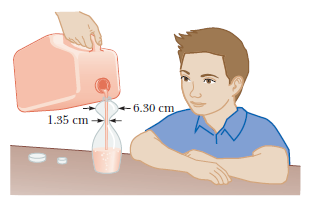
Blaise Pascal duplicated Torricelli's barometer using a red Bordeaux wine, of density $$984\ kg.m^3$$, as the working liquid.
What was the height $$h$$ of the wine column for normal atmospheric pressure?
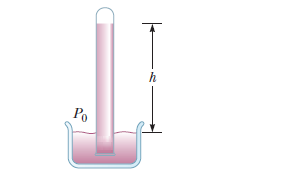
Bring the ends X and to the same level. Place a slotted weight of $$1N (100 gwt)$$ at the end of X. What happens at the end Y?
A large storage tank, open at the top and filled with water, develops a small hole in its side at a point $$16.0\ m$$ below the water level. The rate of flow from the leak is found to be $$2.50\times 10^{-3}\ m^3/ min$$. Determine the diameter of the hole.
A tank with a flat bottom of area $$A$$ and vertical sides is filled to a depth $$h$$ with water. The pressure is $$P_0$$ at the top surface.
What is the absolute pressure at the bottom of the tank?
Figure shows a stream of water in steady flow from a kitchen faucet. At the faucet, the diameter of the stream is $$0.960\ cm$$. The stream fills a $$125-cm^3$$ container in $$16.3\ s$$. Find the diameter of the stream $$13.0\ cm$$ below the opening of the faucet.
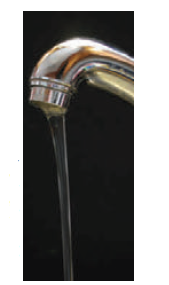
Water moves through a constricted pipe in steady, ideal flow. At the lower point shown in the figure, the pressure is $$P_1=1.75 \times 10^4\ Pa$$ and the pipe diameter is $$6.00\ cm$$. At another point $$y=0.250\ m$$ higher, the pressure is $$P_2=1.20\times 10^4\ Pa$$ and the pipe diameter is $$3.00\ cm$$. Find the volume flow rate through the pipe.
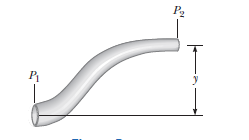
A light balloon is filled with $$400\ m^3$$ of helium at atmospheric pressure.
At $$0^oC$$, the balloon can lift a payload of what mass ?
A backyard swimming pool with a circular base of diameter $$6.00\ m$$ is filled to depth $$1.50\ m$$.
Two persons with combined mass $$150\ kg$$ enter the pool and float quietly there. No water overflows. Find the pressure increase at the bottom of the pool after they enter the pool and float.
Water moves through a constricted pipe in steady, ideal flow. At the lower point shown in the figure, the pressure is $$P_1=1.75 \times 10^4\ Pa$$ and the pipe diameter is $$6.00\ cm$$. At another point $$y=0.250\ m$$ higher, the pressure is $$P_2=1.20\times 10^4\ Pa$$ and the pipe diameter is $$3.00\ cm$$. Find the speed of flow in the upper section.
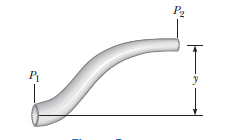
Water flowing through a garden hose of diameter $$2.74\ cm$$ fills a $$25-L$$ bucket in $$1.50\ min$$.
What is the speed of the water leaving the end of the hose?
A tank with a flat bottom of area $$A$$ and vertical sides is filled to a depth $$h$$ with water. The pressure is $$P_0$$ at the top surface.
Suppose an object of mass $$M$$ and density less than the density of water is placed into the tank and floats. Now overflows. What is the resulting increase in pressure at the bottom of the tank?
A large storage tank, open at the top and filled with water, develops a small hole in its side at a point $$16.0\ m$$ below the water level. The rate of flow from the leak is found to be $$2.50\times 10^{-3}\ m^3/ min$$. Determine the speed at which the water leaves the hole and the diameter of the hole.
In ideal flow, a liquid of density $$850\ kg/m^3$$ moves from a horizontal tube of radius $$1.00\ cm$$ into a second horizontal tube of radius $$0.500\ cm$$ at the same elevation as the first tube. The pressure differs by $$\Delta P$$ between the liquid in one tube and the liquid in the second tube. Evaluate the volume flow rate for $$\Delta P=12.0\ kPa$$.
In ideal flow, a liquid of density $$850\ kg/m^3$$ moves from a horizontal tube of radius $$1.00\ cm$$ into a second horizontal tube of radius $$0.500\ cm$$ at the same elevation as the first tube. The pressure differs by $$\Delta P$$ between the liquid in one tube and the liquid in the second tube. Evaluate the volume flow rate for $$\Delta P=6.00\ kPa$$
The Venturi tube discussed in example and shown in figure may be used as a fluid flowmeter. Suppose the device is used at a service station to measure the flow rate gasoline $$( \rho =7.00 \times 10^2\ kg/m^3)$$ through a hose having an outlet radius of $$1.20\ cm$$. If the difference in pressure is measured to be $$P_1 -P_2=1.20\ kPa$$ and the radius of the inlet tube to the meter is $$2.40\ cm$$, find the fluid flow rate in cubic meters per second.
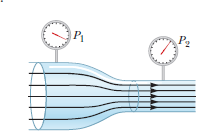
An airplane has a mass of $$1.60\times 10^{4}kg$$, and each wing has an area of $$40.0\ m^{2}$$. During level flightly, the pressure on the lower wing surface is $$7.00\times 10^{4}Pa$$
Suppose the lift on the airplane were due to a pressure difference alone. Determine the pressure on the upper wing surface.
In ideal flow, a liquid of density $$850\ kg/m^3$$ moves from a horizontal tube of radius $$1.00\ cm$$ into a second horizontal tube of radius $$0.500\ cm$$ at the same elevation as the first tube. The pressure differs by $$\Delta P$$ between the liquid in one tube and the liquid in the second tube. Find the volume flow rate as a function of $$\Delta P$$.
A village maintains a large tank with an open top, containing water for emergencies. The water can drain from the tank through a hose of diameter $$6.60\ cm$$. The hose ends with a nozzle of diameter $$2.20\ cm$$. A rubber stopper is inserted into the nozzle. The water level in the tank is kept $$7.50\ m$$ above the nozzle.Calculate the gauge pressure of the flowing water in the hose just behind the nozzle.
The Venturi tube discussed in example and shown in figure may be used as a fluid flowmeter. Suppose the device is used at a service station to measure the flow rate gasoline $$( \rho =7.00 \times 10^2\ kg/m^3)$$ through a hose having an outlet radius of $$1.20\ cm$$. If the difference in pressure is measured to be $$P_1 -P_2=1.20\ kPa$$ and the radius of the inlet tube to the meter is $$2.40\ cm$$, find the speed of the gasoline as it leaves the hose.
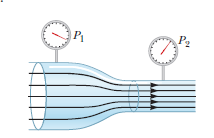
What if? Model the rising stream as an ideal fluid in streamline flow. Use Bernoulli's equation to determine the speed of the water as it leaves ground. How does the answer from part (a) compare with the answer from part (b)?
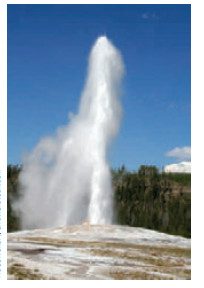
What if? Model the rising stream as an ideal fluid in streamline flow. Use Bernoulli's equation to determine the speed of the water as it leaves ground. What is the pressure ( above atmospheric ) in the heated underground chamber if its depth is $$175\ m$$? Assume the chamber is large compared with the geyser's vent.
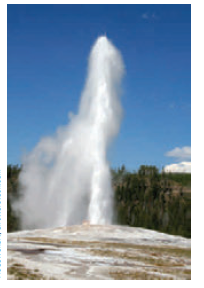
A village maintains a large tank with an open top, containing water for emergencies. The water can drain from the tank through a hose of diameter $$6.60\ cm$$. The hose ends with a nozzle of diameter $$2.20\ cm$$. A rubber stopper is inserted into the nozzle. The water level in the tank is kept $$7.50\ m$$ above the nozzle. The stopper is removed. What mass of water flows from the nozzle in $$2.00\ h$$?
A siphon is used to drain water from a tank as illustrated in Figure $$P14.53$$. Assume steady flow without friction.
What If? What is the limitation on the height of the top of the siphon above the end of the siphon?
Note: For the flow of the liquid to be continuous, its pressure must not drop below its vapor pressure. Assume the water is at $$20.0^{o}C$$, at which the vapor pressure is $$2.3\ k\ Pa$$.
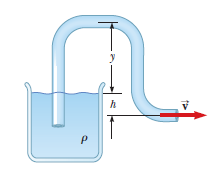
Calculate the absolute pressure at an ocean depth of $$1\ 000\ m$$. Assume the density of seawater is $$1\ 030\ kg/m^3$$ and the air above exerts a pressure of $$101.3\ kPa$$.
In a water pistol, a piston drives water through a large tube of area $$A_1$$ into a smaller tube of area $$A_2$$ as shown in Figure $$P14.78$$. The radius of the large tube is $$1.00\ cm$$ and that of the small tube is $$1.00\ mm$$. The smaller tube is $$3.00\ cm$$ above the larger tube.
What is the pressure at the nozzle?
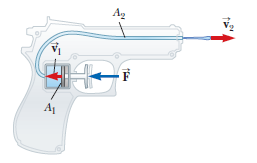
In a water pistol, a piston drives water through a large tube of area $$A_1$$ into a smaller tube of area $$A_2$$ as shown in Figure $$P14.78$$. The radius of the large tube is $$1.00\ cm$$ and that of the small tube is $$1.00\ mm$$. The smaller tube is $$3.00\ cm$$ above the larger tube.
If the desired range of the stream is $$8.00\ m$$, with what speed $$v_2$$ must the stream leave the nozzle?
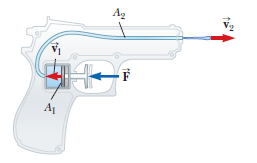
A siphon is used to drain water from a tank as illustrated in Figure $$P14.53$$. Assume steady flow without friction.
If $$h=1.00\ m$$, find the speed of outflow at the end of the siphon.
Note: For the flow of the liquid to be continuous, its pressure must not drop below its vapor pressure. Assume the water is at $$20.0^{o}C$$, at which the vapor pressure is $$2.3\ k\ Pa$$.
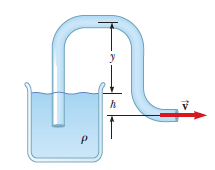
Water is forced out of a fire extinguisher by air pressure as shown in Figure $$P14.63$$. How much gauge air pressure in the tank is required for the water jet to have a speed of $$30.0\ m/s$$ when the water level is $$0.500\ m$$ below the nozzle?
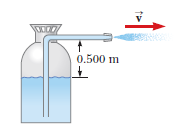
Figure $$P14.61$$ shows a value separating a reservoir from a water tank. If this valve is opened. what is the maximum height above point $$B$$ attained by the water stream coming out of the right side of the tank? Assume $$h=10.0\ m, L=2.00\ m$$, and $$\theta=30.0^{o}$$, and assume the cross-sectional area at $$A$$ is very large compared with that at $$B$$.
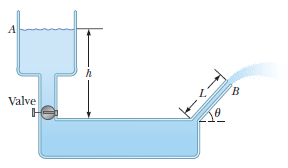
In a water pistol, a piston drives water through a large tube of area $$A_1$$ into a smaller tube of area $$A_2$$ as shown in Figure $$P14.78$$. The radius of the large tube is $$1.00\ cm$$ and that of the small tube is $$1.00\ mm$$. The smaller tube is $$3.00\ cm$$ above the larger tube.
If the pistol is fired horizontally at a height of $$1.50\ m$$, determine the time interval required for the water to travel from the nozzle to the ground. Neglect air resistance and assume atmospheric pressure is $$1.00\ atm$$.
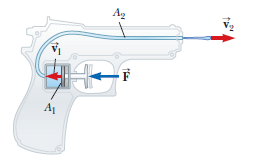
The Bernoulli effect can have important consequences for the design of buildings. For example, wind can blow around a skyscraper at remarkably high speed, creating low pressure. The higher atmospheric pressure in the still air inside the buildings can cause windows to pop out. As originally constructed, the John Hancock Building in Boston popped windowpanes that fell many stories to the sidewalk below.
What If? If a second skyscraper is built nearby, the airspeed can be especially high where wind passes through the narrow separation between the buildings. Solve part (a) again with a wind speed of $$22.4\ m/s$$, twice as high.
A helium-filled balloon (whose envelope has a mass of $$m_{b}=0.250\ kg$$) is tied to a uniform string of length $$l=2.00\ m$$ and mass $$m=0.050.0\ kg$$. The balloon is spherical with a radius of $$r=0.400\ m$$. When released in air of temperature $$20^{o}C$$ and density $$\rho_{air}=1.20\ kg/m^{3}$$, it lifts a length $$h$$ of string and then remains stationary as shown in Figure $$P14.60$$. We wish to find the length of string lifted by the balloon.
Find the length $$h$$ numerically.
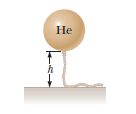
Show that the variation of atmospheric pressure with altitude is given by $$P=P_{0}e^{-\alpha y}$$, where $$\alpha=\rho_{0}g/P_{0}, P_{0}$$ is atmospheric pressure at some reference level $$y=0$$, and $$\rho_0$$ is the atmospheric density at this level. Assume the decrease in atmospheric pressure over an infinitesimal change in altitude (so that the density is approximately uniform over the infinitesimal change) can be expressed from Equation $$14.4$$ as $$dP = -\rho g\ dy$$. Also assume the density of air is proportional to the pressure, which, as we will see in Chapter $$ 20$$, is equivalent to assuming the temperature of the air is the same at all altitudes.
In a water pistol, a piston drives water through a large tube of area $$A_1$$ into a smaller tube of area $$A_2$$ as shown in Figure $$P14.78$$. The radius of the large tube is $$1.00\ cm$$ and that of the small tube is $$1.00\ mm$$. The smaller tube is $$3.00\ cm$$ above the larger tube.
Find the pressure needed in the larger tube.
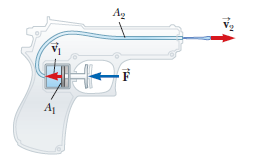
The water supply of a building is fed through a main pipe $$6.00\ cm$$ in diameter. A $$2.00-cm$$ diameter faucet tap, located $$2.00\ m$$ above the main pipe, is observed to fill a $$25.0-L$$ container in $$30.0\ s$$.
What is the speed at which the water leaves the faucet?
Class 11 Engineering Physics Extra Questions
- Gravitation Extra Questions
- Kinetic Theory Extra Questions
- Laws Of Motion Extra Questions
- Mechanical Properties Of Fluids Extra Questions
- Mechanical Properties Of Solids Extra Questions
- Motion In A Plane Extra Questions
- Motion In A Straight Line Extra Questions
- Oscillations Extra Questions
- Physical World Extra Questions
- Systems Of Particles And Rotational Motion Extra Questions
- Thermal Properties Of Matter Extra Questions
- Units And Measurement Extra Questions
- Waves Extra Questions
- Work,Energy And Power Extra Questions

